Works
Works
A list of works. Heavily under construction. Slowly filling in as of 2022-03-02.
- ---------------------------------–—
- Artistic / Research Projects
- ---------------------------------–—]
- Performances
- Io, frammento dal Prometeo - Luigi Nono
- End of Text - ETX001
- agent 1
- Crosstalks
- IGNM @ prattica E
- Außer der Serie – useless machine # / martim-pescador #
- duo Diegert / Pirrò
- Audible Ecosystemics - signale graz 1010
- Körper
- Bodyscapes
- Complexity and Complication
- Lebendige Elektronik: signale graz 11000
- Speculative Sound Synthesis: Synchronisation
- Speculative Sound Synthesis - Lecture Performance
- On Traces
- die verbindung wird gehalten
- Every Move a Sound
- useless machine - series
- altraconsonanza
- Stessa Dissonanza
- BodyscapescorpoPhonolux
- Four Room Concert
- _
- ---------------------------------–—
- Pieces & Installations
- Through Segments
- Speaker matrix
- Jackfield
- Imperfect Reconstruction
- Reconfigurations
- Hypercolumns
- the K of X
- Contingency and Synchronization
- The Illusion of Simultaneity
- Transpositions: Data Rush
- Computational Studies of Entanglement
- The Metaboliser
- in|filtration
- Staircase
- Inner Space
- Datenhörraum/data listening space
- Interstices
- Rebody
- Zwischenräume
- Tball
- cornerghostaxis#1
- Chorea Saligia
- _
- ---------------------------------–—
- Presentations
- ---------------------------------–—
- Workshops / Symposia / Conferences
- ALMAT - at Impuls Academy 2019
- ALMAT - at Impuls Academy 2017
- Thresholds of the Algorithmic
- Algorithmic Spaces
- Speculative Sound Synthesis Workshop - Impuls 2025
- Speculative Sound Synthesis Workshop - Sonology Den Haag 2024
- Threading Time Masterclass
- Simulation and Computer Experimentation in Music and Sound Art
- Performative Computer Music Practice and Exchange
- Composing Spatial Instruments
- _
- ---------------------------------–—
- Publications
- Composing Interactions
- Imperfect Reconstruction: an algorithmic project
- Anemone Actiniaria xCoAx
- Stop challenging technology! Towards content-based audio production
- Where Sounds Dwell
- Space is Algorithm
- Zwischenräume – A Case Study in the Evaluation of Interactive Sound Installations
- Waveguides for model-based sonification
- Sounds of simulations: data listening space
- Acoustic Interface For Tremor Analysis
- Exploring Sound and Spatialization Design on Speaker Arrays using Physical Modelling
- A Framework for the Choreography of Sound
- Physical modelling enabling enaction: an example
- A sonic time projection chamber, Sonified particle detection at CERN
- Spin quartets, sonification of the XY model
- PhysioSonic - Evaluated Movement Sonification as Auditory Feedback in Physiotherapy
- Quantum Harmonic Oscillator Sonification
- Motion-Enabled Live Electronics
- On Artistic Research in the Context of the Project Embodied Generative Music
- Towards a multi-layer architecture for multi-modal rendering of expressive actions.
- _
- ---------------------------------–—
- Interviews
- _
- ---------------------------------–—
henri
Programming Language
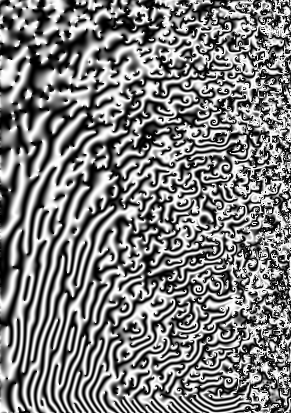
henri programming language I'm developing and using in my Live-Electronic performances. henri is an experimental programming language, developed using the LLVM compiler infrastructure (https://llvm.org/), and originates mainly from my artistic practice. henri is a programming language designed specifically for the formulation and execution of dynamical systems (in the form of systems of ordinary differential equations) using a variable-order symplectic integrator. Dynamical systems programmed in henri are simulated (integrated) in audio rate and thus can be used directly for sound synthesis.
The Choreography of Sound
Artistic Research Project
Ramón González-Arroyo, Gerhard Eckel, Martin Rumori, and David Pirrò
"The Choreography of Sound (CoS) is a project about the spatial in music, addressing in particular the domain of electroacoustic music. In contrast to acoustic sound, with its properties causally deriving from its origin and in which space is embedded in its nature, synthetic sound has no inherent properties, spatial or otherwise, and can be composed as a formal construct, with temporal and spatial properties opened to the imagination and the skills of its constructor.
In our approach sound is conceived including a spatial dimension. The sonic object has spatial extension, ideally suggesting the perception of dwelling in space. This perception, however, is not a direct and easy matter with which one can count for granted, quite on the contrary, it is our conviction that this goal will only be achieved through the collaborative action of compositional, scientific and technological forces. We are searching for the emergence of a perception of materiality of synthetic sound matter: the illusion of a sound object with the corporality of a plastic object. A change of perspective with consequences not to be underestimated in the conception of the composition of music."
A Framework for the Choreography of Sound
Publication
Eckel, Gerhard and Rumori, Martin and Pirrò, David and González-Arroyo, Ramón
Proceedings of the 38th International Computer Music Conference, ICMC 2012
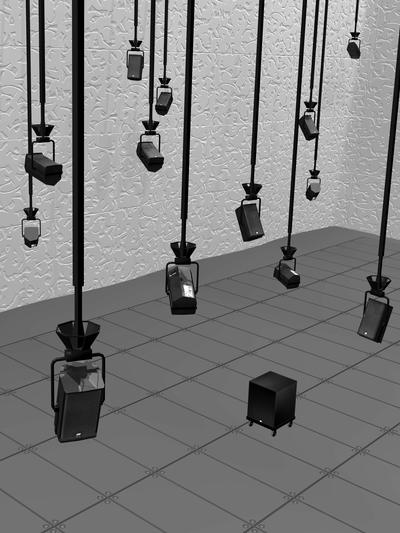
A framework developed in the context of the artistic research project The Choreography of Sound is presented. The project aims at furthering the practice of electroacoustic composition, especially with respect to the spatial in this genre. The general approach of the project is introduced as a basis for presenting the design of the framework. Its main components are described and the motivations for their design are explained. The framework comprises various tools to formulate spatial aspects of compositional ideas in heterogeneous ways (geometrically, as dynamic systems, and as objects composed from shared properties). Existing spatialisation techniques can be integrated in the framework and exposed to compositional control, such as to allow for unorthodox combinations of them as well as articulating them with other levels of composition. Visualisation and auralisation components allow for sensible work off-site in the otherwise very site-specific project. The CoS software framework is conceived as extensions to the SuperCollider audio programming environment.
Speculative Sound Synthesis
Artistic Research Project
Speculative Sound Synthesis is an artistic research project that deals with the relationship between technology and artistic thinking in computer music. In doing so, it attempts to productively destabilize this relationship by artistically questioning the standards of digital sound synthesis.
The idea of speculation is central to this project, both methodogically as well as aesthetically. Speculation concerns the how, what, and the why of this project, its methods and its objectives. For the team, speculation does not refer to unfounded conjecture or purely theoretical thought removed from concrete practice or experience. On the contrary, speculation can be understood as situated oscillation between experience and imagination that is characteristic of processes that bring forth new forms of knowledge. The project is seen as an attempt to release aesthetic potentials of sound synthesis for artistic practice that would otherwise remain unknown, concealed by standard technological gestures. In this sense, speculation is capable of overcoming inductive or deductive processes and able to dynamize the interrelation of technology and aesthetics.
Speculative Sound Synthesis has started in November 2022 and will end in October 2025. The project is funded by the Austrian Science Fund (FWF) within the Programme for Arts-based Research (PEEK) – PEEK AR 713-G. It is hosted by the Institute of Electronic Music and Acoustics (IEM) at the University of Music and Performing Arts Graz.
The project team consists of David Pirrò and Leonie Strecker. From November 2022 to October 2024, Luc Döbereiner and Ji Youn Kang were part of the project team. Luc Döbereiner was also a co-author of the initial project proposal.
Speculative Sound Synthesis: Synchronisation
Live-Electronics
Luc Döbereiner, Ji Youn Kang, David Pirrò, Leonie Strecker
Speculative Sound Synthesis: Synchronization is a live electronic perfor- mance by four interlinked players exploring ways of coupling sound synthesis systems, algorithmically, performatively, and sonically. The performance is part of the artistic research project Speculative Sound Synthesis hosted at the Institute of Electronic Music and Acous- tic in Graz. The project challenges established patterns of interaction between technology and artistic practice. Standardized processes in computer music are probed, destabilized and reshaped through speculative re-questioning, thus allowing new aesthetic potentials for experimental musical practice to emerge. Rather than focusing on making the instruments produce specific results, the performers aim to make their instruments’ material qualities, assumptions, er- rors, and even failures sensible and experienceable. By putting their instruments and their respective developers in interaction with each other, creating a feedback loop of sorts, the performance explores questions of interplay, materiality of digital and analog sound syn- thesis, interaction with algorithms and machine learning, employing combinations of nonlinear oscillators and analog circuits based on fundamental digital components. The instruments flow into each other, opening up new sonic and musical possibilities through their coupling, thus creating a laboratory where they can experiment, manipulate, observe and speculate on different aspects of the artistic practice of sound synthesis they consider crucial.
Speculative Sound Synthesis Workshop - Impuls 2025
Workshop
David Pirrò, Martin Rumori, and Leonie Strecker
23 - 28 February 2025
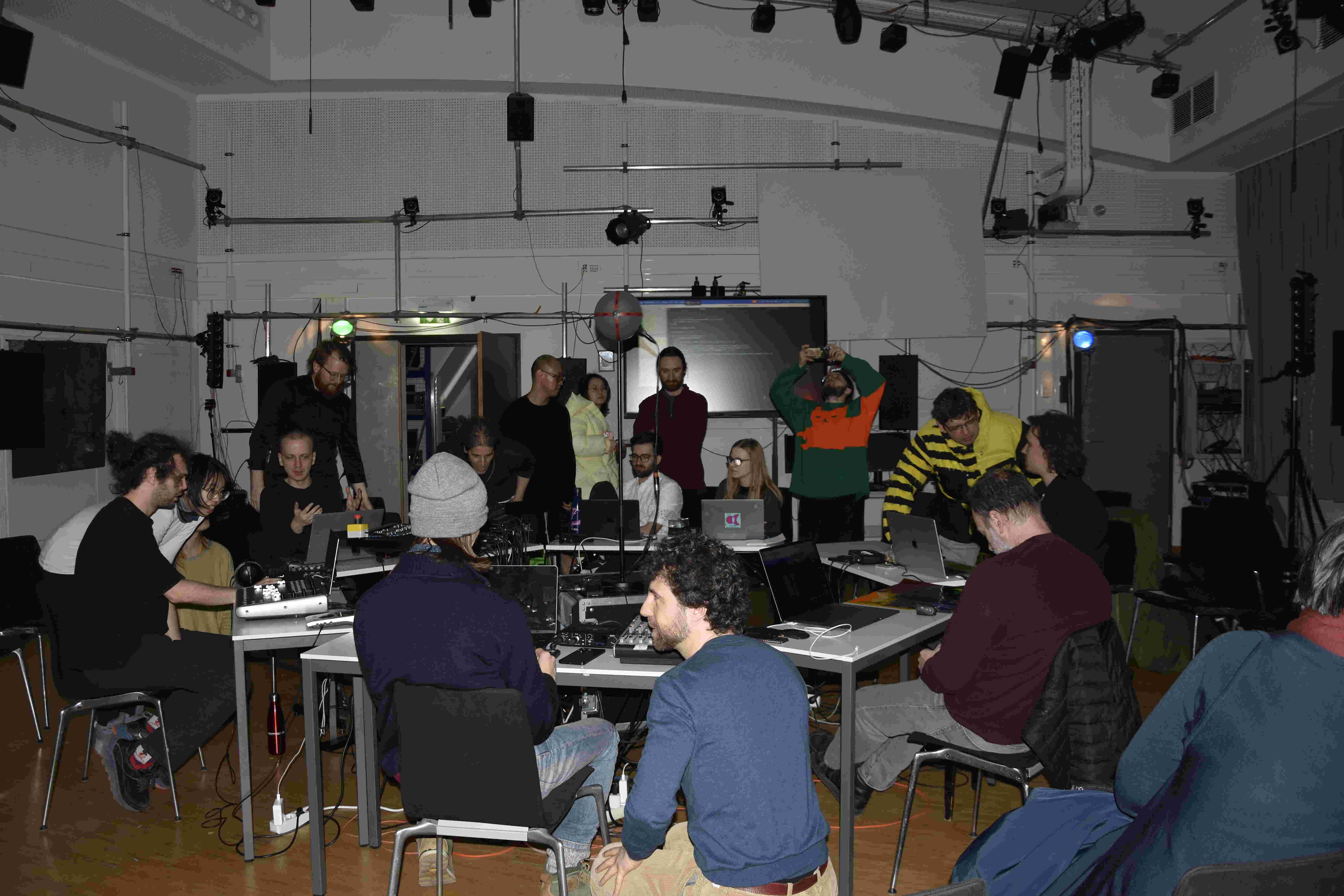
with participants of the impuls Academy 2025
Benedikt Alphart | Ted Apel | Francesco Dal Rì | Emanuele Grossi | Georgios Marentakis | Mike McCormick | Nicolas Speda | Justyna Tobera | Lars Fabian Tuchel composition, electronics
The Speculative Sound Synthesis workshop, set up at the impuls Academy 2025, is addressing sound artists, computer music composers and performers who are committed to critical, speculative approaches at the intersection of art and technology, and who are engaged in practices that question, challenge, criticize, deconstruct, recompose, reformulate, shift, dislocate, endanger or reject established standards of sound synthesis and (music) technology. The workshop is part of the artistic research project “Speculative Sound Synthesis”. The aim of the project is to rethink and recompose the relationship between technology and artistic practice in an attempt to unleash aesthetic potentials of sound synthesis that would otherwise remain unknown or hidden within the technological apparatus. In this aesthetic destabilization of analog and digital sound technologies, speculation is the primary method.
During the workshop, each participant developed their own speculative instrument. As a further step, different approaches towards opening up the instruments for receiving and sending sound and data from and to the other instruments were probed, to ultimately create an interconnected, shared agency when playing the instruments together.
Benedikt Alphart ’s instrument is based around a simulacrum-type “physical model” of a singing dune. Singing Dunes are a rare geophonic phenomenon, in which giant heaps of sand produce booming bass drones reaching up to 120dB in volume. The model allows him to mimic its behavior and push parameters beyond their natural range, using his custom built “Mozzarella”-controller.
Ted Apel ’s algorithm uses a spectral representation of sound to manipulate the phase spectrum of sound for unique time manipulations of other performers’ sounds. The amplitude envelope of the resultant sound is controlled by OSC messages from other instruments.
Francesco Dal Rì ’s instrument is centered around three types of feedback: acoustic, signal, and data. The main software component consists of two identical pipelines, each containing a digital multitimbral synthesizer and a neural network, trained to estimate parameters for the synthesizers to emulate input sounds. Using a hardware mixer as main control interface, the behavior of the system is influenced via multiple feedbacks approaches, achieving both stable and chaotic states.
Emanuele Grossi ’s instrument consists of a granulator with per-grain spatialization and stretched parameter possibilities meant for working with large prerecorded field recordings, in this case adapted to record material and use parameters coming from the other musicians’ instruments.
The NSFW (‘Nuther SuperCollider FrameWork’) is a software developed for highly dynamic and expressive control of digital synthesis and processing algorithms in performance. During the Speculative Sound Synthesis workshop Mike McCormick has developed a new module for the system – the NSStripRegressor – which allows him to control many modules at once through a simple interface by using a neural network to perform regression on higher dimensional parameter data.
The instrument of Georgios Marentakis couples live-camera input from a mobile phone to sound synthesized and played or streamed in real-time by the device. This is done based on a series of user-adjustable mappings that shape the timbre and the dynamics of the generated sound. The intention is to explore serendipitous sonic outcomes and emphasize them through gestural performance.
Nicholas Speda receives sound from another participants’ speculative synth and live-codes complex and chaotic effects for it to pass through. Whenever he evaluates code to make adjustments or additions to these effects, the input source switches to a new (random) participants’ synth, making it impossible to predict the outcoming sound beforehand, thus turning every modification of the code into a speculative endeavor. In addition to this, data from typing out his code (e.g. statistic of used keys) is sent out to other participants to further influence their speculative synths (e.g. use as envelopes).
Justyna Tobera ’s instrument is a sensor that reads hand gestures and processes sound, distributing it across a multichannel system. It allows for real-time interaction, where subtle movements influence the spatialization of sound. At the same time, it generates and transforms visualizations based on movement, creating a dynamic audiovisual experience.
By combining techniques from granular, concatenative, and waveset synthesis, and incorporating cutting-edge linguistics software, the speculative sound synthesis system stack named mund, created by Lars Tuchel, generates rich textures and intricate (a-)rhythmic patterns. The smallest sound elements – the grains, the waves, the phonemes – are layered and combined to reveal a voice hidden within diverse sound corpora.
Speculative Sound Synthesis Workshop - Sonology Den Haag 2024
Workshop
David Pirrò, Luc Döbereiner, Ji Youn Kang, and Leonie Streker
22 March 2024
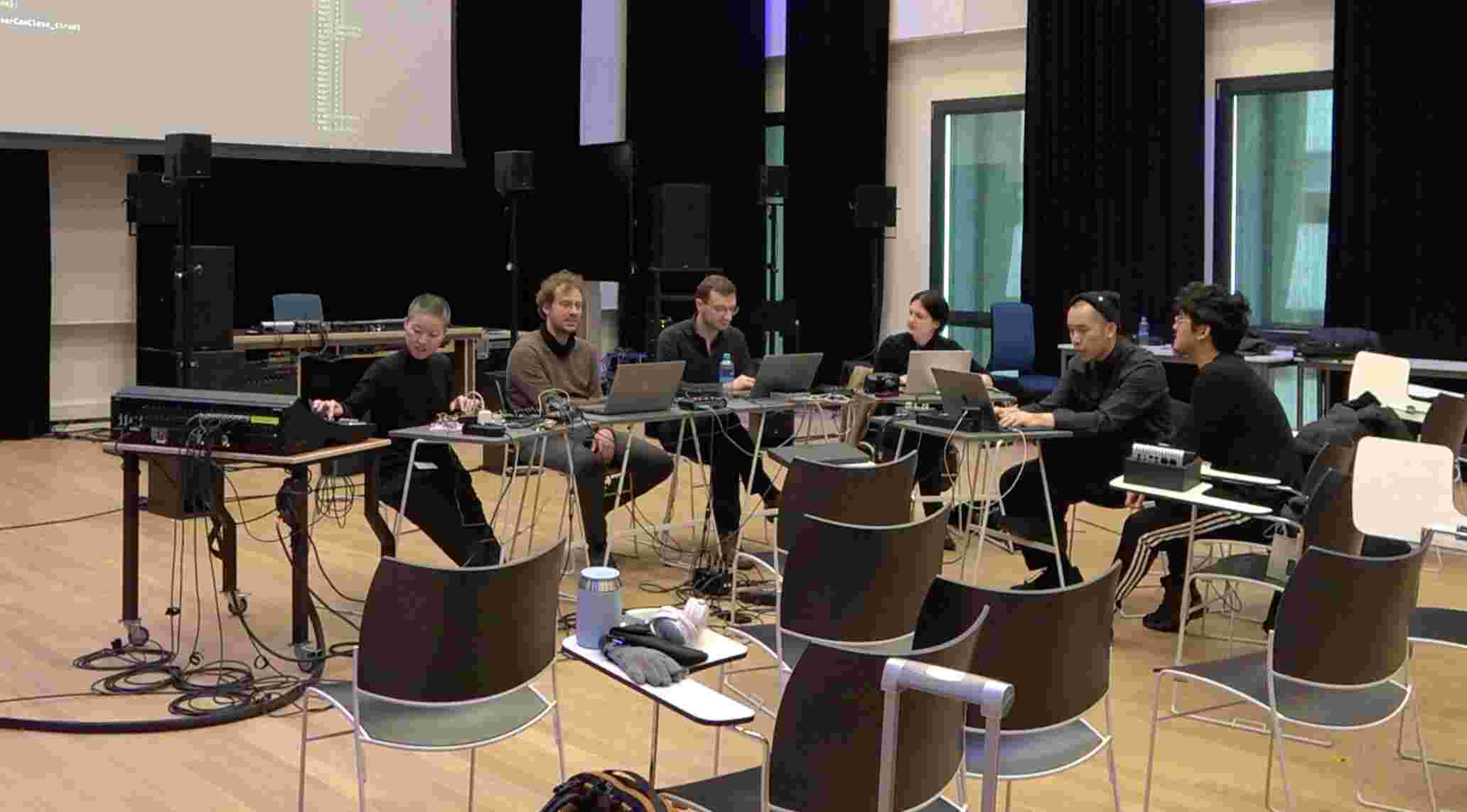
The workshop will start with the team introducing and sharing the instruments developed as part of the research project. In the following hands-on session, participants will have the opportunity to speculatively explore their own musical instruments (e.g. a block of code, a synthesis tool, an analog circuit, and/or any sounding objects) with the other participants. This practice is not only intended to facilitate exchange and experience of instruments, but also to delve into the speculations that arise when encountering new sonic possibilities. Before diving into the music, each couple of participants will pose speculative inquiries, sparking discussions on the role of speculation in the performance process.
As participants navigate the unfamiliar territory of someone else's instrument, they will uncover new layers of sonic potential and artistic expression. Through collaborative improvisation sessions, small groups will come together to share their experiences, reflecting on the ways in which speculation shapes their artistic process. The project team will guide and take part in this session as well.
Speculative Sound Synthesis - Lecture Performance
Lecture-Performance with Live-Electronics
Luc Döbereiner, Ji Youn Kang, David Pirrò, Leonie Strecker
Tuesday, 21.05.2024, 17:00, IEM CUBE
In this lecture performance, each team member shared their thoughts on the role of speculation in their artistic practice in a speculative form, navigating the landscape between aesthetics, sound, technology and methodology through a speculative lens. They each chose keywords related to their practice, thoughts or views on speculation, which were presented in a strictly timed manner. The entire lecture lasted exactly 82 minutes, including short intermissions during which music was played using interconnected synthesis systems.
Körper
Reactive Sound installation
Hanns Holger Rutz, David Pirrò

The work, a series of "modules" that can be exhibited in isolation or dialogue, explores the relationship between corporeality and the algorithmic, realised as an environmentally aware, sensitive installation combining the modalities of sound and moving image. Despite the absence of locomotion, there are perhaps complementary ways an electric body could renegotiate, with whomever it encounters, its shape and presence?
A body is not only occupying space, but it continuously reproduces space and presence in negotiation with other bodies. It thus touches upon the problem of individuality and how, as a living and not a dead body, it “presupposes a plurality of other forms in relation to it” (Canguilhem 2008 [1952], 106).
Computational process, on the other hand, can also be understood to occupy abstract spaces which are interwoven with physiological spaces. What does it mean that a body is living or alive, when we attribute corporeality to computational processes? Surely, we do not want to be trapped by the assumption that we could even remotely “model” human or animal bodies, which seems as problematic as equating computational process with disembodied brains or the mind (cf. Dreyfus 1972). Instead, what we call bodies are configurations that partially explore what bodily qualities could possibly emerge from a digital–physical assemblage, with the aim of eventually bringing these partials together and thus “fulfil” in a certain way the requisite plurality of forms.
The bodies we create and experiment with should become entities that not just passively receive and process stimuli, but that actively sound out their surroundings, ringing them out for interventions. These interventions are multi-modal, for example incorporating sound and vision, but also ultra-sound as a tactile medium. The bodies absorb and process impulses passing through their environment and emit sensible variations of responses. Instead of searching for the definite form that satisfies this criterion, the modularity is meant to allow us to implement and “prototype” ideas such that modules can be iterated over time, and iteration may also take place by accepting a “partial” module and moving forward to an additional module. In other words, the idea of the body re-enters the work as a structuring principle, allowing us to “create a body of works”, to give us space and presence to experiment.
6th Conference on Computation, Communication, Aesthetics & X, 2018, and Lydgalleriet, Bergen, NO, 2018
Crosstalks
Sound Direction and Live-Electronics
Graz/Wien 2018
Interprets:
Gobi Drab . Blockflöte Szilárd Benes . Klarinette David Pirrò . Live-Elektronik, Klangregie
Programme:
Marko Ciciliani: Tympanic Touch (2017) für 2 Instrumente, Elektronik und Videozuspielung Onur Dülger: Neues Werk (2018) für Blockflöte und Elektronik Katharina Klement: mihrab (2008/2012) für Klarinette, Blockflöte und Elektronik Matthias Kranebitter: 32bit recorder songs (2013) für Sopranblockflöte und playback Daniel Mayer: Matters 1 (2017), fixed media David Pirrò: Live-Performance Gabriele Proy: Kimochi (2009), fixed media Alexey Retinsky: Punctum Nulla (2012), fixed media Veronika Simor: Neues Werk (2018) für Klarinette und Elektronik
Contingency and Synchronization
Sound Installaion
Luc Döbereiner, David Pirrò
Orpheus Intituut, Ghent, March 21–22, 2019 Link
The installation was presented for the first time the seminar entitled Simulation and Computer Experimentation in Music and Sound Art, co-organised by the Orpheus Institute, Ghent (BE) and ALMAT.
It is based on a mathematical model used to describe synchronization, the Kuramoto model. Each loudspeaker outputs an oscillator which tries to link to another periodic input (picked up by a microphone). The installation consists of six loudspeaker-microphone couples that, in their endless process of synchronization, leave traces of sound forms over time
in|filtration
Space and Sound Installation
Hanns Holger Rutz, David Pirrò
in|filtration _ Ein|sickerung is a space and sound installation dealing with persistent and inconspicuous processes of exchange, in which surfaces and membranes between adjacent actors and systems are not only regarded as forms of dissociation, but as partially permeable layers, thus allowing imaginings, signals, materials, light and sound to propagate and melt the identities of the separate. A translucent and sensorial space/body acts as a vessel for sound structures that migrate between two seemingly opaque computer systems. The project begins with an understanding that space is a basic precondition, not just for architecture, but also for our lived environment. According to this perspective, architecture is not just about buildings filling up space, but about the production of space. The physical space is interwoven with an algorithmic space, sounding and sensing its environment. Algorithmic space is not primarily the result of form generation but of an intrinsic speculative movement and the interaction with humans who write code and experiment with it. Making visible and audible the exchange processes between humans and machines becomes a means of critically articulating this space.
A collaboration between the Master Module in Art, Science and Technology (MAST) at the Institute of Spatial Design / TU Graz, and Algorithms that Matter (Almat) at the Institute of Electronic Music and Acoustics (IEM) / KUG Graz. Exhibition esc media art lab 2020, within the parcours Algorithmic Segments - Graz Kulturjahr 2020.
Through Segments
Reactive Sound installation
Ji Youn Kang, Hanns Holger Rutz, David Pirrò and Daniele Pozzi
Through Segments is a sound installation in an unusual interstitial space—the staircase of the Kunsthaus’ Iron House that connects to the “Friendly Alien”. Four artists listen into the storeys using real-time computer algorithms, taking an acoustical image of the visitors’ movements, forming four individual reactions. It is a poetic attempt to think about the distributed, the fragmented, the parallel. During the development phase, the artists work independently, but at the same time they observe and interrogate each other, performing the gesture of a “simultaneous arrival” (Sara Ahmed). They enact a human algorithm, informed by reiteration and duplication but never being identical. The aim is not one “of all converging towards the same, but circulating, making common relaying, relaying back, being relayed” (Isabelle Stengers).
End of Text - ETX001
Live-Elektronik Performance
David Pirrò, Luc Döbereiner, Ludvig Elblaus
released May 3, 2022
Lebendige Elektronik: signale graz 11000
Sound Direction, Live-Electronics
MUMUTH, Graz, 17.03.2023
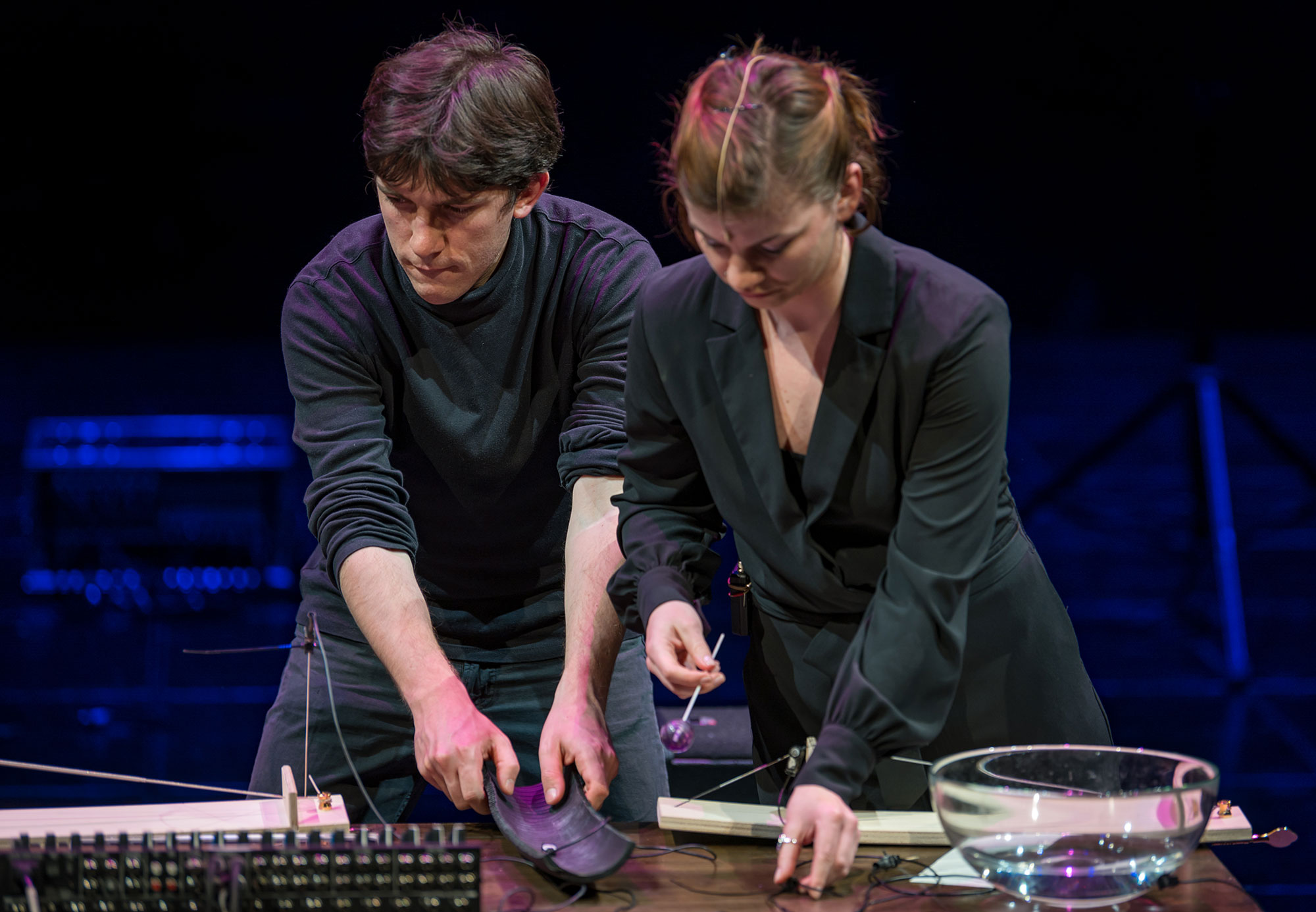
"Living Electronics" plays with the various meanings that the English term "live electronics" has assumed in music over the past 60 years. In contrast to electronic sounds pre-produced in the studio, the production and transformation of sounds in "live electronics" takes place during the performance.
The pieces selected for "Living Electronics" span a period of 40 years: from John Cage's revolutionary Cartridge Music from 1960 to Luciano Berio's refined Altra voce from 1999. In between are Steve Reich's famous Pendulum Music from 1968, Karlheinz Stockhausen's Solo for Melody Instrument and Feedback from 1966, and Alvin Lucier's mysterious and radical Music for Pure Waves, Bass Drums and Acoustic Pendulums from 1980. In addition to various forms of "live electronics," traditional acoustic instruments are used in different roles. These include the human voice (mezzo-soprano), an alto flute, a horn, and 4 bass drums. But other objects, such as record player cartridges, pendulating microphones, or ping-pong balls, also become parts of specialized musical instruments that are played in symbiosis with composed analog and digital electronic processes.
Program sequence and performers
Alvin Lucier : Music for Pure Waves, Bass Drums and Acoustic Pendulums (1980) Miles Borghese Benjamin Alan Kubaczek Giovambattista Mazza Hannes Raehse Chloé Marine Ryo Jakob Christian Seidel
Karlheinz Stockhausen: Solo (1966) Paquito Ernesto Chiti : Horn José Duarte Pinto Silva : Elektronik Aleksandra Skrilec : Elektronik
John Cage : Cartridge Music (1960) Paquito Ernesto Chiti José Duarte Pinto Silva Aleksandra Skrilec
Luciano Berio : Altra Voce (1980) Ana Catarina Vieira Caseiro : Mezzosopran Paquito Ernesto Chiti : Elektronik José Duarte Pinto Silva : Elektronik Aleksandra Skrilec : Altflöte
Steve Reich : Pendulum Music (1968) Miles Borghese Benjamin Alan Kubaczek Giovambattista Mazza Hannes Raehse Chloé Marine Ryo Jakob Christian Seidel
useless machine - series
feedback system, live-electronics
Series 2011 - 2015
Sound captured by a variable number of microphones scattered in space is injected into a dynamical system consisting of interconnected moving elements. The movements of these objects are audified and projected back into the venue by loudspeakers, and again recaptured by the microphone array. The system is tightly connected to the environment, it reacts to every small acoustic variation recomposing it in space and time and it interacts with itself, exposing its internal behaviour.
The performance consists of an exploration of the space spanned by different behaviour qualities emerging by slight changes of the rules governing the dynamical system.
Chorea Saligia
for two horns, two percussions, live electronics and video projection
Ypatios Grigoriadis (Composition), Valentina Moar (Choreography and Dance), David Pirrò
Graz, 2009
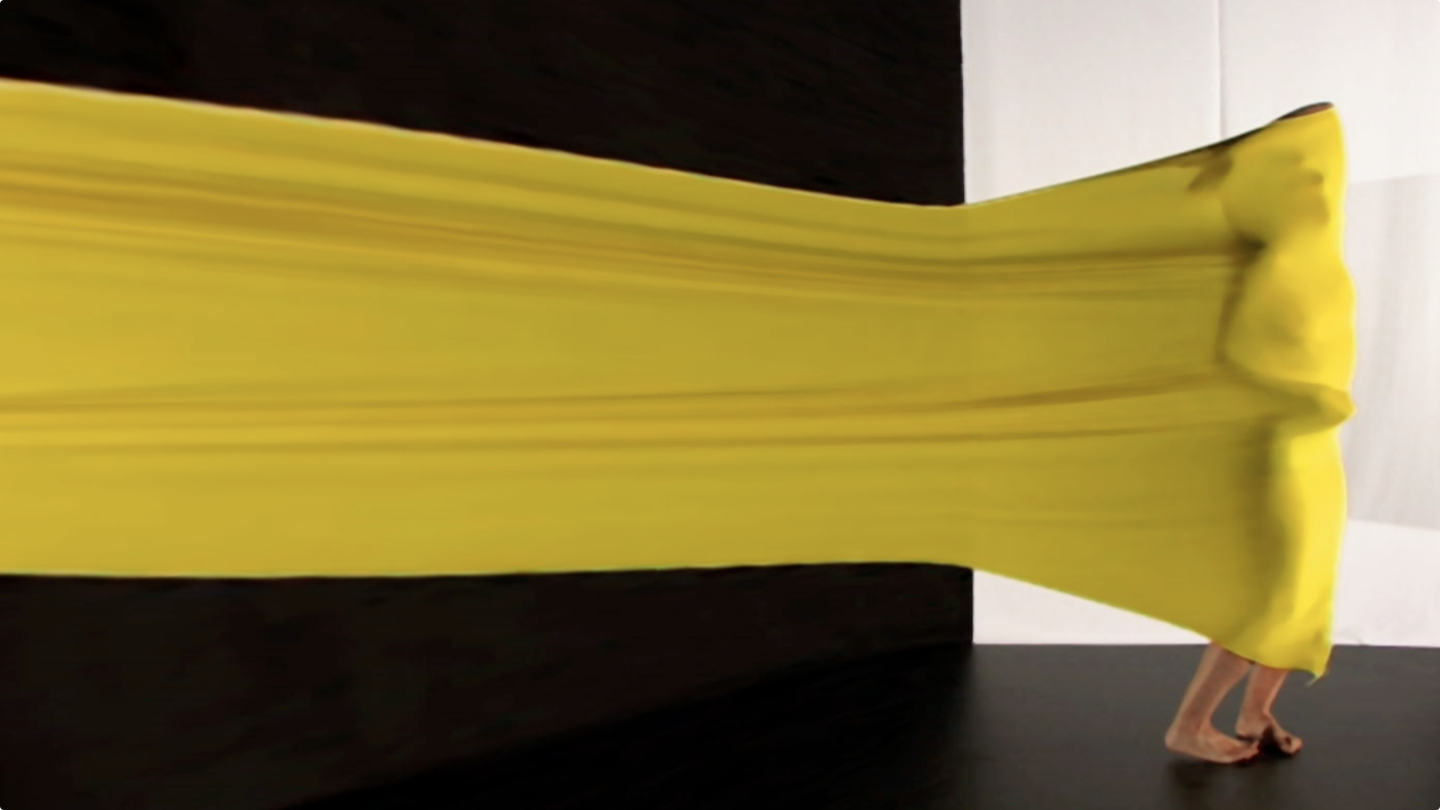
Datenhörraum/data listening space
Interactive Binaural Sound Installation
David Pirrò, Martin Rumori, Katharina Vogt
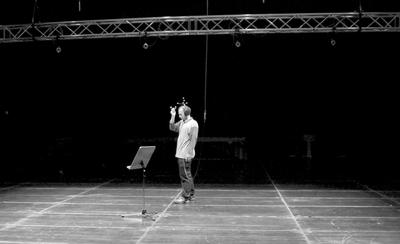
2009, MUMUTH Ligeti Saal; 2012, jakopič gallery ljubljana/slovenia, icmc conference 2012; 2012, hanse-wissenschaftskolleg, delmenhorst/germany, workshop and exhibition "performativity and scientific practice
The Quantum electrodynamics (QED), the theory of light and electromagnetism, describes a space that is, because of its high dimensionality and complexity, almost not representable. We use sonification as a tool to explore the space described by the theory. Controlling sound’s qualities like rhythm, timbre, loudness and spatial projection makes them carriers of information, in order to provide an experience of the QED space.
We present the data listening space, a navigatable sonification of the so called lattice simulation of Quantum Electrodynamics (QED).
Underlying to the sonification is a numerical simulation of the space described by theory. The listener moves freely through space, and her/his position and orientation are captured by a hybrid motion tracking system, which are in turn mapped into the QED space. In this virtual sonic space, sound objects appear, pulsate and vanish according to the running simulation. Further, by rendering these sounds binaurally to the listener's headphones according to her/his position and orientation, the listening space provides a sonic experience of this four-dimensional space.
In the data listening space, the listener plunges into the world of quantum mechanics. By moving around, s/he explores local or global sound structures and textures from all perspectives, listening out for underlying patterns.
The Data Listening space has been conceived within the QCD-audio project by Katharina Vogt, David Pirro' and Martin Rumori. Data listening space was realised and presented as a public interactive installation in November 2009 in the MUMUTH Gyorgi-Ligeti-Saal in Graz. Katharina Vogt, David Pirrò, Martin Rumori
Tball
Trumpet, Live-Elektronik und Motion-tracking
Graz, 2009
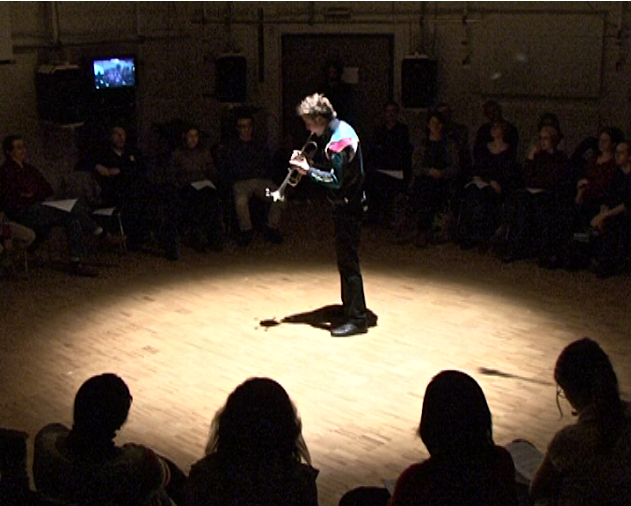
For his piece Tball for trumpet, David Pirrò created a virtual object with which the performer plays by participating in a real-time physical simulation. In listening to the sound resulting from the interaction and watching the behavior of the instrumentalist, the object appears in our imagination. In Tball, the trumpet’s bell is tracked.
Bodyscapes
Intermedial Composition, Dance, Choreography, Live-Electronics, Motion-Tracking
Gerhard Eckel, Valentina Moar, David Pirrò
Graz (Austria), 2009
Bodyscapes is the result of a collective research and creation involving dance, choreography, composition, as well as sound and interaction design aiming at exploring the various facets of an ecology of bodily movement and sound. An underlying assumption is that both elements have a high potential to interlink. In Bodyscapes they engage in a symbiotic relation which is based on a process of giving and taking, one element complementing the other, both forming a whole - one cannot be without the other. The piece presents different spaces of possible relationships between movement and sound (bodyscapes), each baring a particular recognizable characteristic and identity. Particular attention has been paid to identifying the most archetypical of these relationships. Bodyscapes has been realized by Valentina Moar (dance, improvisation, and choreography), Gerhard Eckel, and David Pirrò (composition, live electronics, interaction design, and software development) in the context of the artistic and scholarly research project Embodied Generative Music.
Rebody
Video Installation
Gerhard Eckel, David Pirrò, Michael Schwab
Ghent (Belgium) 2010.
Rebody is a video installation in which the captured motion of a dancer (Valentina Moar) is transformed into a dynamic drawing that, in turn, feeds a musical composition. The installation shows sets of experimental variations that explore the dance movements, the drawing algorithms and the musical structures in an attempt to create aesthetic resonances and convergences. The work investigates how structured creative processes can transpose, rather than represent, the dancer's movements. There exists also a performance version of Rebody, which has been presented together with the installation version at the 2010 Research Festival of the Orpheus Research Center in Music (ORCiM ) in Ghent. Rebody is based on motion-capture data collected from Bodyscapes (2009), an intermedial dance solo performance by Valentina Moar (choreography/dance), Gerhard Eckel and David Pirrò (composition).
cornerghostaxis#1
For solo Basoon, 8-Channel Live-Elektroink and Motion-Tracking
David Pirrò, Gerriet K. Sharma
Bodily Expression in Electronic Music Symposium 2009, & New Interface for Musical Expression Conference, Oslo 2011
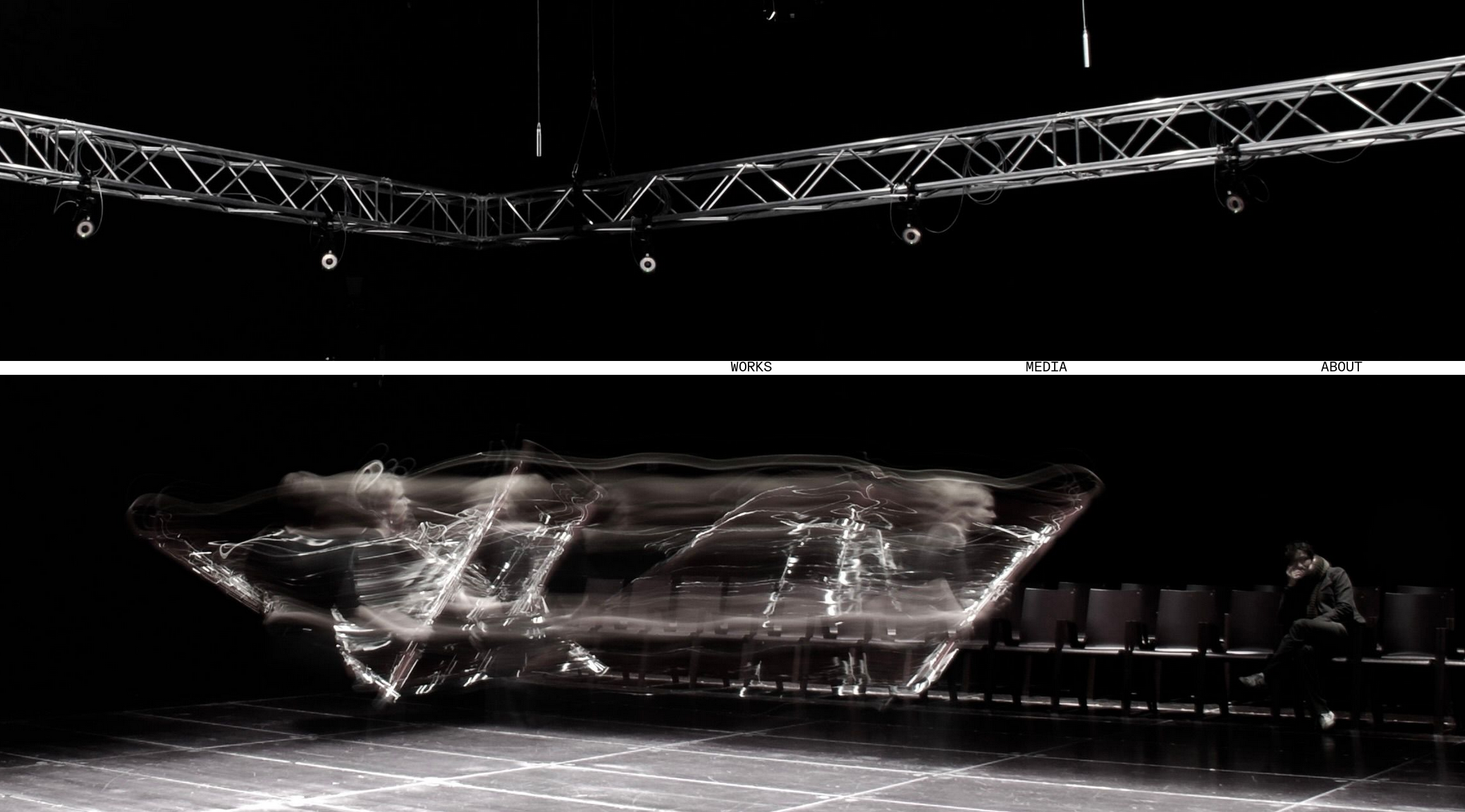
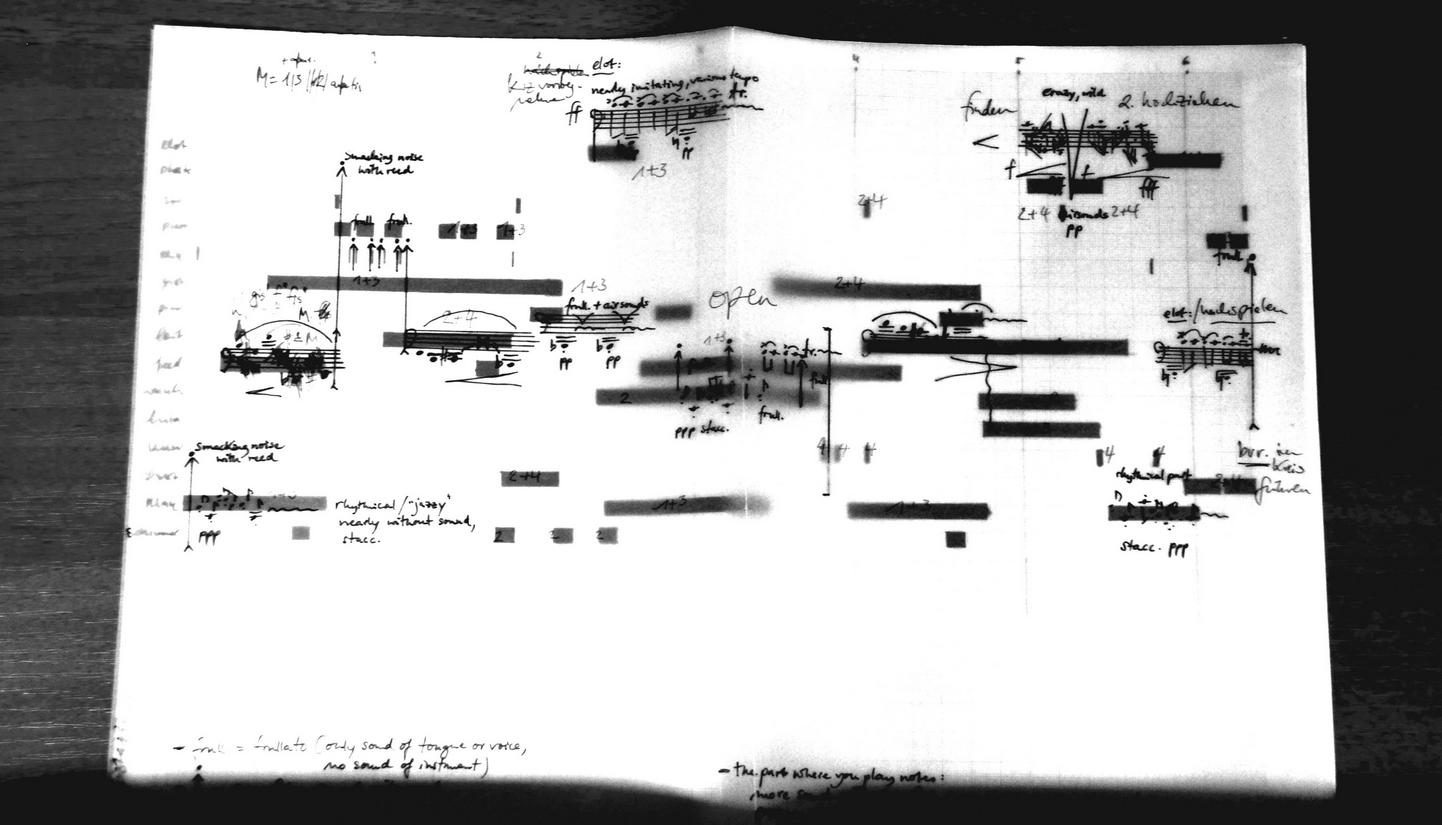
cornerghostaxis#1 is an electroacoustic composition for solo bassoon. The piece is the result of the collaborative effort of a three people team: Stephanie Hupperich (bassoon), Gerriet K. Sharma (composition) and David Pirrò (physical modelling / interaction design). The aim was to design an environment in which the player interacting with the physical model establishes a gestural and bodily relation ship between the sounds she plays on her instrument, her movements in space and four electronic sources that are dy- namically spatialized on a loudspeaker array.
More info on the NIME 2011 paper Here
Four Room Concert
Live-Electronics
Matthias Kronlachner, Peter Venus, David Pirrò, Marian Weger
Rondo Graz, 2011
Traditionally an ensemble of musicians relies on visual contact as well as listing to each other during performance. The four room concert tries to break this aspect to fully concentrate on the auditory perception while playing the concert. At the four room concert every musician has his own little concert hall. Visitors are motivated to change their point of view by walking between the different locations. In the separate rooms, you can hear and see just one musician solo. Additional speakers are located on half of the way between the concert rooms. There, you can listen to the concert with all musicians playing together, but you won’t see anybody. This concept suits electronic music very well to help the visitor distinguish between which musician is producing what sound.
BodyscapescorpoPhonolux
Intermedia Performance, Dance, Light, Live-Electronics
Simon Laburda, Veronika Mayerböck, David Pirrò
IEM Graz, Forum Stadtpark, Vienna 2012 & 2013
Translating Light and movement into sound
“BodyscapescorpoPhonolux” is a multidimensional interactive installation connecting synaesthetically the visual and spatial sense with hearing. The basic idea of this project is the translation of light into sound – to transform what we see simultaneously in an acoustic soundscape.
Bodyscapes establishes a tight link between body movement in space and light- and sound-scapes - the performer becomes “sensor” and interactive element at the same time. Along the dancer's body are 8 light sensors installed, measuring steadily the various intensities and colours of light on selected points along the body surface (joints, head, torso, etc…). The choreography develops as the performer "senses" and explores this environment.
Loudspeakers are distributed over an hemisphere that surrounds the audience. Assigning the sound output linked with each sensor to different loudspeakers, sound can be composed spatially and the soundscape itself becomes a plastic acoustic illustration of the body in space.
The dancer is passing through different light situations which are influenced by several parameters: the way and quality of movement in space, the plasticity of the body and different lighting and projection ambiances by the surrounding structure. The sensors are measuring the different light intensities and colour ambiences along the body surface. Each sensor’s output according to its particular “point of view” is the base for creating an acoustic landscapes which enhances the symbiosis of movement and light situations.
Programm: ./media/corpophonolux.pdf
Interstices
Sound Installation
Georgios Martemtakis, David Pirrò, Raphael Kapeller
ESC im Labor, Graz 2012
Exhibition "interior | exterior"
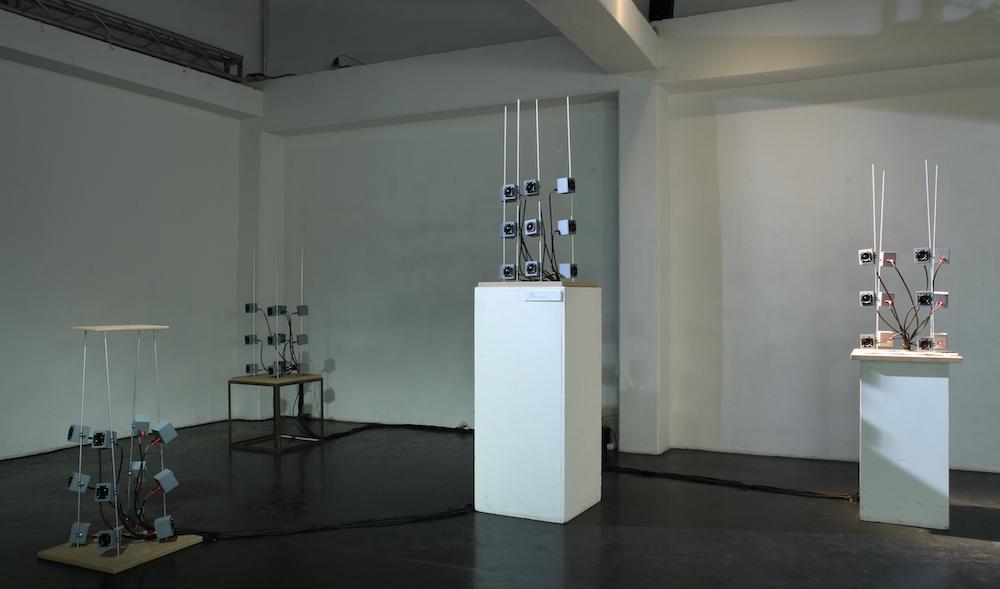
An irregular lattice of 48 loudspeakers forms a three-dimensional landscape. The sounds projected by these sources draw regions, planes and lines into the room subdividing and reorganizing its space. Listening and exploring the intervening spaces between these acoustic shapes, the visitor can compose her / his own path through the sound installation and experience the different spatial perspectives delineated by a slowly changing sonic architecture. This installation is conceived and realized in collaboration with Georgios Marentakis and Sebastian Blamberger.
Klangräume
Project
Georgios Martemtakis, David Pirrò, Marian Weger

The project "Klangräume" enables a broad public to gain insights into current research and state-of-the-art technology. Within the project, two different sound spaces are being realized, which are thematically coordinated and target different audiences. The first sound space deals with the relationship between space and time in acoustic communication, while the second translates datasets from climate research into spatially experienceable forms. Each sound space takes place as an installation in cooperation with an art institution. In this process, a new type of interaction between humans and technology is explored.
Three elements are connected in the "Klangräume" and evaluated for the first time in a holistic framework: sound as a knowledge mediator, which is interactively controlled and thus enables embodiment. This combination is Sonic Interaction Design – SID. The "Sound Spaces" project attempts to develop a methodology for the holistic evaluation of acoustic Human-Computer Interaction through multidimensional evaluation of SID systems – both "in the wild" and under laboratory conditions.
The "Klangräume" project aims to combine the knowledge available in Styria on Sonic Interaction Design (University of Arts Graz/Institute for Electronic Music and Acoustics) and Human-Computer Interaction (FH JOANNEUM Graz, Information Design) into an interdisciplinary field of investigation. In doing so, we build on a portfolio of ongoing and completed research projects and socialize their results: on the one hand, a broad public is involved in HCI evaluation methods; on the other hand, a participatory discourse is stimulated through the novel interactive presentation of research results.
Zwischenräume
Space and Sound Installation
David Pirrò, Georgios Marentakis, Raphael Kapeller, Johanna Reiner s Forum Stadtpark, Graz 2013
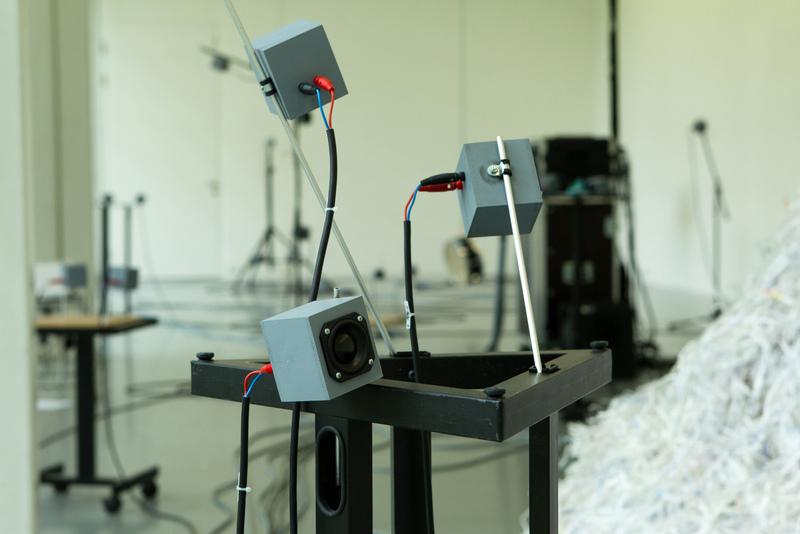
24 microphones and 48 distributed speakers transform the acoustics of the room into a reactive, ever-changing spatial sound sculpture. Snippets of shredded drawings form a mountain. A printer continuously prints new images that are sent to it from outside. The printed images flutter to the ground, intertwining the exterior with the interior space. Visitors are invited to interact with the walkable sculpture and become part of the living sound space.
die verbindung wird gehalten
Immersive sound art radio play performance in binaural stereophony
Live broadcast by ORF/zeitton extended.
May 9, 2014
Starting at 11:00 PM at esc media art laboratory Graz.
Peter Venus (sound direction, electronics), Andres Gutierrez (electronics), David Pirro (electronics), Margarethe Maierhofer-Lischka (double bass, electronics), Johannes Schrettle (text, performance)
Winner of the „limelab“, Stipend for transdisziplinary Radio Play, ORF/Steirischer Herbst. Graz, Austria 2014
ALMAT - Algorithms that Matter
Artistic Research Project
David Pirrò, Hanns Holger Rutz
Algorithms that Matter (Almat) is an artistic research project by Hanns Holger Rutz and David Pirrò. It aims at understanding the increasing influence of algorithms, translating them into aesthetic positions in sound. It builds a new perspective on algorithm agency by subjecting the realm of algorithms to experimentation and diffractive reading.
Almat is a three-year project running from 2017 to 2020, within the framework of the Austrian Science Fund (FWF) – PEEK AR 403-GBL – and funded by the Austrian National Foundation for Research, Technology and Development (FTE) and by the State of Styria. It is hosted by the Institute of Electronic Music and Acoustics (IEM) at the University of Music and Performing Arts Graz.
Simulation and Computer Experimentation in Music and Sound Art
Seminar
David Pirrò and Hanns Holger Rutz
March 21, 2019 until March 22, 2019
Orpheus Institute, Ghent
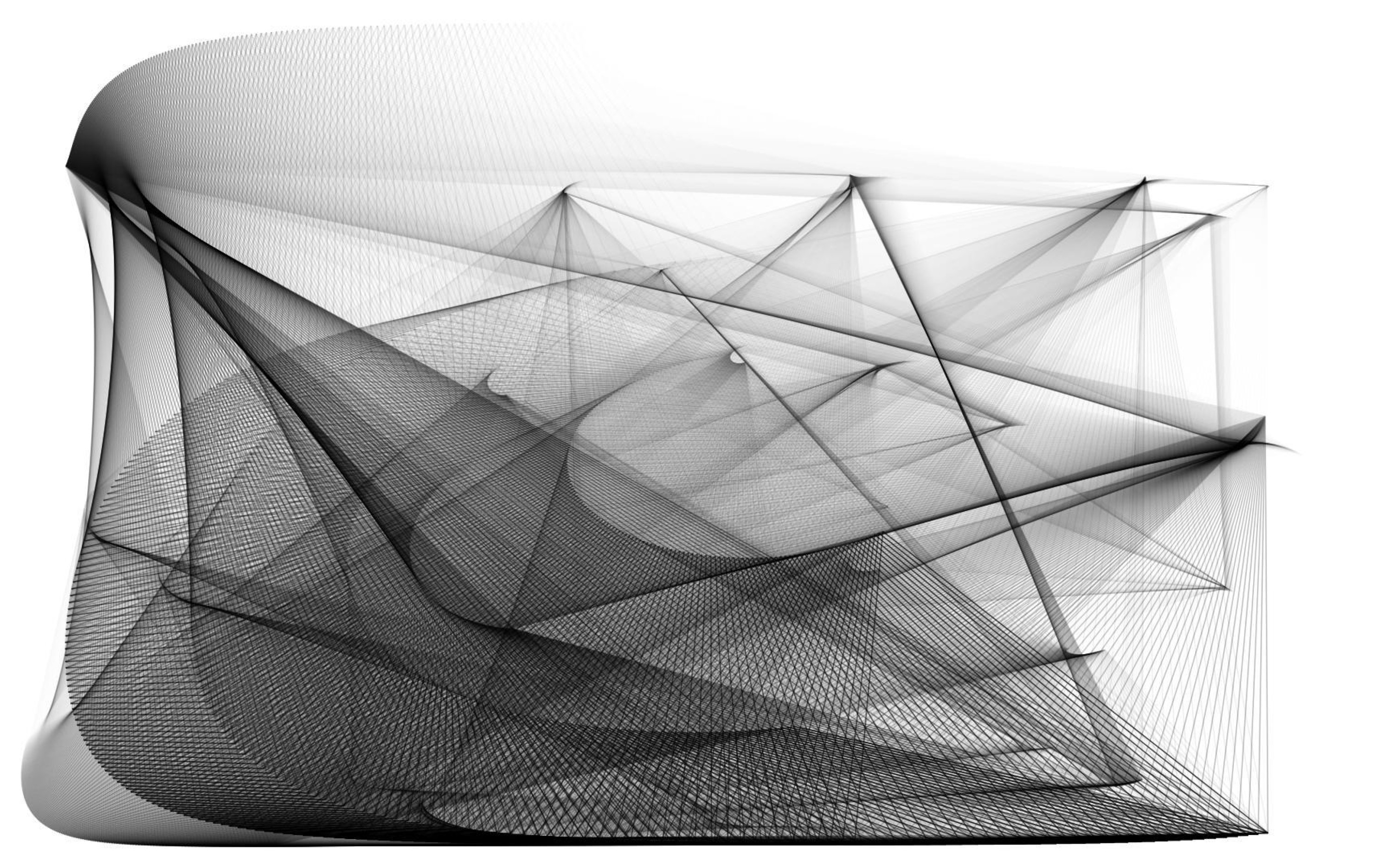
Computational methods have made their way into most of scientific and artistic fields; simulation has become a paradigmatic mode in contemporary practices. In science, in design, in medicine and in art, simulations of natural, human, technological or abstract systems (or techniques derived from simulation) are ubiquitous. The development of new methods of computation and simulation in the natural sciences initiated an ongoing discussion about the relationship of in silico experiments to empirical or theoretical modes of investigation.
The seminar aims to bring together practitioners and scholars to discuss the wide-reaching implications of the ‘agential cut’ (Barad) or ‘ontic cut’ (Rheinberger) – the separation between operationalised model or abstract theory and perceived or experimentally verified ‘reality’, the fissure already indicated by Husserl and realised in experimental computational systems. These introduce a new type of interface between the machinery and what is implemented, allowing for the ongoing production of new data and going beyond the traditional atemporal theoretical models; crucially, simulations also allow new and mobile perspectives onto the ‘object’ modelled by tracing contingent, situated, multiple paths through what DeLanda describes as ‘a space of possibilities’ – alternative realities within a space that displays stability or consistency at another level. In Rheinberger’s words ‘it becomes urgent to ask whether computer simulations represent a new category of epistemic object altogether.’
Threading Time Masterclass
Masterclass
David Pirrò
Conservatory of Piacenza, Italy, 6-8 November 2019
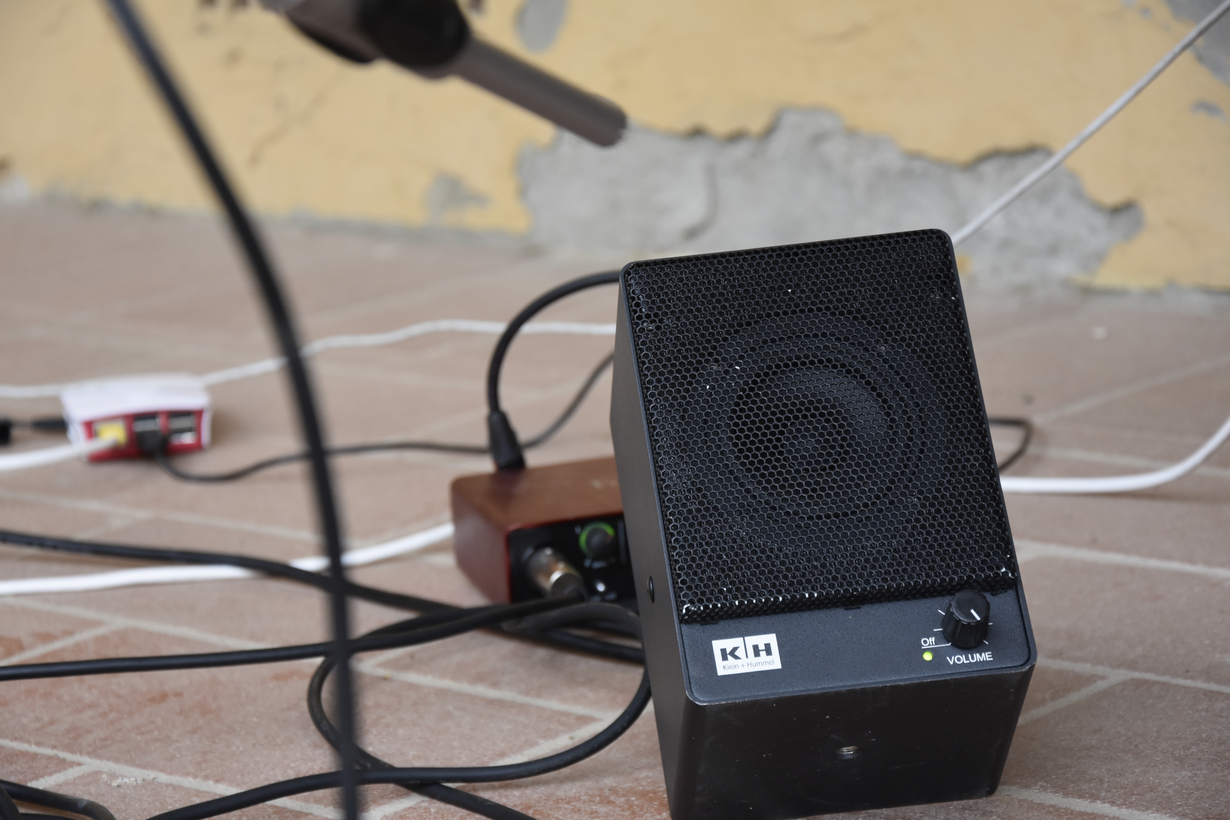
Nowadays algorithms are often relegated to a pure instrumental role: an algorithm is a tool that solves a problem, a function that provides an answer, at the same time hiding its inner mechanics to the external user. Nevertheless, a different perspective that originates from experimental computational sciences views algorithmic processes as performative entities in perpetual and mutual interaction with their context, a world that is co-generated. From this standpoint, as it is the case, for example, in computastional physics, algorithms are processes that resonate with speculative thinking and with an enactive approach to cognition. These systems embody an idea of algorithmicity that is profoundly related both to a consturctivistic vision of cognition and to an ecologic idea to reality.
During the course of the masterclass, algorithms were introduced from a mathematical perspective, departing from practical examples derived from the study of dynamical systmes in physics and mathematics. Some elementary algorithms, based on self regulatory processes (like auto gain control), constituted the basis to develop a shared and distributed sound installation composed of small autonomous sound agents (based on raspberry pi boards), all interacting with each other through the medium of sound (each agent was equipped with a microphone and a loudspeaker).
Signale Lecture - ALMAT Concluding presentation
Lecture
David Pirrò, Daniele Pozzi, Hanns Holger Rutz
Concluding presentation of the Almat project.
ALMAT - at Impuls Academy 2019
Workshop
David Pirrò, Hanns Holger Rutz, and Robin Minard
Partipants:
Dong Zhou Alicia Champlin David Pirrò Nicholas Moroz Jaume Darbra Florian Schwamborn Andreas Trenkwalder Luca Morino Tim Pauli Daniele Pozzi
The 2019 edition of the workshop focuses on the development of a site-specific sound installation at the Museum of Perception. The installation will explore the interactions of algorithmic and physical spaces and their dynamic and mutable properties. Participants will work on the premise that spaces and our perception of them change depending on presence, absence, the movement of visitors, the time of the day, the rhythm of the surroundings as well as the sonic and algorithmic interventions we bring into them.
The participants are invited to develop their various approaches within an atmosphere of collaboration, where special emphasis will be given to the translation of environmental data (such as sensor input from the surroundings and visitors) through computer music systems developed and assembled by the participants and tutors. One question we want to pursue is how behaviours can be composed that transition from “technical and artificial” to “organic and alive”, particularly through the articulation of spatiality.
ALMAT - at Impuls Academy 2017
Workshop
David Pirrò, Hanns Holger Rutz, and Agostino Di Scipio
February 11th-19th, 2017, IEM Graz
ALMAT . Algorithms That Matter
Algorithms That Matter (ALMAT) focuses on the experimentation with algorithms and their embedding in live performances. Rather than conceiving algorithms as established building blocks (“live electronics”) or the formalisation of a compositional idea (“algorithmic composition”), we look at them as performing entities whose consequences are irreducible to models. Algorithms “matter” in the sense that matter and meaning cannot be distinguished, they may be moulded and they may unfold material in an ecosystemic way: Materials become a new source for transformation.
This workshop seeks to attract computer music practitioners, sound artists and composers by offering a platform for exchange and reflection about their personal approaches towards algorithmic experimentation. The participants are enabled to further develop their approaches, where special emphasis is given to the reciprocal coupling of their respective systems. The workshop starts with an internal presentation of the participants for the other participants and tutors, followed by an in-depth analysis and discussion of the different approaches. The rest of the workshop takes a semi-structured form, open to adaptation to the interests of the participants. Focus will be on the mutual engagement and the production of connecting points between systems, using both data and sound links. At the end, concert slots within the impuls festival are allocated for the participants to present either existing works or new works developed during the workshop.
The workshop will be held at the CUBE performance space of the Institute for Electronic Music and Acoustics (IEM). The CUBE is equipped with a 24-channels periphonic loudspeaker setup for advanced sound spatialisation and an 18-cameras infra-red motion capture system allowing bodily motion to be used as input for sound synthesis and processing.
The workshop Almat was developed by David Pirrò and Hanns Holger Rutz (both IEM Graz) and will be realised together with Agostino Di Scipio.

Selected participants for this program:
- Alyssa Aska
- Laura Endres
- A. Fernández Rodríguez
- Davide Gagliardi
- Brian Garbet
- Phivos-Angelos Kollias
- Frédéric Le Bel
- Matteo Polato
Algorithmic Spaces
Workshop
David Pirrò, and Hanns Holger Rutz
ZKM Karlsruhe, 2018
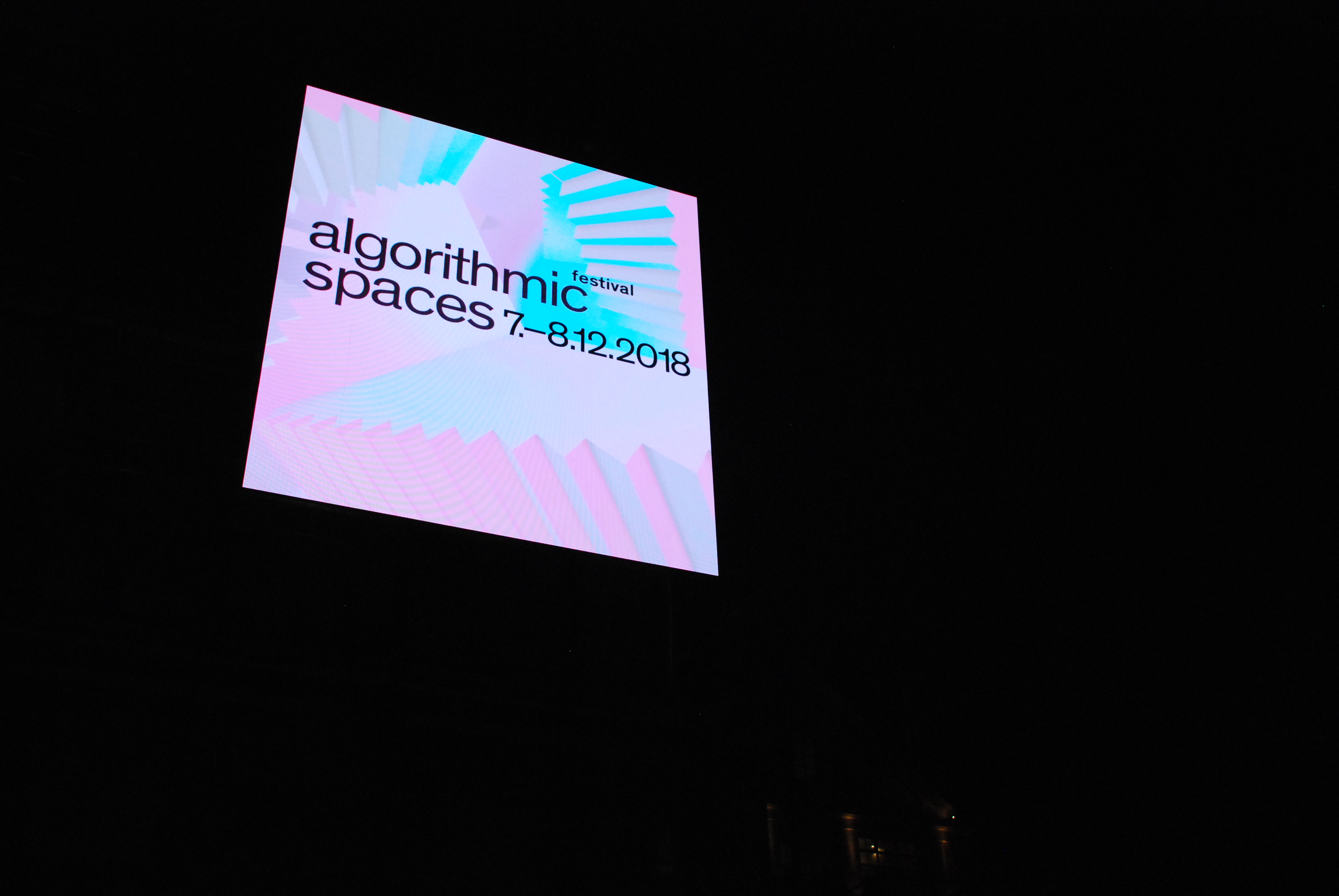
Are there inherent spatial properties to algorithms? For example, what is the relationship between the iterations of code, the behaviour of multi-agent systems, the exploration of databases, and their inscription into the perceptual, auditive space? We were interested in pieces that use generative processes to produce space, rather then applying a secondary “spatialisation” procedure. We were looking for approaches that treat spatiality as a critical phenomenon emerging from the work with algorithms, for sonic artefacts that probe concepts of spatiality through embedding in algorithmic processes.
Thresholds of the Algorithmic
Workshop
Hanns Holger Rutz, and David Pirrò
Bergen Center for Eletronic Arts (BEK), Lydgalleriet, Bergen, NO, 2018.

Thresholds are locations of transitions, points where one modality becomes another, where a qualitative change occurs. In physics the point where an aggregate state changes—the phase transition—is a distinguished transitional location where the properties of the adjacent states become evident. Similarly, in this workshop-in-exposition we want to study the properties of the algorithmic by putting ourselves in threshold positions and actively shape them. More than merely separating two sides, one can spend time on a threshold, move along a ridge, performing a tightrope walk while trying not to fall to either side.
This is the exposition for an event taking place in Lydgalleriet Bergen, Norway, June 2018. Thresholds of the Algorithmic is a collaboration between ALMAT and Bergen Center for Electronic Art (BEK), and part of BEK and Notam’s ongoing series of workshops for advanced users. It is a hybrid format that places the workshop inside an exhibition context, where the exposed works and artefacts form the basis of the workshop’s activity. Instead of “closed works”, what is exposed to the general public are objects, sounds or installations that are open to engagement and reconfiguration during the workshop.
From Data to Process
Presentation
From Data to Process: Algorithms that Matter, Hanns Holger Rutz, David Pirrò and Agostino Di Scipio, Perspectives and project launch
Abstract:
Algorithms that Matter (Almat) is a three-year FWF-funded artistic research project (AR 403) run by Hanns Holger Rutz and David Pirrò at the IEM Graz. It asks how algorithmic processes emerge and structure the praxis of experimental computer music. What we are interested in is to rethink algorithms as agents co-determining the boundary between an artistic machine or “apparatus” and the object produced through this machine. Unravelling the seemingly stable notion of algorithm, we look at the way an experimental culture in which the work with algorithms is embedded shapes our understanding of it, retroacts and changes the very praxis of composition and performance. Using as dispositifs two distinct software systems we have created, SoundProcesses and rattle, we implement a series of connected experiments, addressing research questions such as: What are the “units” of algorithms, in what way can they be de- and recomposed, what is the nature of their affordances and material traces, how can they be preserved and inform the methodology of artistic research? Special focus is put on the reconfiguration of elements, such as relaying a system to another artist/composer, and we work with a number of invited guest artists to explore the different algorithmic perspectives.
In From Data to Process, Rutz, Pirrò, and collaboration partner Agostino Di Scipio introduce the project and strategies to pursue, when data remains incomputable and algorithms become forms of process.
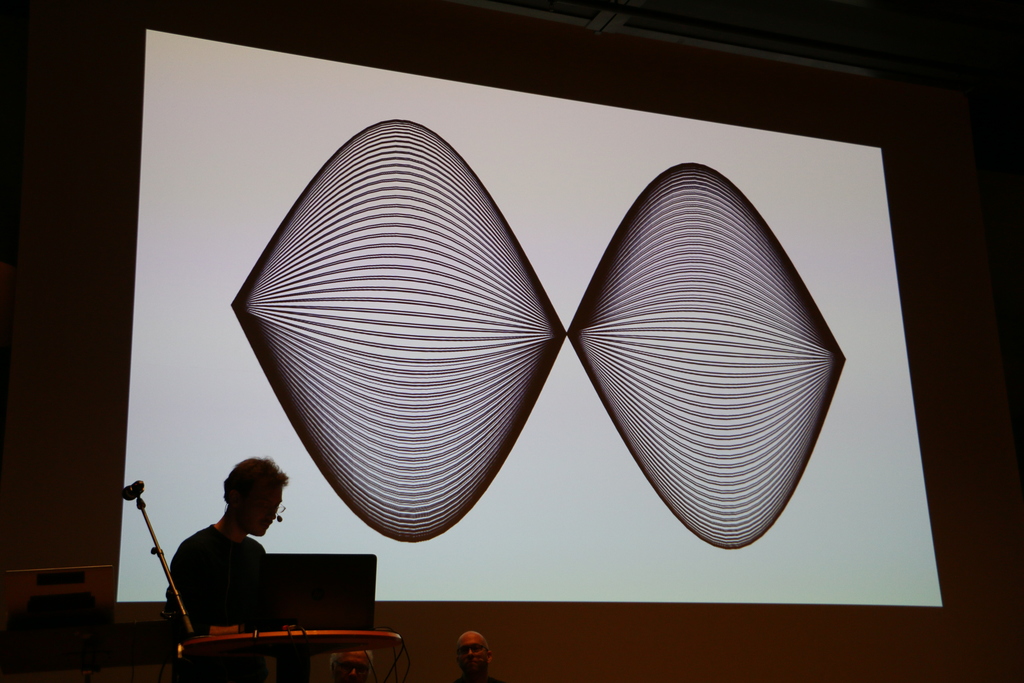
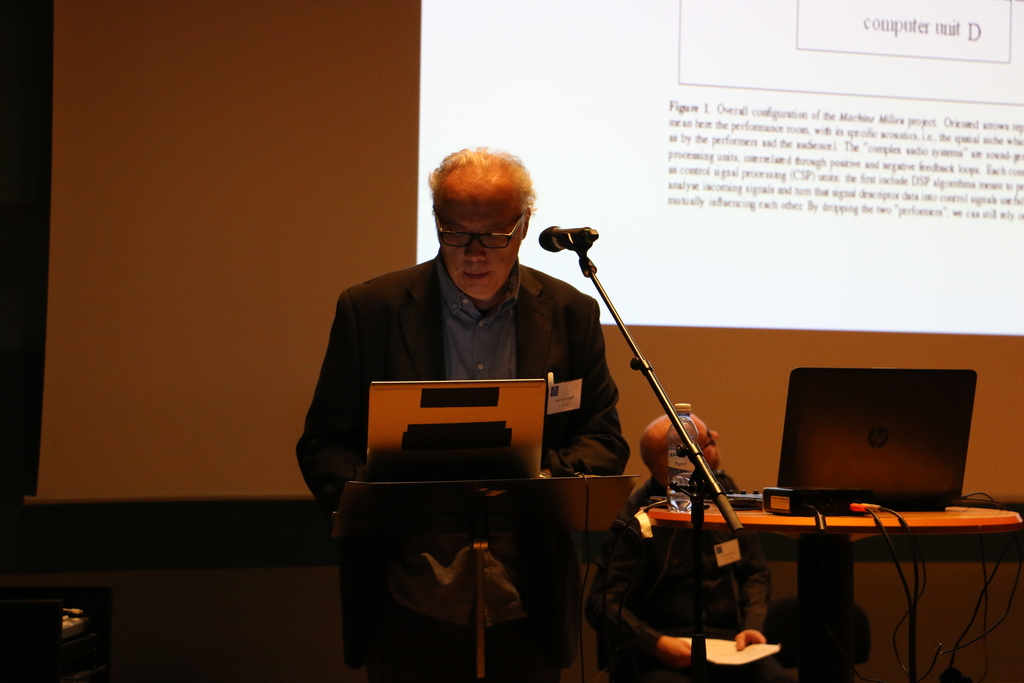

Composing Spatial Instruments
Workshop
Gerhard Eckel & David Pirrò
held at the International Summer Course for New Music, Darmstadt, 2014
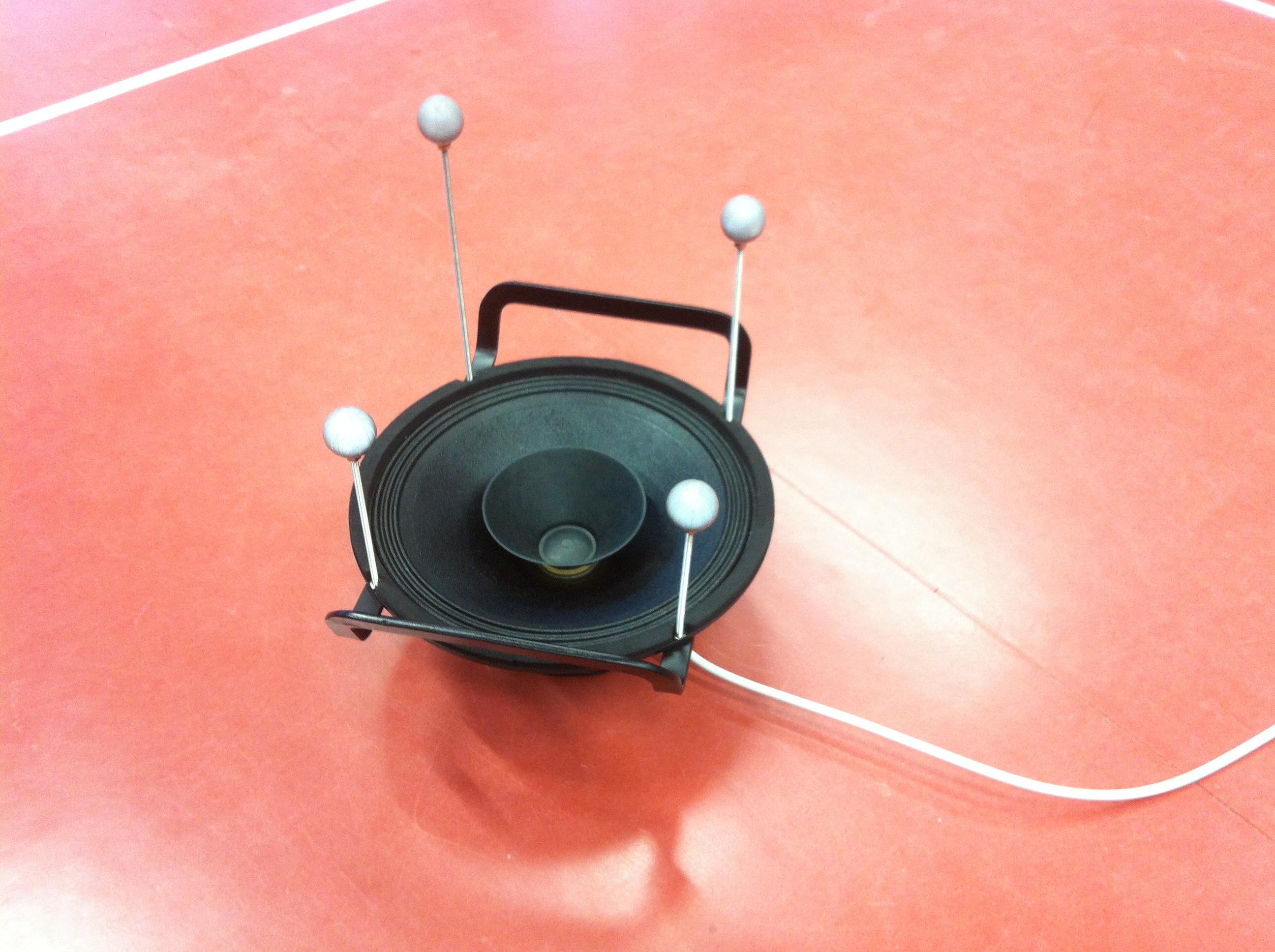
The expansion of the compositional process through digital instrument design is a common practice today. In this practical workshop, we explored a specific type of instrument and interaction design using motion capture technology. Composing the smallest details of the relationship between human movement and sound opens up unprecedented possibilities for musical expression. The spectrum includes approaches such as those in the Embodied Generative Music project or sound installations designed for direct exploration by the audience.
In the workshop, we introduced composers, musicians, and performers to the fundamentals of high-resolution motion capture, which enables the composition of complex movement/sound relationships that allow quasi-tactile control of synthetic sound. Participants were provided with a specialized software toolkit for SuperCollider. Sufficient time was allocated for experimenting with composed spatial instruments for both performance and installation applications. We also highlighted connections to other artistic fields such as dance and media art.
Performative Computer Music Practice and Exchange
Workshop
David Pirrò with teh suppro of Richard Barrett
Impuls International Composers Academy 2015.
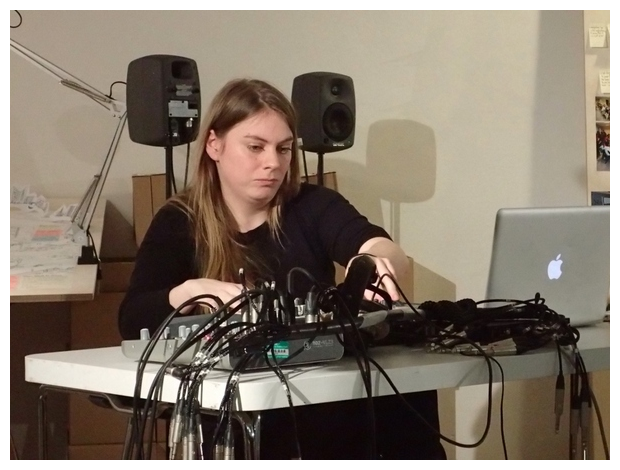
Selected participants:
Jessica Aslan, Joan Bagés, Bernardo Barros, Julie Delisle, Davide Gagliardi, Vincent Giles, Martyna Kosecka, Emma Lloyd, Hanns Holger Rutz, Idin Samimi Mofakham
Performative Computer Music (PCM) is a musical practice that integrates composition and performance, rather than treating them as separate activities. In PCM, performance goes beyond the mere interpretation and staging of a text; it is an integral part of the composition process, which also includes instrument design. Consequently, in PCM, the traditional roles of performers, composers, and instrument makers merge. This workshop aimed to attract various practitioners—laptop performers, instrument builders, interface designers, composers, and instrumentalists—by providing a platform for exchanging and reflecting on their personal approaches to PCM. Through presenting and collaboratively exploring their respective practices, participants were able to develop greater virtuosity and deeper insights into PCM.
The workshop began with an internal concert, where participants performed for each other, followed by an in-depth analysis and discussion of the presented approaches. Participants were then encouraged to engage with others' approaches by performatively exploring each other's instruments.
Audible Ecosystemics - signale graz 1010
Live-Elektronik Concert
Agostino Di Scipio & David Pirrò
Ligeti Hall, MUMUTH, Graz, Austria 2015

This concert explores different ‘performance ecosystems’ in the work of composer and sound artist Agostino Di Scipio. In the featured works, sound and music emerge from situated (real-time and real-space) sonic interactions between performers, various technlogical resources, and the room itself hosting the performance. Canonical of this approach are the works from the AUDIBLE ECOSYSTEMICS pieces. Other, more recent works are presented scored for either instrumental resources only, or for performers ‘visiting’ or ‘navigating’ automous networks made of digital and/or analog technological resources. Also featured is a new work by David Pirrò USELESS MACHINE #6, which develops similar lines of sonic research and investigation toward new possible directions.
Flyer: file:///home/david/src/pirro.mur.at/media/1010_Flyer_04.pdf
duo Diegert / Pirrò
Saxophone, Live-Electronics
Joel Diegert, David Pirrò
Prattica E
Friday, 05. June, 2015 Minoritensaal, Graz
and
open CUBE, IEM, Graz Tuesday 06.05.2014, 20:00
Joel Diegert (Saxophone) and David Pirrò (Sound Design) present outstanding works from the current repertoire for saxophone and electronics: compositions by Germán Alonso, Nathan Davis, Fabien Lévy, and Luis Naón.
Programme:
El Gran Cabrón (2012) Germán Alonso (*1984) Cipher (2012) Nathan Davis (*1973) L'air d'ailleurs - Bicinium (1997) Fabien Lévy (*1968) Senderos… que bifurcan (2002-03) Luis Naón (*1961)
Außer der Serie – useless machine # / martim-pescador #
Live-Elektronik Performance
David Pirrò, Martin Rumori
Prattica E, 5. June, 2015
With the series "useless machine" and "martim-pescador," David Pirrò and Martin Rumori have been documenting their respective engagements with themes they cannot resolve for several years. In "useless machine" (Pirrò), these are dynamic systems and their sonic developments, while in "martim-pescador" (Rumori), they are associative improvisations with field recordings. In both projects, the design of the spatial parameter is essential, which repeatedly involves new aesthetic and technical approaches to various procedures and instruments for sound projection.
In today's opening concert of the "prattica E" series, 48 mobile miniature speakers, organized in 12 groups of 4 speaker cubes each, form such a projection matrix, which is contrasted with the multi-channel sound system of the preceding concert sections and a number of radios. Incarnations of "useless machine" and "martim-pescador" appear today outside their series without the usual numbering and form the basis of a joint, comprehensive composition that is expanded with quotations and allusions to other composers.
IGNM @ prattica E
Sound Direction, Live-Elektronik
Graz/Vienna, 2015
Die Internationale Gesellschaft für Neue Musik (IGNM) wurde 1922 während der Salzburge Festspiele von einigen der damals namhaftesten zeitgenössischen Komponisten gegründet und besteht heute als österreichische Sektion der internationalen Dachorganisation ISCM (International Society for Contemporary Music) fort. Seit dem Jahr 2011 besteht auch eine Geschäftsstelle Steiermark, deren Konzerte zumeist in Kooperation mit dem Kulturzentrum stattfinden. Im ersten IGNM-Schwerpunkt dieses Herbstes werden nun Werke aus dem Bereich fixed media instrumentalen Solostücken mit Live-Elektronik bzw. Klangprojektion gegenübergestellt. Wir freuen uns auf ein vielseitiges Programm, das Werke aus den letzten Jahren und Jahrzehnten umfasst und somit auch das äußerst diverse Klangmaterial widerspiegelt, das zum Gegenstand der elektronischen Gestaltung werden kann. Die Klangregie der mehrkanaligen Bespielung des Cubus wird von David Pirrò geleitet. (Daniel Mayer)
Programm, 13. November*: Dieter Kaufmann: Paganihilismo (Lorenzo Derinni – Violine) Johannes Kretz: Nocturne (Karin Silldorff – Blockflöte) Pia Palme: GIB SIE WIEDER (Mona Smale – Harfe) Angelica Castello: la fontaine 2a Se-Lien Chuang: Launenspiel Thomas Gorbach: Four variations with ribbed sounds Katharina Klement: peripheries Andreas Weixler: für Pi Tamara Wilhelm: bad weather lately
Programm, 14. November*: Belma Bešlić-Gál & Bernhard Gál: flut (Elisa Azzarà – Bassflöte) Karlheinz Essl: Sequitur X (Kevin Fairbairn – Posaune) Veronika Simor: Imaginlo (Michael Moser – Violoncello) Thomas Grill: Extended View Klaus Hollinetz: N.N. Volkmar Klien: Nahen – Weiten 01 Caroline Profanter: Das Leben ist kein Wunschkonzert Elisabeth Schimana: Weave Oliver Weber: Calling JT
Klangregie: David Pirrò
Transpositions
Hypercolumns
David Pirrò
for 15 Akustische Instrumente
Zentrum für Kunst und Medien) in the context of the festival GLOBALE: Tangible Sound, 2015
Speaker matrix
Sound installation
Gerhard Eckel, David Pirrò
Vienna/Austria, 2016

A neural network is a compound of entangled objects. A convoluted collection of nodes and connections between them; an inextricable knot in which pulses spread from one point to the others in complicated patterns. Each single element contributes to the behaviour of the whole network: a vibration pulsating in a strange oscillation and appearing as an coherent phenomenon. Speaker Matrix uses data of a simulated neural network modelling how memory recall processes in our brains might function. The sound installation moulds this data, expands and stretches it in time and space, by slowing it down and, without breaking its internal connections, kneading it into a rectangularly shaped dough. Into this ”lump”, 30 probes are inserted, arranged in a matrix: these are auscultation points through which one loudspeaker makes audible what happens around each position. As all loudspeakers play at the same time, the Speaker Matrix transposes the behaviour of the neural network into a sound that, according to the intricate spreading of signals through the network, exhibits spatial movements, vibrations that travel through the loudspeaker arrangement and through the exhibition space.
Jackfield
Headphone Sound Installation
Gerhard Eckel, David Pirrò, Michele Seffino
Vienna (Austria)

The Jackfield exposes the dynamics of simulated neural activity as binaural soundscape. Different timbrical and spatial perspectives can be adopted by the listener through manually browsing the 81 transpositions layed out in a matrix of headphone jack sockets. Through different extents of filtering (arranged along one axis of the matrix) neuronal spikes (perceived as bright events in the foreground of the sound texture) can be separated to different degrees from the continuous changes in the cell potentials (audible as much duller background events). Acoustically, the cells are grouped in a binaural simulation of the Angewandte Innovation Laboratory (AIL) gallery spaces, for which the Jackfield was produced and has been exhibited in the context of the Transpositions research event DA TA rush: Transposition not Exhibition in May 2016. Different cell configurations and virtual listening positions (arranged along the other axis of the matrix) expose the complex temporal relationships among groups of cell. Whenever the listener inserts the headphone jack into a socket, the looped signal starts from an initial position, easing an exploration of the space of differences established by the Jackfield.
Reconfigurations
Videoinstallation
Gerhard Eckel, David Pirrò, Michael Schwab
2016
Reconfigurations is a transposition of neuronal activity patterns created in a super-computer simulation of memory processes in the brain. In the particular simulation used for Reconfigurations, the neurons reactivated memorised patterns spontaniously, i.e. without external stimulus, which provoked our curiosity. The neurons were grouped in 81 cortical modules and the correlation of the activities among all these groups have been calculated, forming a high-dimensional space. By means of a dynamical system this space has been projected onto 2 dimensions. Each point moving on the resulting plane corresponds to the activities of one group of neurons. The distances between the points are related to the correlations between the activities of the respective cortical modules. Points closer to each other show a higher correlation than points further apart. The visible behaviour of the points is the result of two dynamical systems: one that creates the behaviour of the neuronal network and the other one trying to negotiate the ever changing degree of correlation between the activities of the neuronal modules. In its attempt to reduce the complexity of the high-dimensional space to a plane, Reconfigurations reduces the spatial complexity at the expense of introducing temporal complexity.
Transpositions: Data Rush
Not Exposition
Gerhard Eckel, Michael Schwab, Artemi-Maria Gioti, David Pirrò
Angewandte Innovation Lab (AIL), Vienna, 2016
DA TA rush was a transposition, not an exhibition. It engaged with artificial neural networks, brain activity, architectural mapping, motion capture, galaxy cluster surveys and modelling, particle physics, dynamical systems simulations, room impulse response measurements, air flow turbulences, and sonic textures. The transposition investigated emergent formal and perceptual relationships between data events distributed across the gallery. A set of triggers excited a dynamic system, which articulated and integrated what was performed in DA TA rush. DA TA rush asked if it is possible to liberate data from its representational duties. It enacted data as an imaginary, lived body between the various material elements, human bodies included. How does data pass from one form to another? Are there artistic forms capable of associating what seems highly diverse?
The Illusion of Simultaneity
Sound Installation
Gerhard Eckel, David Pirrò, Martin Rumori
The idea of someone on the other side of the globe doing something at the very same time as somebody else is doing something here and now relies on a certain notion of simultaneity. Such a notion most likely did not exist before Standard Time had been established only about a century ago. Global synchronisation at ever greater precision is required for global navigation, travel, and communication. But can there be an actual experience of simultaneity or does it remain an abstract idea? The installation The Illusion of Simultaneity explores this question. It has been created for the research event Transpositions: From science to art (and back) which took place October 4-6 2017 in Stockholm / Sweden. Acoustic signals were generated by reactive sound sculptures at each of the five Stockholm venues of the event. Simultaneously, five sculptures were gathered in one room at a central location where they interacted more directly, forming a local dynamical system. The question posed to the audience then was: "Will you allow your experience to construct a network spanning the city of Stockholm?". A transposition of the installation has been presented at the research event Exploring Formants, Enhancing Practice in Graz.
Complexity and Complication
Live-Elektronik Koncert-Installation
Gerhard Eckel, Luc Derycke, David Pirrò, Martin Rumori
Stockholm (Sweden) 2017 and Graz (Austria) 2018
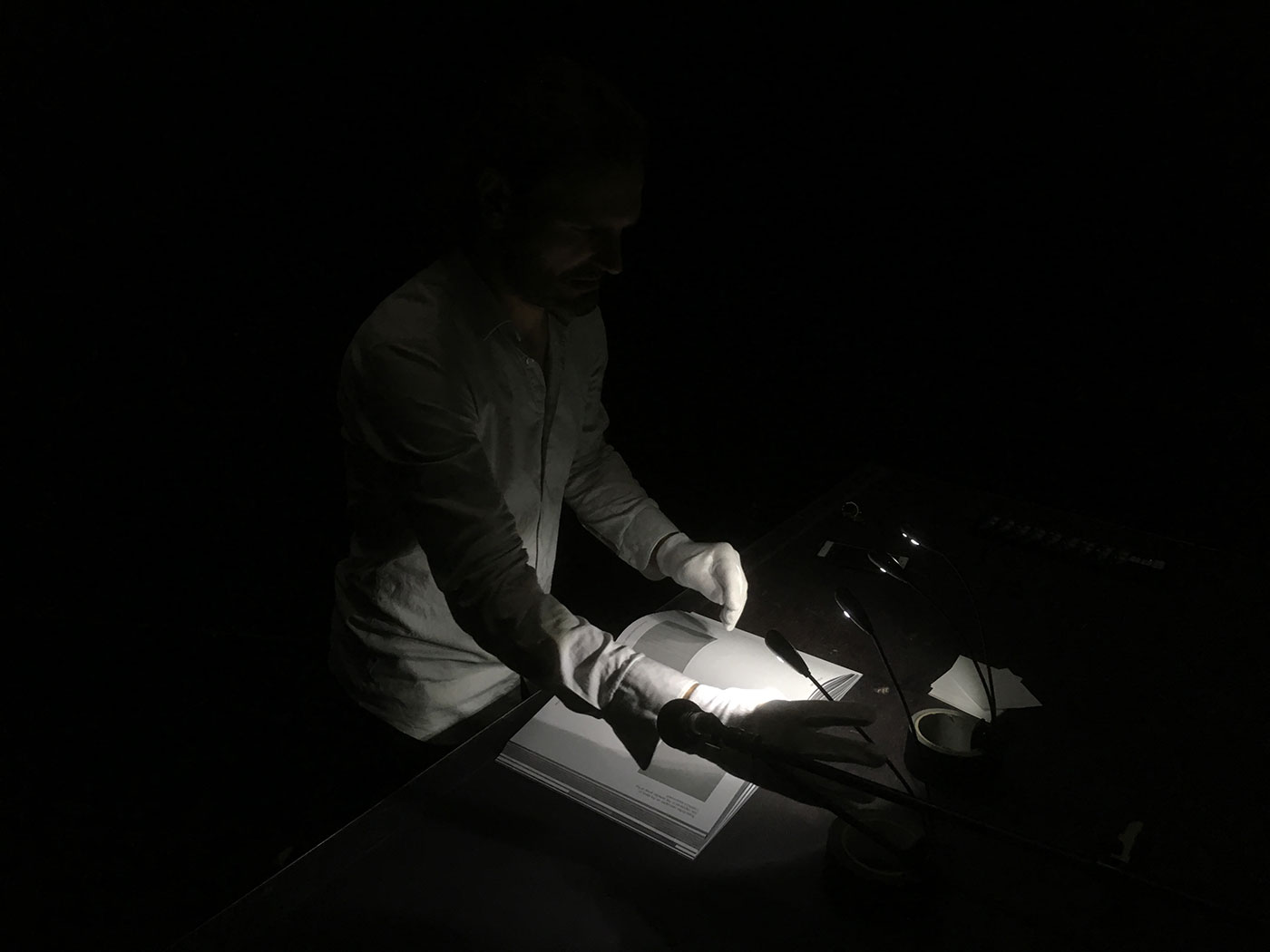
Data analysis is about turning information into understanding and knowledge. Scientists use a large array of powerful tools to filter, sort, cluster, correlate, and contextualise data. Generally, they aim at reducing complexity which is considered an obstacle for the extraction of information, on the path towards knowledge. Artistic data exploration as practiced in the project Transpositions does not aim at reducing but at embracing complexity, and uses it as an instrument to search for the boundary regions between understanding and sensual experience. By having a complex body of data encounter a complex system of exploration designed according to aesthetic criteria, usually a situation is generated which retains (and maybe augments) complexity rather than diminishing it. The goal is not to answer existing questions or solving known problems but to generate new ones gaining different perspectives on the data, which would be otherwise out of reach. Complexity and Complication is a concert installation performed by Gerhard Eckel, David Pirrò, and Martin Rumori using the DA TA catalogue to aurally explore data from molecular biosciences, computational neuroscience, particle physics, and cosmology.
Anemone Actiniaria
Live-electronic duo project
David Pirrò, Hanns Holger Rutz
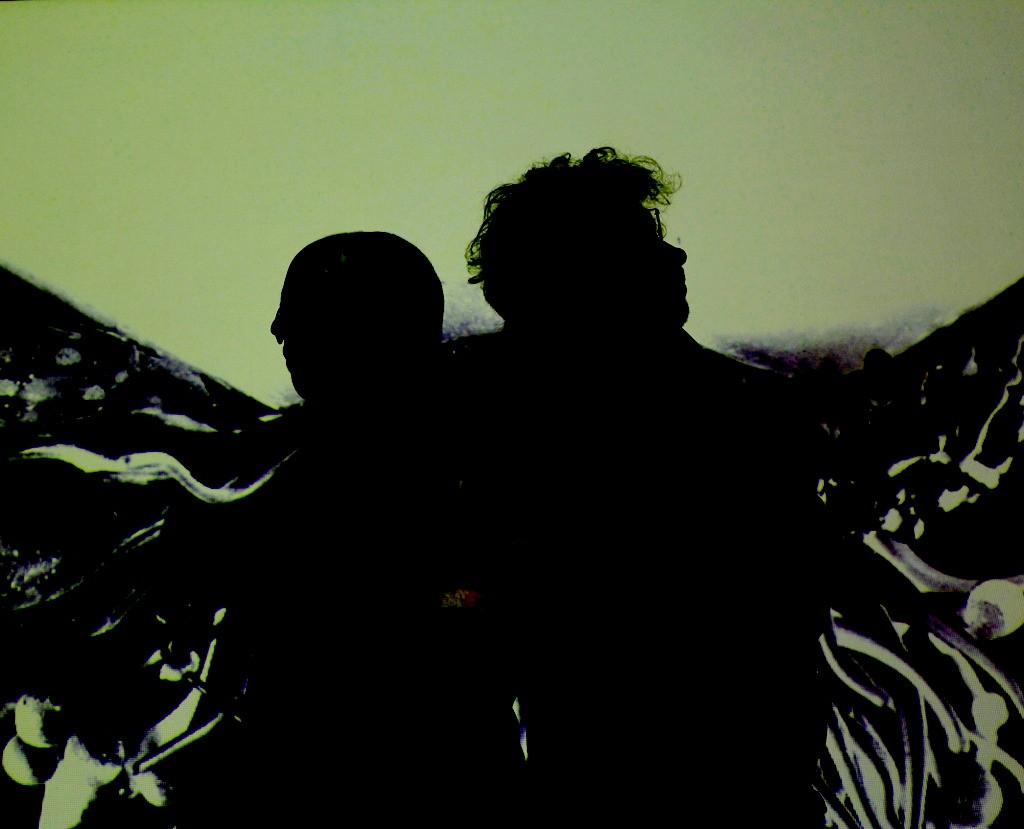
Anemone Actiniaria is an algorithmic improvisation duo founded by Hanns Holger Rutz and David Pirrò in 2014. In it, they couple computer systems and introduce semi-autonomous agents. As artistic research project, the seemingly well-defined concept of algorithm is subject to a new reading based on material agencies. Mutual observation and overwriting is initiated between our systems, Wolkenpumpe and rattle, rooted in physical modelling and in the generation of parametric models based on machine learning. This is inspired by the notion of an emergent new machine through ‘orientation’ and ‘composition’ as outlined by Heinz von Foerster and Dirk Baecker, whereby the functions of operators and operands of the formerly separated systems begin to vacillate.
Anemone Actiniaria performed in various venues including the xCoAx 2016 Conference in Bergamo and the the BEAST FEaST 2017 in Birminghem (upcoming). The duo has also been invited for a residency at ZKM | Institut für Musik und Akustik (IMA) in 2015 where it contributed to a concert of the EASTN European Art-Science-Technology Network.
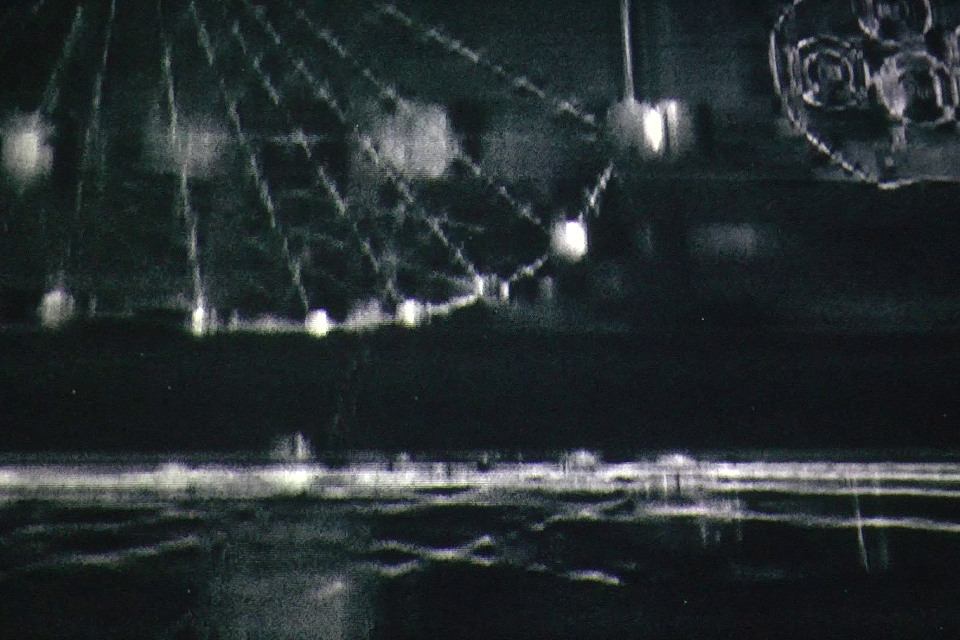
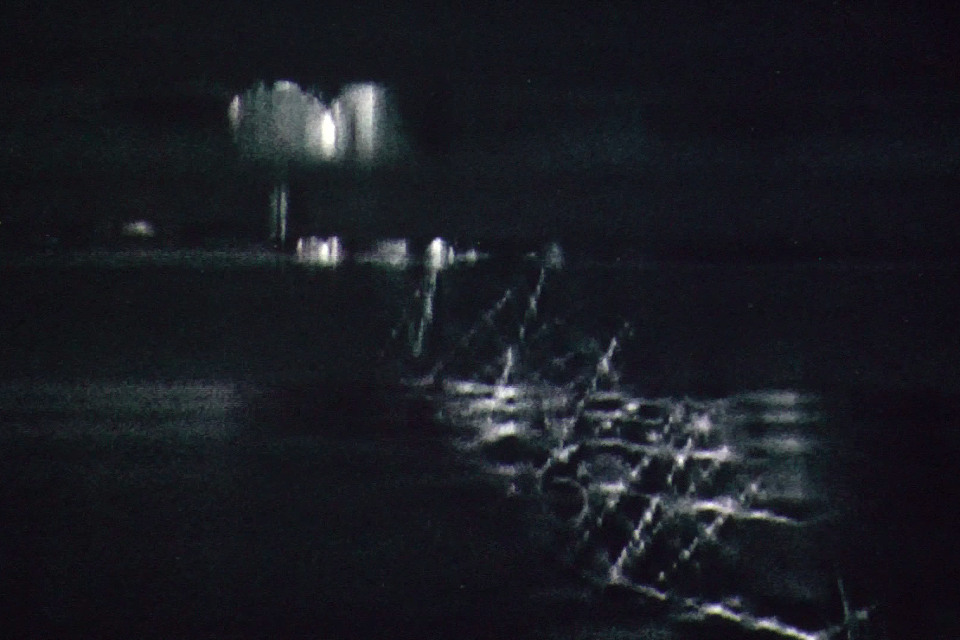

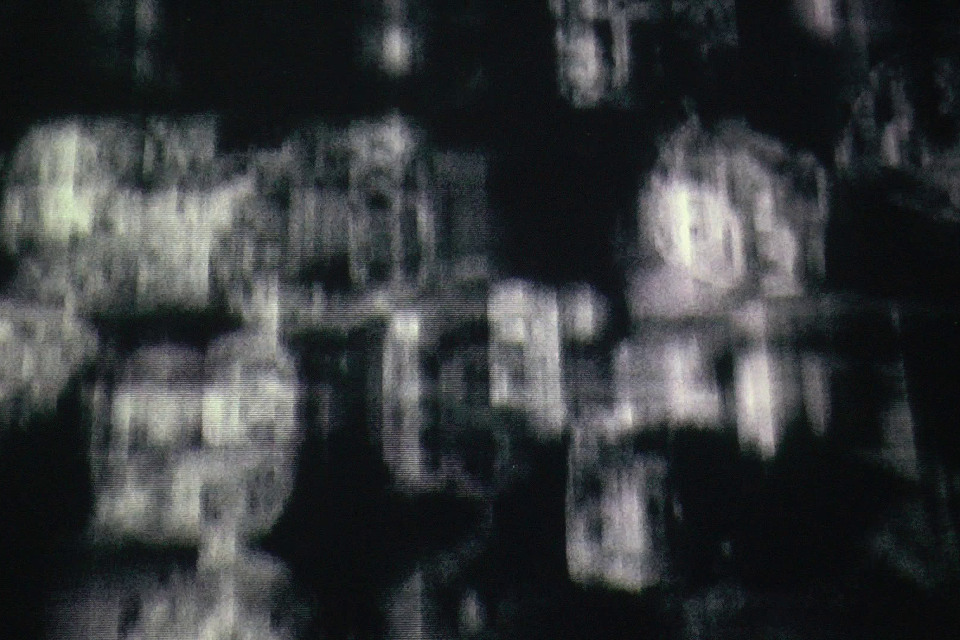
Anemone Actiniaria on the Researchcatalogue
Please contact us if you are interested in obtaining a demo of this project. Here is an excerpt from a live improvisation:
Anemone actiniaria at the Pikselfest 2021
Further recordings:
anemone af1a21b (i)
anemone af1a21b (ii)
anemone af1a21b (iii)
anemone af1a21b (iv)
Recording of the performance on 17.01.2017 - Art's Birthday, which has been streamed live on Ö1, Austria's first public radio channel.
Performances
Some past and forthcoming performances of Anemone Actiniaria
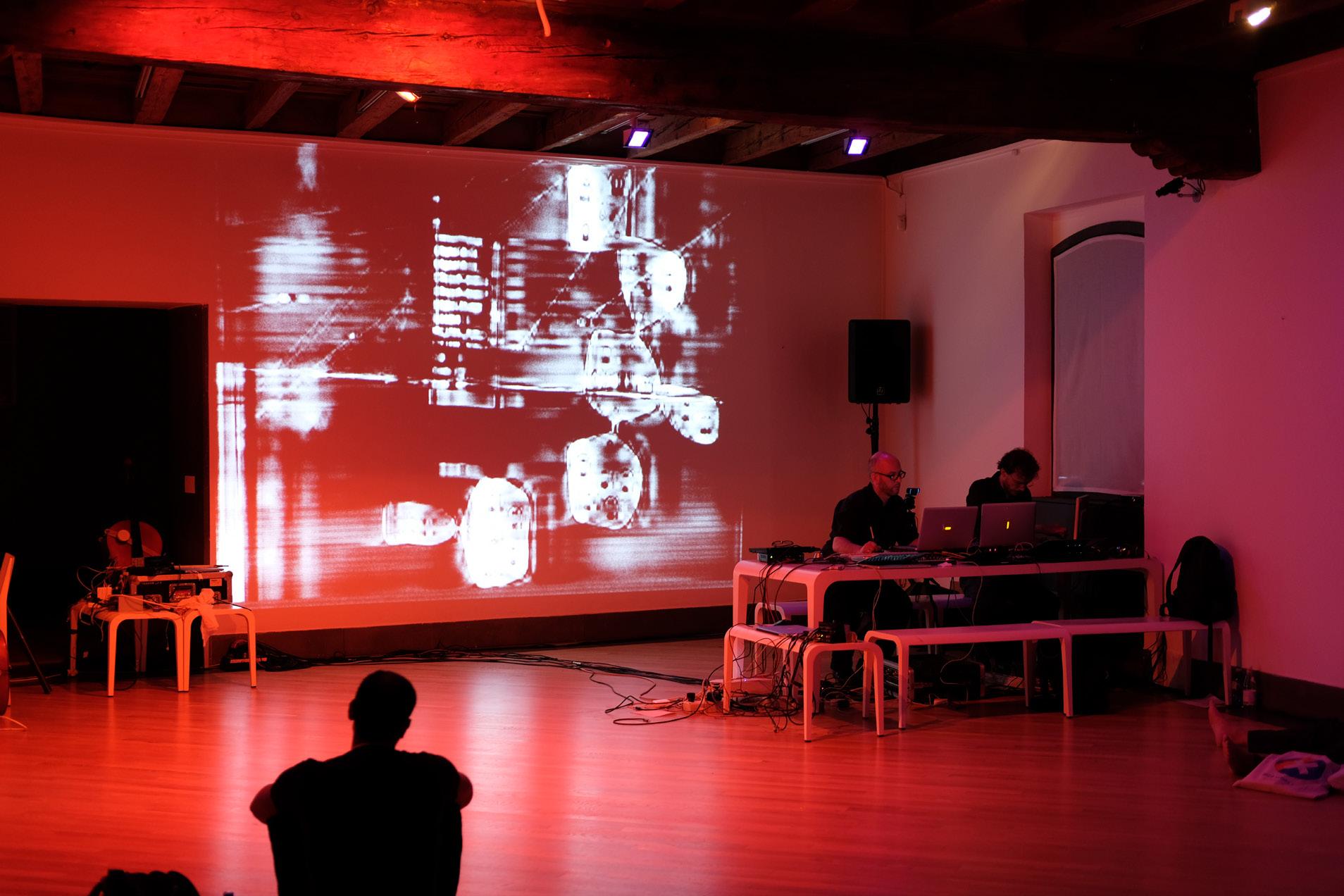
- Welscher Kirche, Graz, 14.11.2014
- Forum Stadtpark, Graz, 29.11.2014
- ZKM, KUBUS, GLOBALE: Tangible Sound Festival, Karlsruhe, Germany, 27.09.2015
- Forum Stadtpack Graz, 04.12.2015
- Impuls Minutenkonzerte, Graz, 28.05.2016
- xCoAx Conference, Bergamo, Italy, 06.07.2016
- esc medien kunst labor, Graz, Art's Birthday, 17.01.2017
- Impuls 2017 Festival for Contemporary Music, 14.02.2017
- BEAST FEaST 2017, Birmingham, UK, 04.2017
- Impuls Minuten Konzerte, Graz 26.05.2018
- elettroAQustica, L'Aquila, 2018 3.10.2018
- InSonic 2018, ZKM, Germany, 07.12.2018
- MUWA - Museum der Wahrnehmung, Graz, Austria, ALMAT - Algorithms That Matter Wokshop, 17.02.2019
- km28, Berlin, Germany 20.09.2019
- Pikselfest, Bergen, Norway 20.11.2021
- Festival Nuova Consonanza, Rome 2022
Anemone Actiniaria xCoAx
Paper
David Pirrò, Hanns Holger Rutz
Proceedings of the xCoAx "Computation Communication Aesthetics & X Conference" 2016
Where Sounds Dwell
Essay
Hanns Holger Rutz, David Pirrò
Appeared in: Rose of the Winds, Nayari Castillo and Kate Howlett-Jones, 2016 ISBN:978-3-9504253-1-4
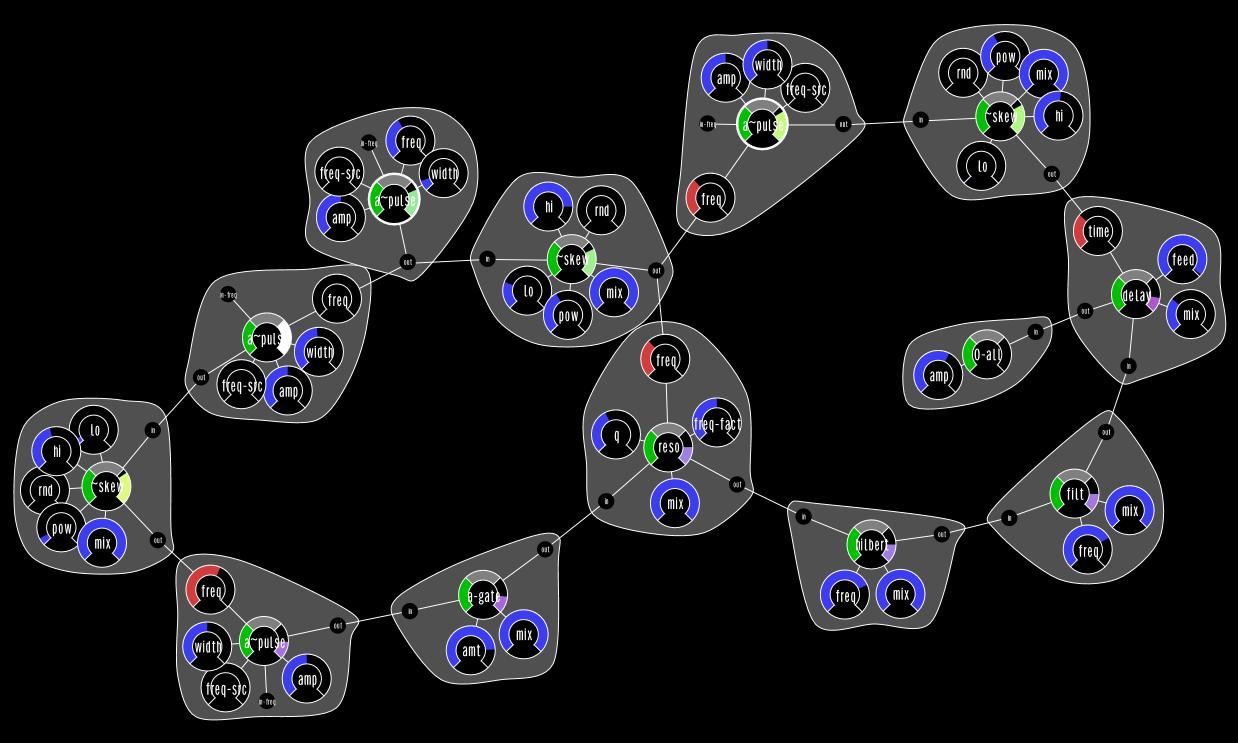

Dancing the Voice
Performative Inquiry
Anna Nowak, Alexander Gottfarb, Christine Ericsdotter, Gerhard Eckel, David Pirrò
This project is an interdisciplinary research process articulating the practices of choreography, phonetics and sound art. It is a co-opertation with the dancers and choreographers Anna Nowak (Poland) and Alexander Gottfarb (Sweden), the lignuist and phonetician Christine Ericsdotter (Sweden), and composer and sound artist Gerhard Eckel (Austria) and David Pirrò (Italy, Austria).
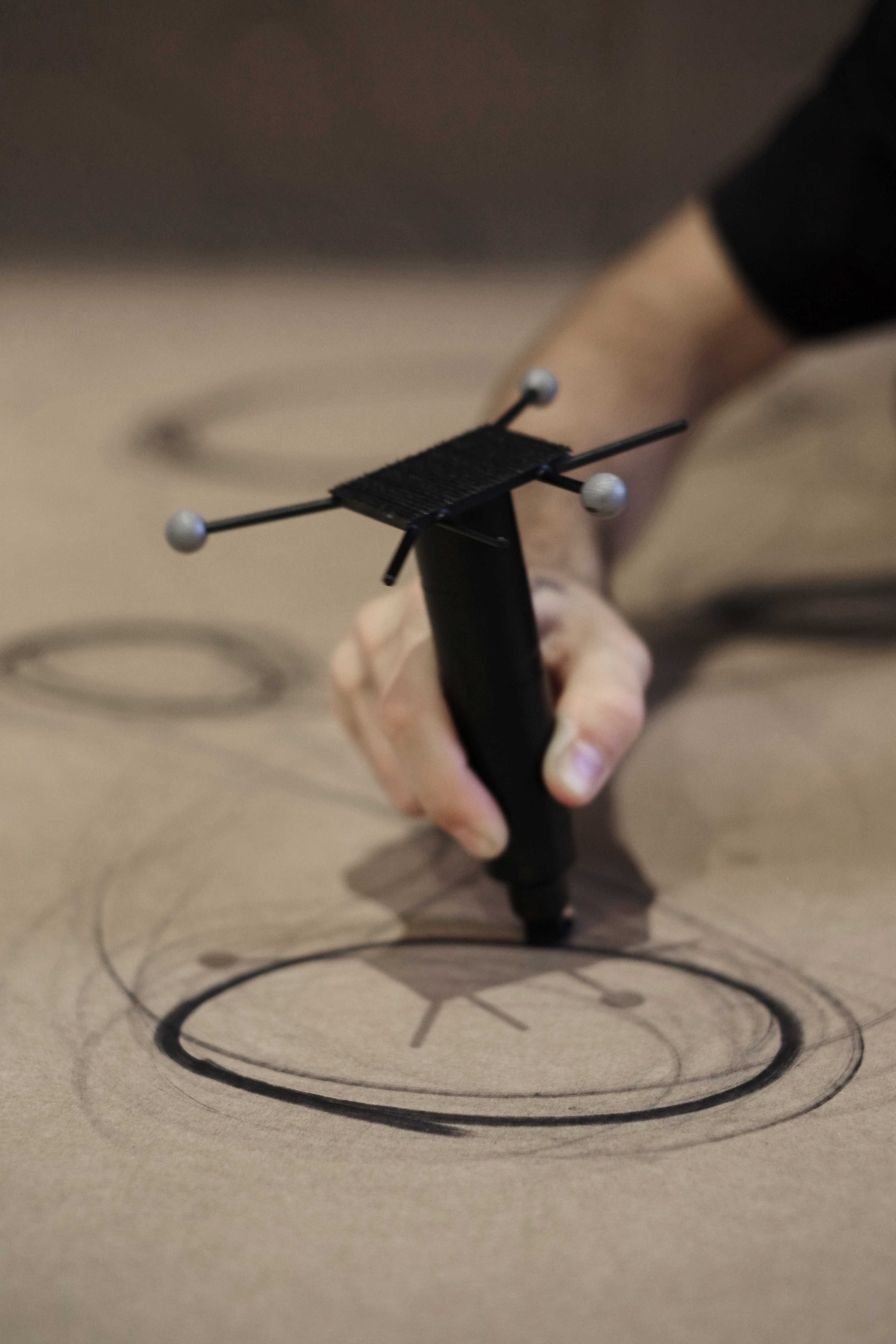
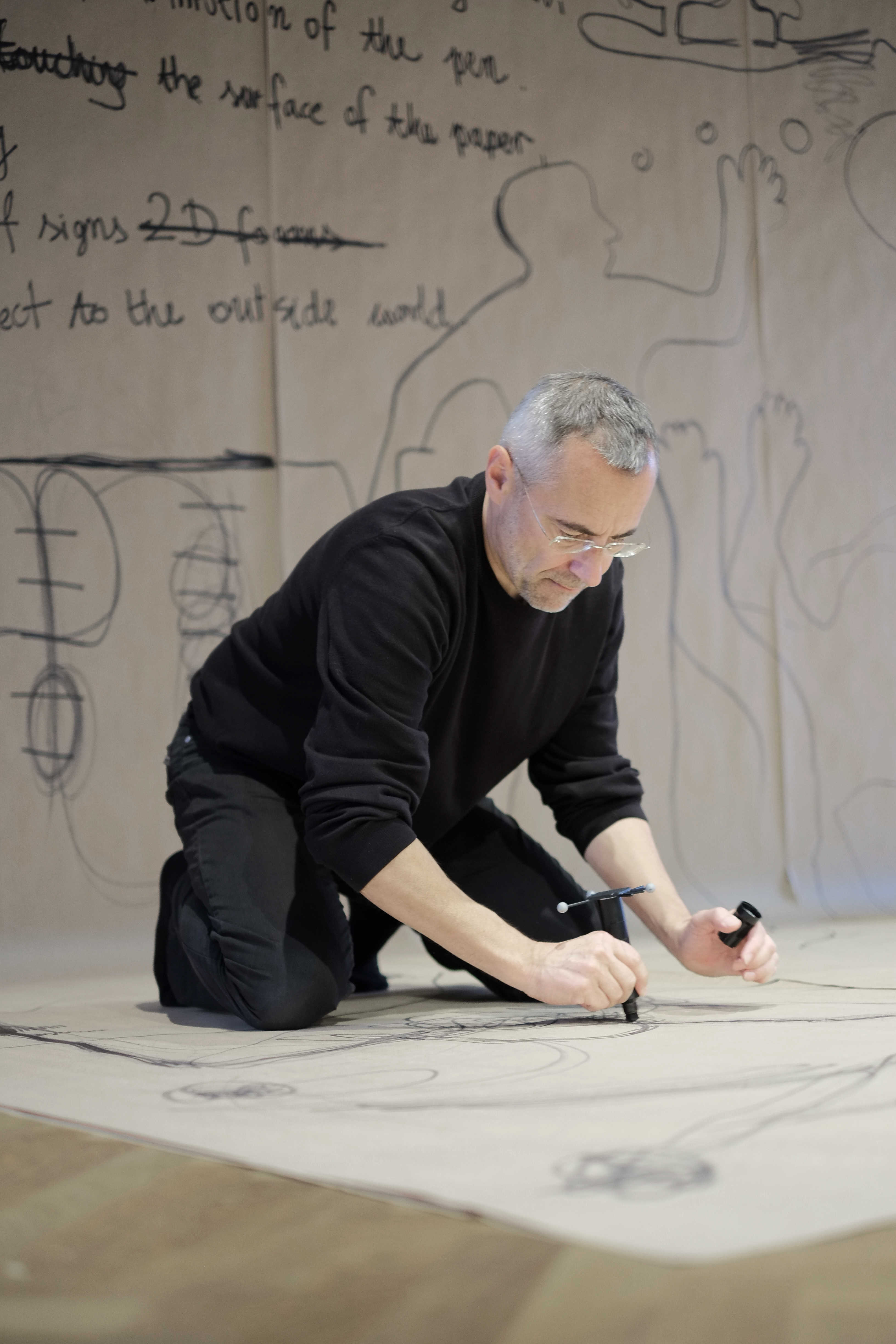
The origins of this work can be traced back to Embodied Generative Music (EGM), a project initiated by Gerhard Eckel in 2007 at the Institute of Electronic Music and Acoustics (IEM), University of Music and Performing Arts Graz, Austria. EGM investigated the relationship between musical and bodily expression by extending dancers’ bodies into virtual instruments using a full-body motion tracking system. This artistic research continued in the interdisciplinary project Dancing the Voice, funded by the Wenner-Gren Foundation: articulating the practices of choreography, phonetics and music composition, this ongoing project produces a series of performative inquiries focussing on the relation of bodily movement and vocal sound. The piece On Traces, performed at the Royal Technical University in Stockholm in the autumn of 2014 and in Tanzquartier Wien in February 2015, was the first open presentation of the research process which then continued in Every move a sound – On the Intricacies of Memory performed in September 2016 in Graz, Austria.
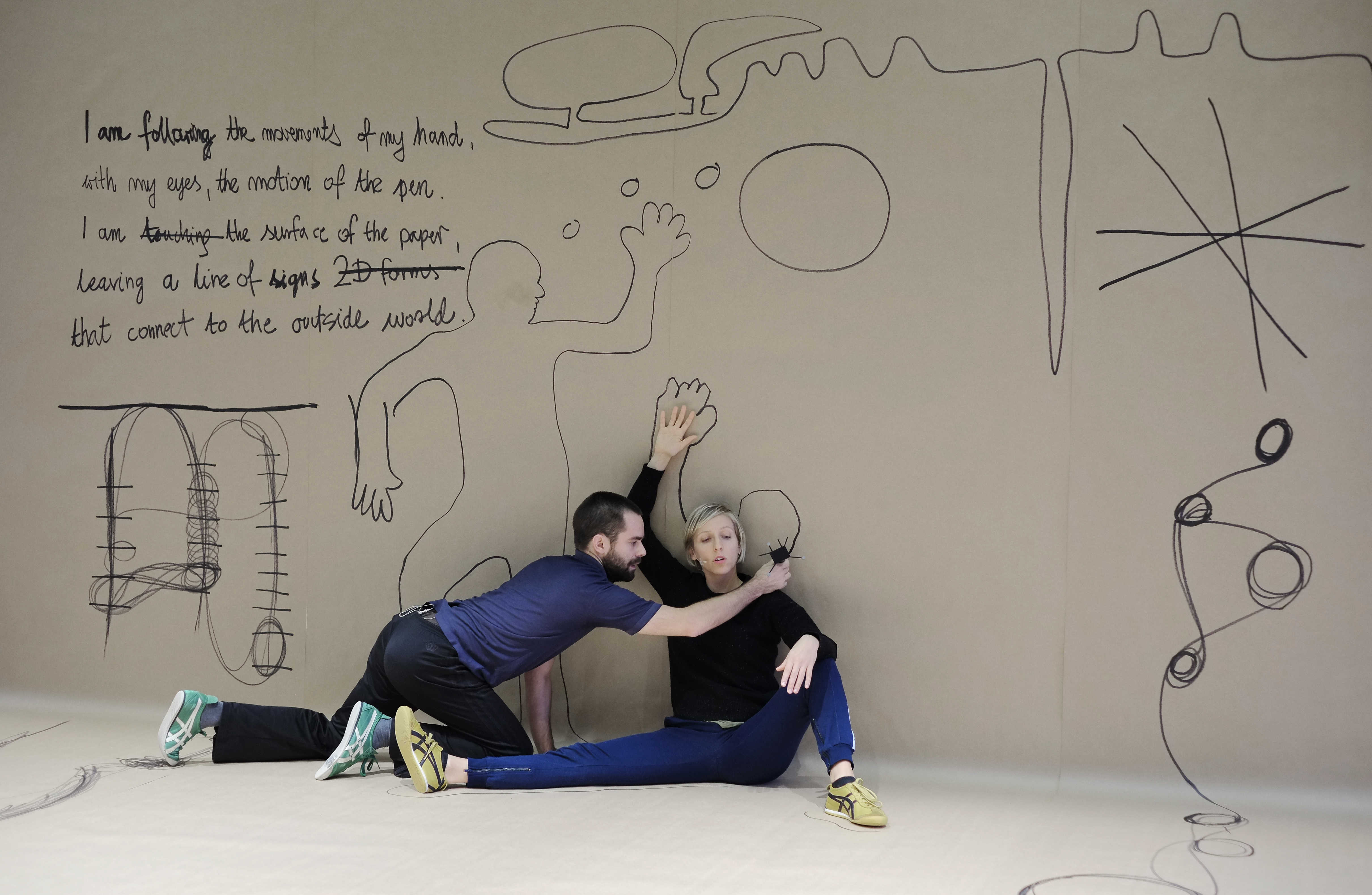
On Traces
Intermedial Performance
Anna Nowak, Alexander Gottfarb, Christine Ericsdotter, Gerhard Eckel, David Pirrò
Performed at the Royal Technical University in in Stockholm in the autumn of 2014 and in Tanzquartier Wien in February 2015
On Traces is the first presentation within the Traces research process.
One of the underlying methods established in this process allows for freely inscribing and retracing sonic motion traces in space. These sonic motion traces are created using a microphone and a motion tracking system. The performer makes a sound and a movement. The motion tracking system records the pathway of the movement simultaneously as the sound is recorded. This tool enables the performers to create a spatial sound playground, using their own voices as building material. In turn, this unique sonic environment is closely linked to the movements, which are traced by one point on their bodies. The specific set up introduced above can be thought of as a kind of a “spatial tape recorder”. An in depth performative interrogation of these movements and sound landscapes led to an intensive exploration of the concepts of the trace, of writing and scanning. At the same time a multitude of questions about perception, attention, language, memory, change and transformation were raised. In On Traces four performers compose and explore a sound environment with the aim of tracing the expressive potential of this space formed of sounds, movements and lines.
On Traces - Tanzquartier Vienna
On Traces - An Artistic Research Process between Choreography and Sound Art
Presentation - Public Lecture
David Pirrò
Presentation in the context of the Public Lecture series Bewegung als kulturelles Phänomen (Movement as cultural Phenomenon) which has taken place in the Summer Semester at the University of Graz
Abstract: "On Traces" is an interdisciplinary research process in which the practices of choreography and sound art are linked together. Here, in a series of performative inquiries, the relationship between physical movement and vocal sound is explored.
In the research process a new method was developed with which it was possible to write sound traces freely in the space and find them again later so they could sound again. In this way performers can create invisible sound landscapes out of their own voices. Simultaneously, in these landscapes the movements of a point on the performers’ bodies are inscribed thereby closely linked to the stored sounds. An in depth performative interrogation of these movement and sound landscapes led to an intensive exploration of the concepts of the trace, of writing and scanning. At the same time a multitude of questions about perception, attention, language, memory, change and transformation were raised.
In On Traces four performers compose and explore a sound environment with the aim of tracing the expressive potential of this space formed of sounds, movements and lines.
The origins of this work go back to the project project Embodied Generative Music (EGM, FWF TRP L399-G13, http://egm.kug.ac.at/), which Gerhard Eckel initiated in 2007 together with Deniz Peters at the Institute for Electronic Music and Acoustics (IEM) at the University for Music and Performing Arts Graz and in which Anna Maria Nowak, Alexander Gottfarb and David Pirrò were also involved. EGM was concerned with the relationship between musical and physical expression, using motion-capture technology to enable dancers to turn their bodies into virtual instruments. The interdisciplinary research process prompted in this way was sponsored by the Wenner-Gren Foundation as part of the Dancing the Voice project in Stockholm. The research that led to On Traces has been supported by the FWF project The Choreography of Sound (PEEK AR41).
Every Move a Sound
Intermedial Performance
Anna Nowak, Alexander Gottfarb, Gerhard Eckel, David Pirrò
Performed at Institute of Electronic Music and Acoustics 17.09.2016
We move and sound. We wear sound and motion sensors. Movements and sounds are joined and recorded as traces. Continuously.
Everybody yarns their sonic filament retractable by anybody. Anytime. Retracing is resounding is reinscribing. One’s own or another’s trace. Inevitably. We fill the performance space with remnants of our actions. This is how the past remains with us. Every action constraining the future. Becoming an obstacle or turning into a potential. The denser the traces, the harder it becomes to read them, to pull a thread out of the plot.
In this environment we engage in extended and repetitive improvisatory processes, fathoming the potential of the collective instrument we are developing since years. We aim at establishing a performance practice in which movement and sound can coexist without exploiting or betraying each other.
Every move a sound – On the Intricacies of Memory is a production by Kunstverein Archipelago.
With the support of: Bundeskanzleramt Österreich MA 7 – Kulturabteilung der Stadt Wien IEM Graz KTH Stockholm
Composing Interactions
Dissertation - David Pirrò
Abstract - English
This thesis investigates interaction in computer music composition, particularly in the context of performance- oriented generative music practice. The research follows three approaches of inquiry.
The first is a scholarly and theoretical analysis of the concept of interaction and its understanding in the field of computer music. The topic is discussed in relation to theories of perception and cognition in philosophy and cognitive sciences, in particular with the concepts of embodiment and enaction. This approach introduces an understanding of interaction as a temporal process of mutual influence taking place between agents. At this point, the concept of the agent becomes central to this dissertation.
The second direction of research is based on the mathematical theory of dynamical systems. The framework implies a process-based mindset and offers an ecological perspective that emphasises the role of interrelations between elements in a system. In the context of this work, dynamical systems are understood as the most apt language for formulating and understanding processes of interaction.
A third approach consists of personal artistic engagement in the development of interactive computer music environments. This thread interweaves with the former two and allows for continuous aesthetic experimentation : speculations and abstract intuitions are put into perceptible form and, in turn, concepts and formulation can be sharpened by experience. An essential part of this engagement relies on the software framework rattle, which has been developed for the formulation and the real-time simulation of dynamical systems.

The dissertation develops an approach towards interaction that employs the language of dynamical systems to address the agency of generative computer music processes. Eventually, agency is re-interpreted as an essential perceptual quality generative computer music systems should be afforded with to allow for a composition of interactions to emerge.
Zusammenfassung - German
Diese Dissertation untersucht Interaktion im Kontext der Komposition von Computermusik im Allgemeinen sowie der Praxis performance-orientierter generativer Musik im Besonderen. Die Forschung verfolgt drei methodische Ansätze:
Der erste Ansatz besteht in einer wissenschaftlichen und theoretischen Analyse des Konzeptes von Interaktion und dessen Verständnis im Bereich der Computermusik. Dieses Thema wird in Relation mit Theorien von Wahrnehmung und Kognition innerhalb von Philosophie und Kognitionswissenschaften gestellt, insbesondere durch die Konzepte von Embodiment und Enaction. Eingeführt wird eine Auffassung von Interaktion als einem zeitlichen Prozess gegenseitiger Beeinflussung, die zwischen Agenten stattfindet. An dieser Stelle entwickelt sich das Konzept des Agent zu einem zentralen Thema der Dissertation.
Die zweite eingeschlagene Richtung der Forschung basiert auf der mathematischen Theorie dynamischer Systeme. Dieses Bezugssystem gewährt eine prozessbasierte Denkart und eine ökologische Perspektive, welche die Rolle von Wechselbeziehungen zwischen Elementen eines Systems betont. Im Rahmen der vorliegenden Arbeit wird dieser Ansatz als die geeignetste Sprache betrachtet, um Prozesse der Interaktion zu formulieren und zu verstehen.
Ein dritter Ansatz besteht in der persönlichen künstlerischen Beschäftigung mit der Entwicklung interaktiver Computermusik- umgebungen. Dieser Strang wird mit den beiden vorherigen verwoben und ermöglicht das kontinuierliche ästhetische Experimentieren : Vermutungen und abstrakte Intuitionen werden in wahrnehmbare Form überführt, und umgekehrt können Konzepte und Formulierungen durch die Erfahrung geschärft werden. Ein wesentlicher Teil dieser Beschäftigung stützt sich auf das Software-Framework rattle, das für die Beschreibung und Echtzeitsimulation dynamischer Systeme entwickelt wurde.
Diese Dissertation entwickelt einen Standpunkt hinsichtlich Interaktion, welcher die Sprache dynamischer Systeme gebraucht um, die Wirkmächtigkeit generativer Computermusik- prozesse zu erfassen. Schlussendlich wird Wirkmächtigkeit (agency ) als eine essentielle Wahrnehmungsqualität neu interpretiert, mit welchen generative Computermusiksysteme auszustatten sind, um das Komponieren von Interaktionen zu ermöglichen.
Zwischenräume – A Case Study in the Evaluation of Interactive Sound Installations
Georgios Marentakis, David Pirrò, Raphael Kapeller
ICMC Conference 2014
This paper presents a collaborative project revolving around the conception, the realisation, and the qualitative evalua- tion of the interactive sound installation zwischenräume. In the installation interaction is considered in a particular way, in that both the installation and the visitor are regarded as being part of an evolving dynamical system.
First, we will frame the addressed question in the relevant research context. Then the installation and the ideas guiding its realisation will be described. Next, the evaluation methods used in this case study will be presented as well as the first results arising from their application. We finally point out how evaluation results could inform the subsequent refinement of the sound installation and directions for future research. The aspects investigated here are part of broader research project that looks into how evaluation strategies could be integrated in the development lifecycle of interactive sound installations.
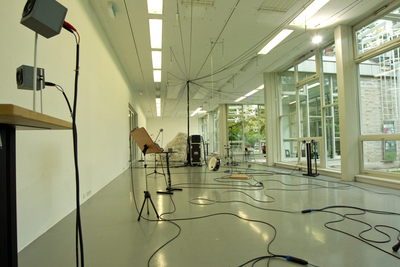
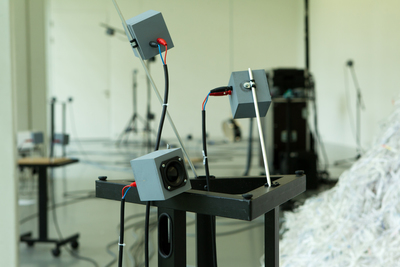
Waveguides for model-based sonification
Vogt, Katharina and Pirrò, David and Höldrich, Robert
Proceedings of the 9th Sound and Music Computing Conference, SMC 2012
Digital waveguides have been used in signal processing for modelling room acoustics. The same technique can be used for model-based sonifications, where the given data serves to construct the three-dimensional sound propagation model. The resulting sounds are intuitive to understand as they simulate real world acoustics. As an example we introduce a digital waveguide mesh based on complex data of computational physics. This approach allows ex- ploring sonically this three-dimensional data and unveiling spatial structures.
Sounds of simulations: data listening space
Vogt, Katharina and Pirrò, David and Rumori, Martin and Höldrich, Robert
Proceedings of the 38th International Computer Music Conference, ICMC 2012

Simulations, as widely used in science, need to be perceptualized. Data from computational physics’ simulations provide an interesting application case for sonification, which was studied in the research project QCD-audio. Within the project, the data listening space was set up as an interactive installation in Nov. 2009 in Graz, Austria. It allowed non-experts to immerge into the sonification of lattice quantum electrodynamics’ data as a virtual auditory scene. Movement and position of one listener at a time were tracked and used in the sonification, establishing a tight connection between virtual and real space. The installation was evaluated in a small test setting following a grounded theory approach.
Acoustic Interface For Tremor Analysis
Pirrò, David and Wankhammer, Alexander and Schwingenschuh, Petra and Sontacchi, Alois and Höldrich, Robert
Proc. of the 18th International Conference on Auditory Display, ICAD 2012
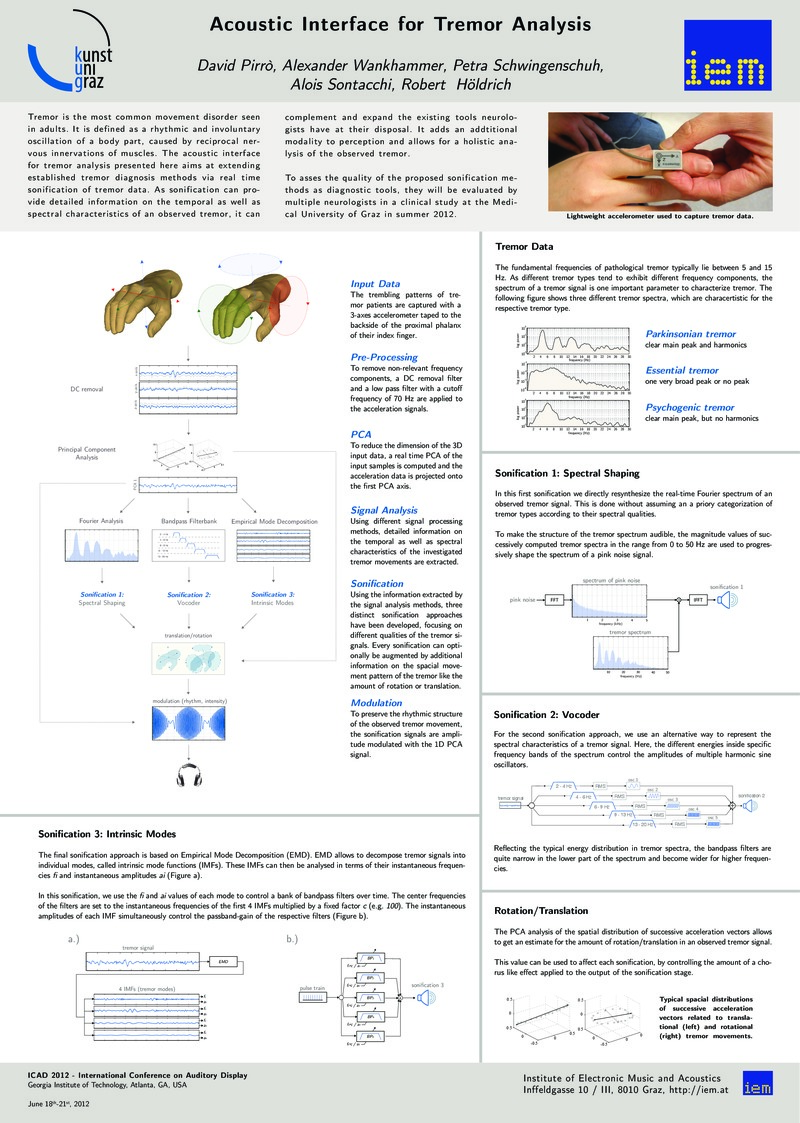
In this paper we introduce new methods for real-time acoustical tremor diagnosis. We outline the problems of tremor diagnosis in the clinical context and discuss how sonification can complement and expand the existing tools neurologists have at their disposal. Based on three preliminary sonification experiments upon recorded tremor movement data, we show how temporal as well as spectral characteristics of tremor can be made audible in real-time. Our first observations indicate that differences among tremor types can be made recognizable via sonification. Therefore, we suggest that the proposed methods could allow for the formulation of more con fi dent diagnoses. At the end of the paper, we will also shortly outline the central topics of future research.
Exploring Sound and Spatialization Design on Speaker Arrays using Physical Modelling
Marentakis, Georgios and Pirrò, David
Proceedings of the 9th Sound and Music Computing Conference, SMC 2012

In the course of the realization of the sound installation Interstices, questions pertaining to the auditory perception of location and extent and the spatial composition of the micro and macro structure of sound were explored in a poietic way. Physical modelling was re-interpreted as a framework to design the spatial and timbral appearance of sounds upon a set of distributed speaker array clusters. This explorative process lead to observations that helped formulating novel research questions within the context of psychoacoustics and auditory display.
Physical modelling enabling enaction: an example
Pirrò, David and Eckel, Gerhard
Proceedings of the International Conference on New Interfaces for Musical Expression, NIME 2011
In this paper we present research which can be placed in the context of performance-oriented computer music. Our research aims at finding new strategies for the realization of enactive interfaces for performers. We present an approach developed in experimental processes and we clarify it by introducing a concrete example. Our method involves physical modelling as an intermediate layer between bodily movement and sound synthesis.
The historical and technological context in which this research takes place is outlined. We describe our approach and the hypotheses on which our investigations ground. The technological frame in which our research took place is briefly described. The piece cornerghostaxis#1 is presented as an example of this approach. The observations made during the rehearsals and the performance of this piece are outlined. Grounding on ours and the performers’ experiences, we indicate the most valuable qualities of this approach, sketch the direction our future experimentation and development will take, pointing out the issues we will concentrate on.
A sonic time projection chamber, Sonified particle detection at CERN
Vogt, Katharina and Höldrich, Robert and Pirrò, David and Rumori, Martin and Rossegger, Stefan and Riegler, Werner and Tadel, Matevz
Proceedings of the 16th International Conference on Auditory Display, ICAD 2010
In a short-term research project at CERN, an auditory display of elementary particle tracks has been developed. Data stems from simulations of the Time Projection Chamber (TPC) in ALICE experiment. Particle detection there is based on pattern recognition algorithms, but is still today double checked with visualization tools. The sonification works with cluster data of the TPC and was designed in analogy to the physics behind the measurement device. Thus it is possible to listen directly to the otherwise silent detector.
Spin quartets, sonification of the XY model
Vogt, Katharina and Höldrich, Robert and Pirrò, David and Gattringer, Christof
Proceedings of the 16th International Conference on Auditory Display, ICAD 2010

We present an intuitive sonification of data from a statistical physics model, the XY-spin model. Topological structures (anti-/vortices) are hidden to the eye by random spin movement. The behavior of the vortices changes by crossing a phase transition as a function of the temperature. Our sonification builds on basic acoustic properties of phase modulation. Only interesting structures like anti-/vortices remain heard, while everything else falls silent, without additional computational effort. The researcher interacts with the data by a graphical user interface. The sonification can be extended to any lattice model where locally turbulent structures are embedded in rather laminar fields.
PhysioSonic - Evaluated Movement Sonification as Auditory Feedback in Physiotherapy
Vogt, Katharina and Pirrò, David and Kobenz, Ingo and Höldrich, Robert and Eckel, Gerhard
Appeared in: "Auditory Display", Lecture Notes in Computer Science, Editors: Ystad, Sølvi and Aramaki, Mitsuko and Kronland-Martinet, Richard and Jensen, Kristoffer, Springer Berlin Heidelberg Also appeared in: Proceedings of the 15th International Conference on Auditory Display (ICAD2009)
We detect human body movement interactively via a tracking system. This data is used to synthesize sound and transform sound files (music or text). A subject triggers and controls sound parameters with his or her movement within a pre-set range of motion. The resulting acoustic feedback enhances new modalities of perception and the awareness of the body movements. It is ideal for application in physiotherapy and other training contexts.
The sounds we use depend on the context and aesthetic preferences of the subject. On the one hand, metaphorical sounds are used to indicate the leaving of the range of motion or to make unintended movements aware. On the other hand, sound material like music or speech is played as intuitive means and motivating feedback to address humans. The sound material is transformed in order to indicate deviations from the target movement.
PhysioSonic has been evaluated with a small study on 12 patients with limited shoulder mobility. The results show a clear benefit for most patients, who also report on PhysioSonic being an enrichment of their therapeutic offer.
Quantum Harmonic Oscillator Sonification
Saranti, Anna and Eckel, Gerhard and Pirrò, David
Appeared in: "Auditory Display", Lecture Notes in Computer Science, Editors: Ystad, Sølvi and Aramaki, Mitsuko and Kronland-Martinet, Richard and Jensen, Kristoffer, Springer Berlin Heidelberg Also appeared in: Proceedings of the 15th International Conference on Auditory Display (ICAD2009)
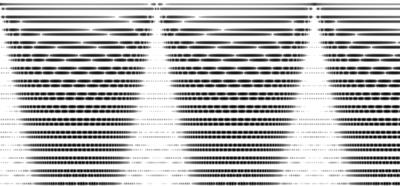
This work deals with the sonification of a quantum mechanical system and the processes that occur as a result of its quantum mechanical nature and interactions with other systems. The quantum harmonic oscillator is not only regarded as a system with sonifiable characteristics but also as a storage medium for quantum information. By representing sound information quantum mechanically and storing it in the system, every process that unfolds on this level is inherited and reflected by the sound. The main profit of this approach is that the sonification can be used as a first insight for two models: a quantum mechanical system model and a quantum computation model.
Stop challenging technology! Towards content-based audio production
Paper
David Pirrò, Gerhard Eckel, Martin Rumori
In Proceedings of the 4th International Conference on Spatial Audio, VDT IEM, Graz 2017, pp. 24-28
Abstract
Production tools that hide their technical complexity stimulate an understanding of creation that centres ‘content’ rather than materiality, or form. What are the consequences when such user-oriented tools become the predominant means for conceiving auditory experience? Many scholarly interpretations highlight as an advantage that ‘content’ creators do not have to deal with peculiarities of different sound projection methods anymore. However, assuming a universal model for auditory space effectively shadows its exploration. This paper illuminates that the focus on geometric representation may impede experiential sonic practice. The discussion departs from the main arguments of the call for this ICSA’s Student 3D Audio Competition. We aim to identify implicit demarcations that contradict the transdisciplinary nature of engineering in an artistic context.
Motion-Enabled Live Electronics
Eckel, Gerhard and Pirrò, David
Sound and Music Computing Conference, SMC 2009
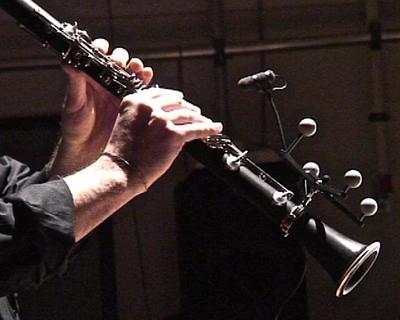
Motion-Enabled Live Electronics (MELE) is a special approach towards live electronic music aiming at increasing the degree of the performers’ embodiment in shaping the sound processing. This approach is characterized by the combination of a high-resolution and fully-3D motion tracking system with a tracking data processing system tailored towards articulating the relationship between bodily movement and sound processing. The artistic motivations driving the MELE approach are described, an overview of related work is given and the technical setup used in a workshop exploring the approach is introduced. Brief descriptions of the pieces realized in the workshop and performed in the final concert inform the presentation of the conclusions drawn from the workshop.
On Artistic Research in the Context of the Project Embodied Generative Music
Eckel, Gerhard and Pirrò, David
Proceedings of the 35th International Computer Music Conference, ICMC 2009
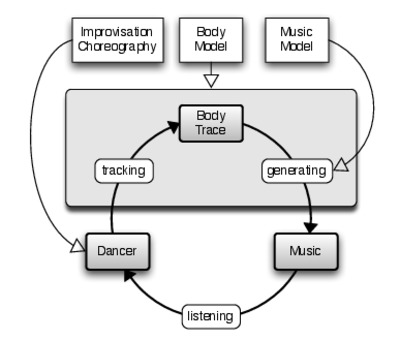
We describe an artistic research process leading to the intermedial piece Bodyscapes in the context of the artistic and scientific research project Embodied Generative Music, which aims at furthering the understanding of the relationship between bodily and musical expression.
Towards a multi-layer architecture for multi-modal rendering of expressive actions.
De Poli, G. and Avanzini, F. and Rodà, A. and Mion, L. and D'Incà, and Trestino, C. and Pirrò, D. and Luciani, A. and Castagne, N.
Proc. 2nd Int. Conf. on Enactive Interfaces (ENACTIVE05), 2009

Expressive content has multiple facets that can be conveyed by music, gesture, actions. Different application scenarios can require different metaphors for expressiveness control. In order to meet the requirements for flexible representation, we propose a multi-layer architecture structured into three main levels of abstraction. At the top (user level) there is a semantic description, which is adapted to specific user requirements and conceptualization. At the other end are low-level features that describe parameters strictly related to the rendering model. In between these two extremes, we propose an intermediate layer that provides a description shared by the various high-level representations on one side, and that can be instantiated to the various low-level rendering models on the other side. In order to provide a common representation of different expressive semantics and different modalities, we propose a physically-inspired description specifically suited for expressive actions.
Interviews
Rivista Musica+
Interview for the Magazine "Rivista Musica+", published by the Conservatory of Music "Alfredo Casella" in L'Aquila (IT)
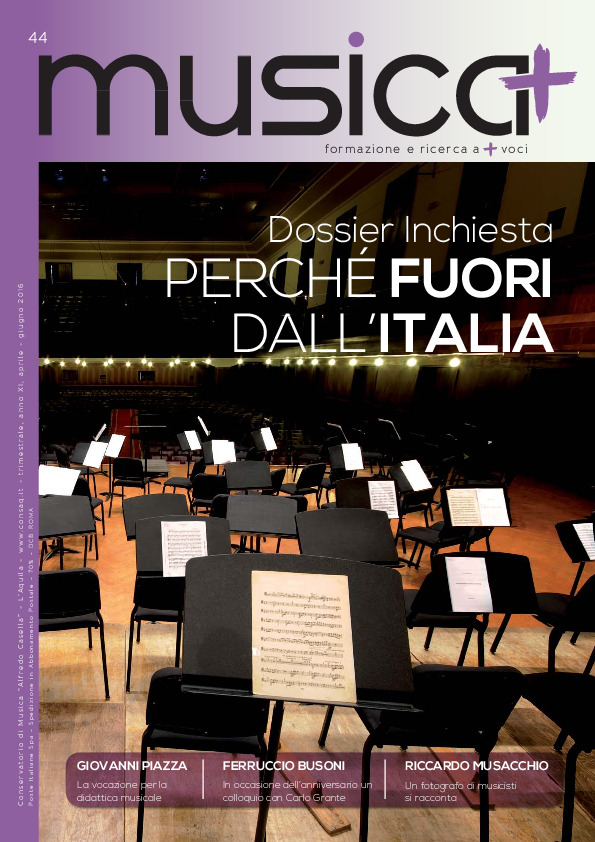
Asimmetrie
Il souno dei dati The sound of data
April 2018, pages 44 - 45
Magazine of the INFN, Istitute Nazionale di Fisica Nucleare (National Institute for Nuclear Physics)
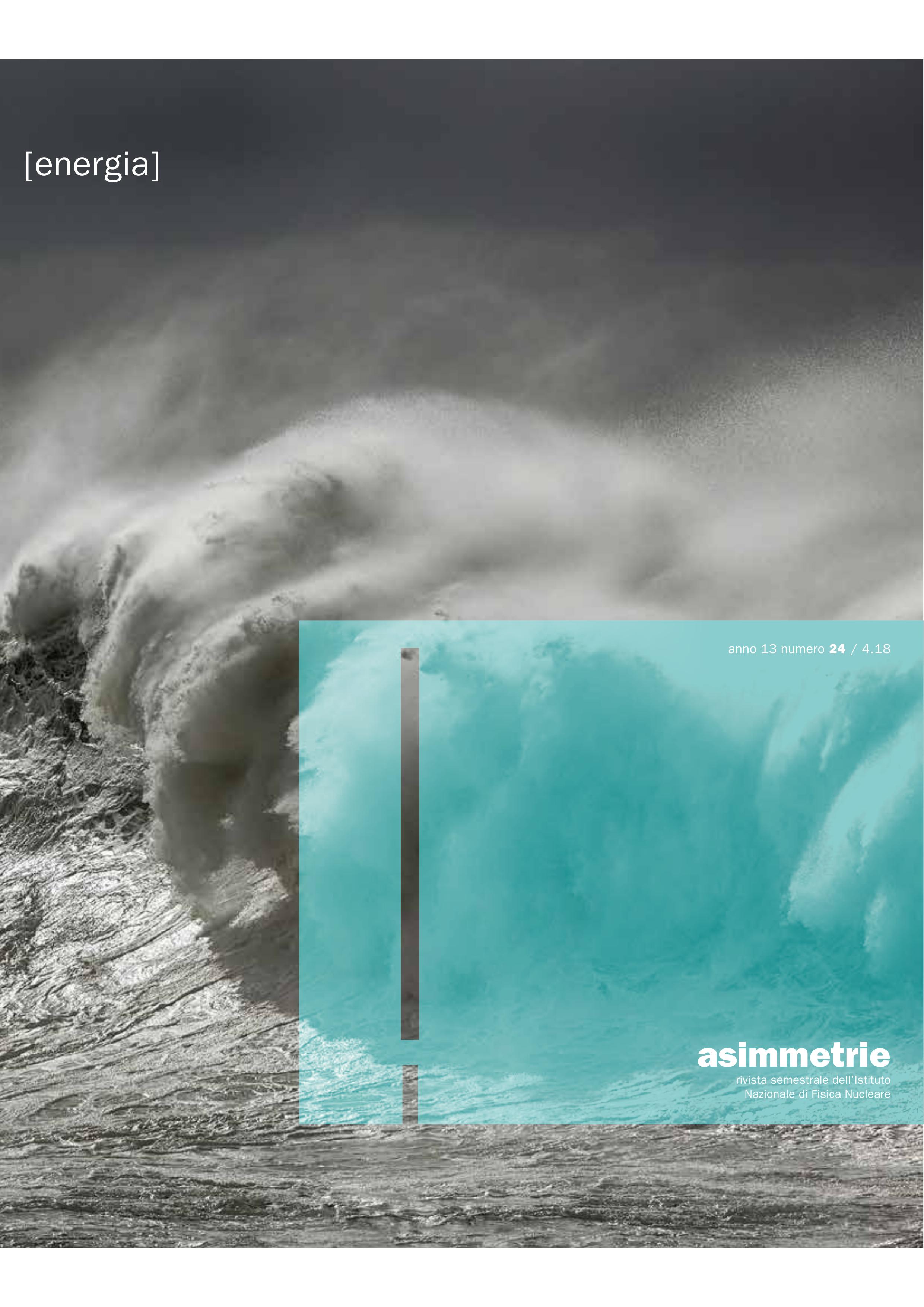
Staircase
by Gerhard Eckel, David Pirrò, Martin Rumori, Gerriet K. Sharma, Christos Zachos
Permanent generative sound installation at technical university graz Studienzentrum, Inffeldgasse 10, 8010 Graz, Austria

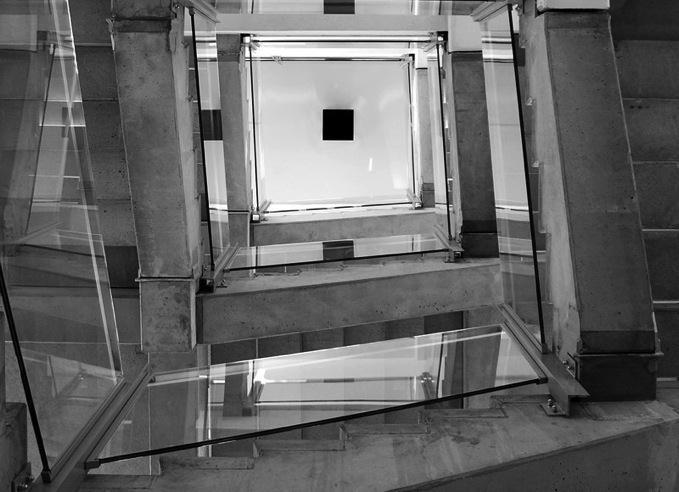
Imperfect Reconstruction
Space, Video and Sound Installation
Lisa Horvath, David Pirrò Hanns Holger Rutz
Graz Austria, ESC medien kunst labor November 2016
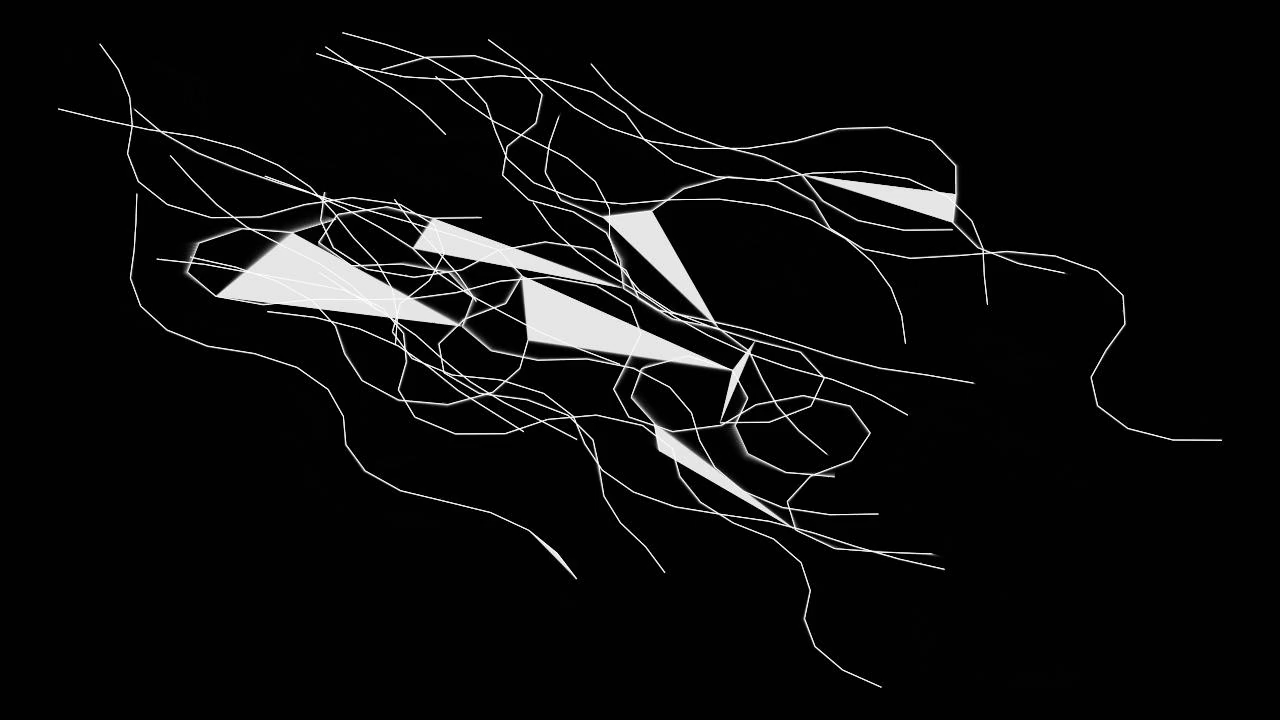
An algorithmic project by Lisa Horvath, David Pirrò, Hanns Holger Rutz.
The image of coding/decoding often includes the ideal of perfect reconstruction. Something real—an experience, a thought, a movement—can be transformed into a finite set of elements that may then be transported and unfolded as an evocation of that original experience or movement. Something is communicated (duplicated and made equal). It bothers us when the reconstruction is not complete, when the distance between the pairs of conceptualisation/perception, intention/interpretation… is not annulled: somebody did not understand.
What we are interested in for this exhibition are those distances and gaps that produce imperfection, understood as the resistance of thoughts and movements to become determinate; understood as their durational and iterative configuration. Located at the intersection of computer art and sound art, we are primarily interested in algorithmic movements. In algorithmic practices pieces of code assume the production of forms and establish mutual writing processes between human and computer.
Increasingly, algorithms are given authority to make decisions about our lives. Dystopian scenarios stretch to the expendability of humankind altogether because so-called artificial intelligence might soon outpace our slow biological evolution. But going beyond the traditional view of algorithms as a tight interlocking of logic and control structures, algorithms involve speculative computations, the production of materials that are yet “continually unrealized” (Parisi). In other words, imperfection (incompletion) may well lie at the centre of algorithms and endow them with an intrinsic poiesis, making them an ally for the retention of freedom.
How to make imperfect reconstructions? One strand we have been working with in the past years is the use of similarity as a motor for algorithmic movement. For example, a computer can be instructed to find among a set of sounds those that are particularly similar or dissimilar to other sounds or it may be instructed to evolve sound structures to approximate a given sound. What becomes important is that processes are instantiated that produce trajectories which then become themselves the aesthetic objects and reveal something about their inner motions rather than focusing on the target sounds. Another strand is the introduction of reconfigurations, the addition or shift of elements and relations between elements. For example, trajectories may be translated from the audible to a graphical domain or to a textual domain and back again, foregrounding gaps inherent to such translations. In this exhibition, we will be especially working with the algorithmic treatment of text and language. A third approach is the coupling of systems, something that we explored in the project ‘Anemone Actiniaria’. Once the two machines that we have been developing for several years are oriented towards each other and composed, “a new machine arises” (von Foerster).
In ‘Imperfect Reconstructions’, we will be creating an overall installation that decomposes into a number of corresponding works, combining sound with image, text and video. There is a focus on the durational and iterative aspects of imperfection: We want to show the stages through which pieces emerge and how the reconfigurations take place. Like a Langzeitbelichtung, things that happen sequentially or that are dislodged become integrated. The paths of reconstruction thus also obtain something “forensic”, they form speculative (hi)stories
Imperfect Reconstruction: an algorithmic project
Catalogue
Lisa Horvath, David Pirrò Hanns Holger Rutz
ISBN:978-3-9503349-1-3
Graz Austria, 2017
A catalogue of the project has been produced in May 2017. It is published by esc media art laboratory (ISBN 978-3-9503349-1-3), and distributed via Reagenz Verlag. The book was realised with the generous help of the Department of Culture of the City of Graz and the University of Music and Performing Arts Graz. The catalogue was edited by Hanns Holger Rutz, with layout and design by Nayarí Castillo.
It features contributions by Luc Döbereiner, Gerhard Eckel, Klemens Fellner, Tamara Friebel, Reni Hofmüller, Lisa Horvath, Veronika Mayer, David Pirrò, Martin Rumori, Hanns Holger Rutz, Reiko Yamada.
The catalogue has a 20x20 cm format and 64 pages. It was created as a 300 copies edition with individual and numbered covers.
The catalogue was publicly presented on June 1st at esc Graz.

Inner Space
InnerSpace is part of a group of works created under the umbrella project Imperfect Reconstruction (https://www.researchcatalogue.net/view/245942/245943) The image encoding/decoding is often associated with the ideal of perfect reconstruction. Experiencing something, an idea can turn into a movement, a finite set of elements, which can then be transported and unpacked as a reference to the original experience or movement. Imperfection is thus taken as a failure, for example a failure to understand. What interested us in this project were the distances and gaps that produce imperfection, defined as resistance of thoughts and movements to become determinate. InnerSpace is conceived as an 8-channels video installation for small format monitors. A complementary set of quasi-fixed video miniatures are recalled by a slightly indeterminate algorithm. As the name suggests, it was originally situated in an intimate, half-closed space, but it also refers to the fact that each piece is, in one way or another, connected to our noö-topology, the spatial particularity of our mind, the way we internalise the algorithmic.
Showed at:
- xCoAx 2017 Lisbon
- From Science to Art and Back, Stockholm October 2017
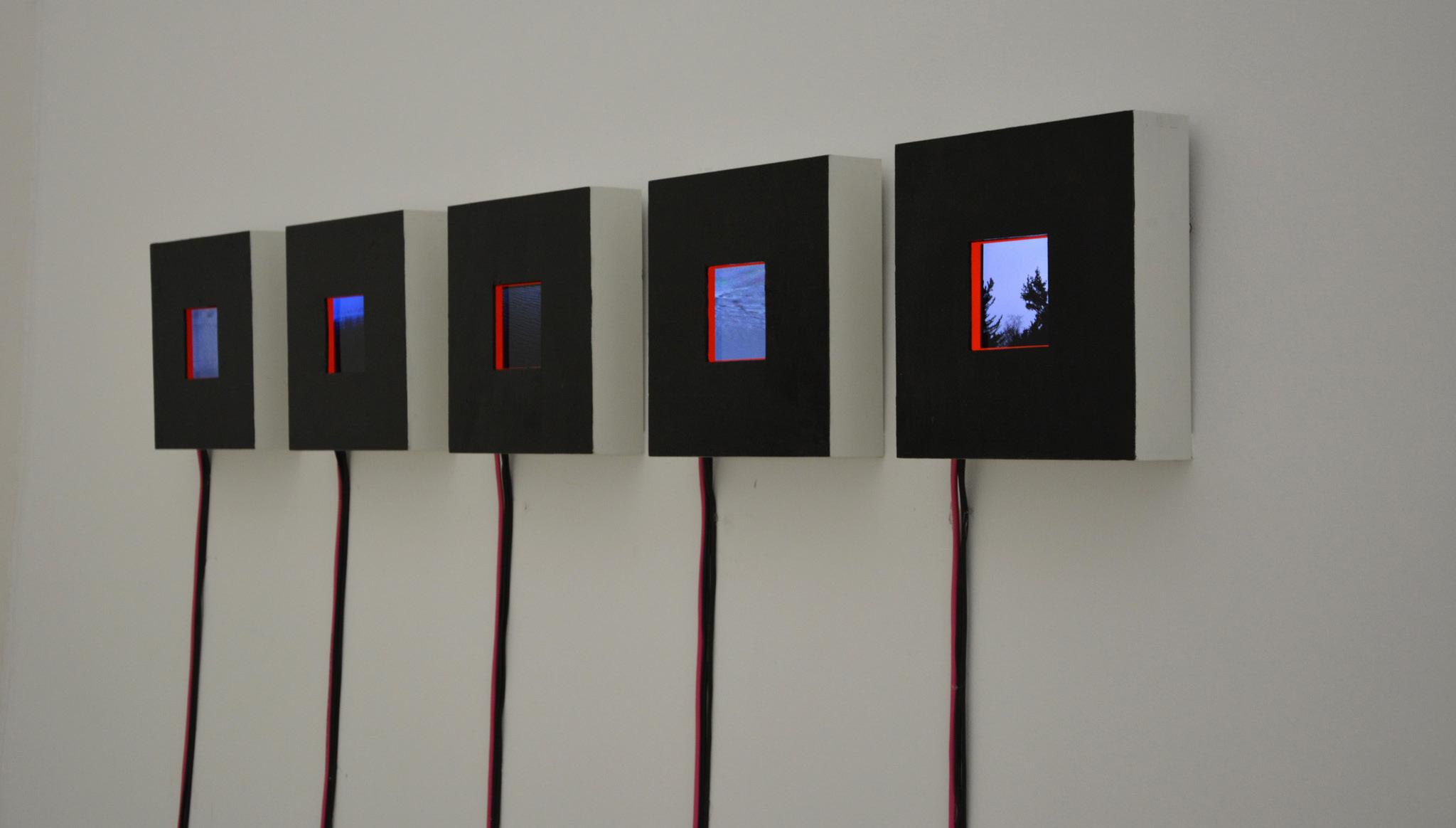
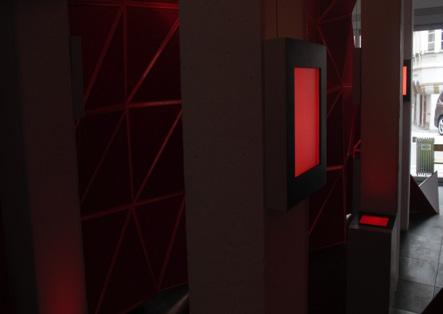

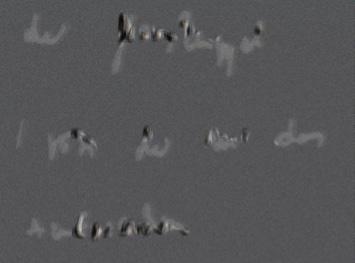

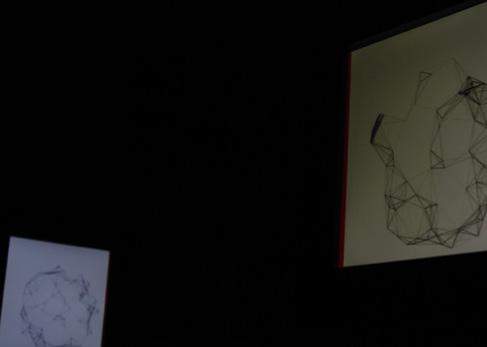
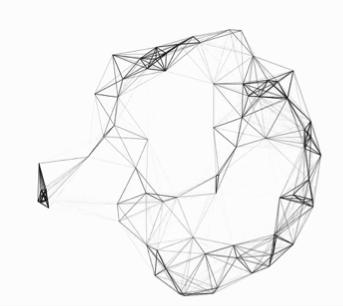
Stessa Dissonanza
Live-Electronic Performance
Antonia Manhartsberger, David Pirrò
Performance on Martin Rumori's multichannel installation "Promenade" in the context of the 2018 Art's birthday, 17.01.2018 at the esc medien kunst labor in Graz
altraconsonanza
improvisation collective
David Pirrò & Martin Rumori
altraconsonanza is an improvisation collective bringing together diverse means of producing and controlling sound. Our experimental arrangement contrasts generative algorithms with analogue chaotic circuitry, complemented by environmental recordings. As disparate these instruments are, as diverse are the aesthetics they rest upon and as unequal are the modes of listening they afford. We take all these elements and patch them together; not only conceptually but physically: signals are exchanged between all involved interfaces, effectively affecting, influencing and superimposing each other. We re-compose them into an intractable field of possibilities that is navigated using the senses and the intelligence of the performers and the audience alike.
The name altraconsonanza is meant as an homage to the Italian pioneers who formed the Nuova Consonanza collective in the 1960s.
altraconsonanza is David Pirrò and Martin Rumori, occasionally complemented by other musicians.
Recent Performances
- aNOther festival, 6.10.2023. Vienna
- Sweet Spot, 14.01.2025, Salzburg
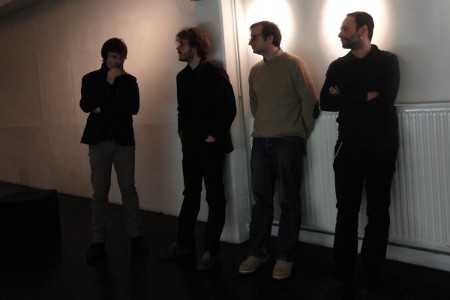
Various performances starting from 2012 to e.g. at the 47. internationale ferienkurse für neue musik, darmstadt/germany
Io, frammento dal Prometeo - Luigi Nono
Live-Electronics
with Cantando Admont, Markus Wallner and Martin Rumori
Salzburger Festspiele, 21. Juli 2025, Kollegienkirche

Martin Rumori and me will realize the Live-Electronics. The sound direction is carried out jointly with Markus Wallner. The live electronics are entirely realized using free and open-source software (SuperCollider). After the performance, we intend to publish the implementation of the live electronics.
agent 1
Live-Elektronik
Crosstalks: KULTUM Cubus, Graz, 25.04.2024
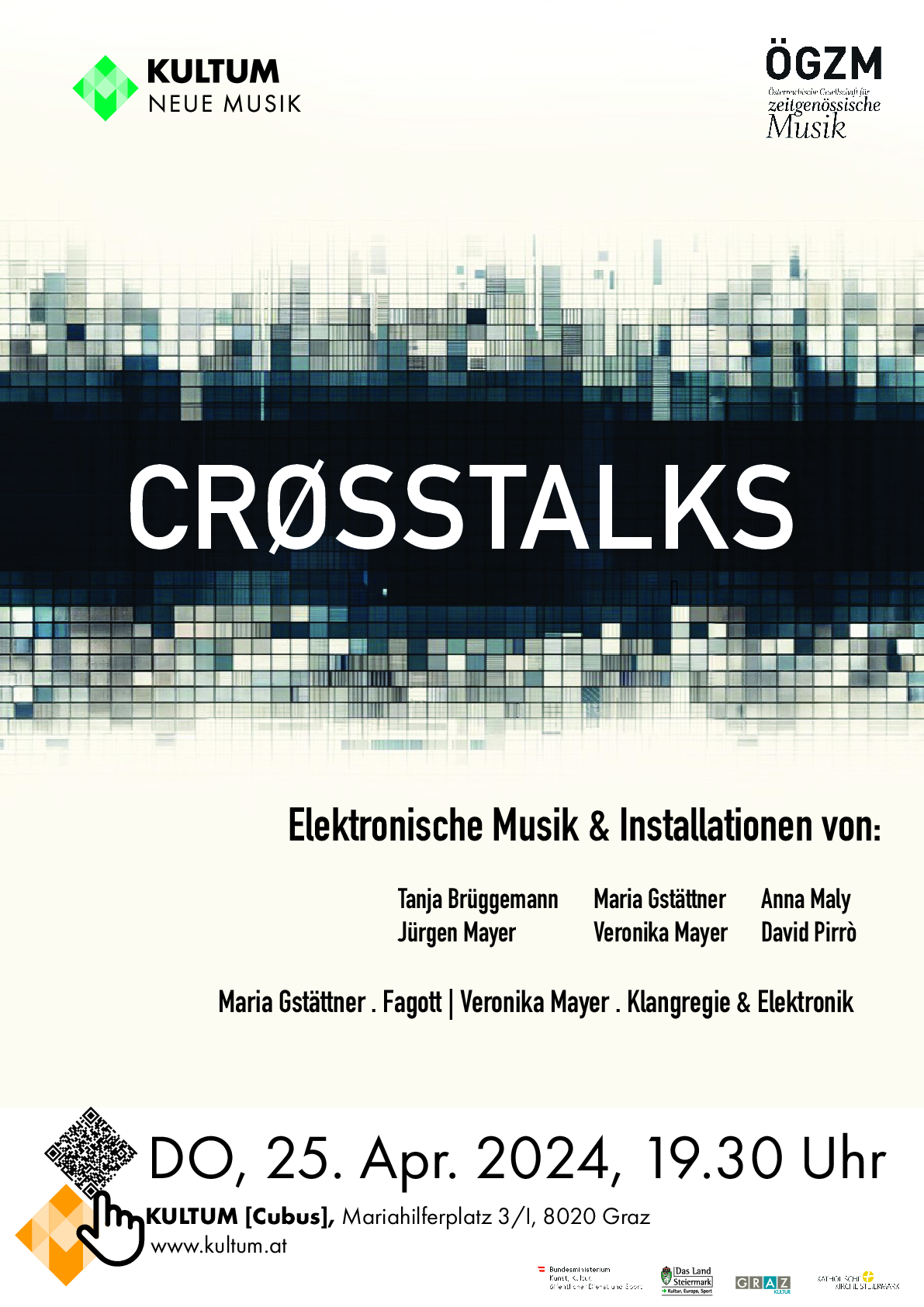
In the context of the “Speculative Sound Synthesis” rather then an “unfounded conjecture”, speculation is viewed as a leap of imagination. As A. N. Whitehead describes, speculation is taking “off from the ground of a particular observation; it makes a flight in the thin air of imaginative generalization; and it lands again for renewed observation”. To speculate is to venture into uncharted territories and always return to familiar ground before taking the next leap. It is an iterative process where risks are embraced while remaining open to unexpected discoveries and encounters. With this emphasis on experience, speculation is tied to a way to perceive, to be in the world and engage with it that is material and radically subjective rather than detached and purely objective.
Agent 1 embodies some of these concepts through a generative reactive process. In this setup, four microphone-loudspeaker pairs are positioned in a space to create sound through feedback loops. Throughout the performance, the interactions within these couplings are modulated to explore diverse behaviors and sonic textures. This intertwining of listening and sound production results in four parallel processes that are interconnected, each attempting to define its identity.
Publication List
- D. Pirrò. "Staging collisions: On behaviour." In Michael Schwab, editor, Transpositions Aesthetico-Epistemic Operators in Artistic Research. Leuven University Press, 2018.
- Rutz, H., Pirrò, D., "Körper." In xCoAx 2018 - Proceedings of the Sixth Conference on Computation Communication Aesthetics & X (6th Conference on Computation, Communication, Aesthetics & X, pp. 176-180, 2018
- Eckel, G., Schwab, M., Pirrò, "Da.ta (Transpositions)", D., MER. Paper Kunsthalle, Ghent, Belgium, 2017 ISBN:978-94-9232-172-5
- Rumori, M., Pirrò, D., Eckel, G., "Stop challenging technology! Towards content-based audio production." In Proceedings of the 4th International Conference on Spatial Audio, VDT IEM, Graz 2017, pp. 24-28
- Marian Weger, David Pirrò, and Robert Höldrich. "Evaluation of an acoustic interface for tremor analysis." In Proceedings of the 14th Sound and Music Computing Conference, pages 234–241, Espoo, Finland, 2017.
- Georgios Marentakis, David Pirrò, and Marian Weger. "Creative evaluation." In Proceedings of the 2017 Conference on Designing Interactive Systems, pages 853–864. ACM, 2017.
- D. Pirrò "Composing Interactions." PhD Thesis, Institute of Electronic Music and Acoustics University of Music and Performing Arts Graz, Austria, 2017
- Lisa Horvath, David Pirrò and Hanns Holger Rutz "Imperfect Reconstruction: an algorithmic project", 2017 ISBN:978-3-9503349-1-3
- Hanns Holger Rutz and David Pirrò. "Anemone actiniaria." In Proceedings of the 2016 xCoAx Conference, Computation, communication, Aesthetics and X, pages 404–408, 2016.
- Marian Weger, David Pirrò, Alexander Wankhammer, and Robert Höldrich. "Discrimination of tremor diseases by interactive sonification." In 5th Interactive Sonification Workshop (ISon), volume 12, 2016.
- Rutz, H. H., Pirrò, D., "Where Sounds Dwell" In Castillo, N., Howlett-Jones, K., (eds), Rose of the Winds, 2016 ISBN:978-3-9504253-1-4
- Georgios Marentakis, David Pirro, and Raphael Kapeller. "Zwischenräume-a case study in the evaluation of interactive sound installations." In Proceedings of the International Computer Music Conference ICMC, 2014.
- Katharina Vogt, David Pirrò, and Robert Höldrich. "Waveguides for model-based sonification." In Proceedings of the 9th Sound and Music Computing Conference, Copenhagen, Denmark, 2012.
- Gerhard Eckel, Martin Rumori, David Pirrò, and Ramón González-Arroyo. "A framework for the choreography of sound." In Proceedings of the 38th International Computer Music Conference, pages 404–511, Ljubljana, Slovenia, 2012.
- Georgios Marentakis and David Pirrò. "Exploring sound and spatialization design on speaker arrays using physical modelling." In Proceedings of the 9th Sound and Music Computing Conference, pages 55–60, Copenhagen, Denmark, 2012.
- David Pirrò, Alexander Wankhammer, Petra Schwingenschuh, Alois Sontacchi, and Robert Höldrich. "Acoustic interface for tremor analysis." In Proc. of the 18th International Conference on Auditory Display, pages 210–213, Atlanta, Georgia, 2012.
- Katharina Vogt, David Pirrò, Martin Rumori, and Robert Höldrich. "Sounds of simulations: data listening space." In Proceedings of the 38th International Computer Music Conference, pages 525–530, Ljubljana, Slovenia, 2012.
- David Pirrò and Gerhard Eckel. "Physical modelling enabling enaction: an example." In Proceedings of the International Conference on New Interfaces for Musical Expression, pages 461–464, Oslo, 2011.
- Katharina Vogt, David Pirrò, Ingo Kobenz, Robert Höldrich, and Gerhard Eckel. "Physiosonic-evaluated movement sonification as auditory feedback in physiotherapy." In In Sølvi Ystad, Mitsuko Aramaki, Richard Kronland-Martinet, and Kristoffer Jensen, editors, Auditory display, volume 5954 of Lecture Notes in Computer Science pages 103–120. Springer, 2010.
- Katharina Vogt, Robert Höldrich, David Pirrò, and Christof Gattringer. "Spin quartets, sonification of the xy model." In Proceedings of the 16th International Conference on Auditory Display, pages 97–102, Washington, DC, 2010.
- Niemüller, Tim, Alexander Ferrein, Gerhard Eckel, David Pirro, Patrick Podbregar, Tobias Kellner, Christof Rath, and Gerald Steinbauer. "Providing ground-truth data for the nao robot platform." In Robot Soccer World Cup, pp. 133-144. Springer, Berlin, Heidelberg, 2010.
- Katharina Vogt, Robert Höldrich, David Pirrò, Martin Rumori, Stefan Rossegger, Werner Riegler, and Matevz Tadel. "A sonic time projection chamber, sonified particle detection at cern." In Proceedings of the 16th International Conference on Auditory Display, pages 103–108, Washington, DC, 2010.
- Anna Saranti, Gerhard Eckel, and David Pirrò. "Quantum harmonic oscillator sonification." In Sølvi Ystad, Mitsuko Aramaki, Richard Kronland-Martinet, and Kristoffer Jensen, editors, Auditory Display, volume 5954 of Lecture Notes in Computer Science, pages 184–201. Springer Berlin Heidelberg, 2010.
- Eckel, G., Pirro, D., & Sharma, G. K. "Motion-enabled live electronics." In Proceedings of the 6th Sound and Music Computing Conference, Porto, Portugal, 2009
- Gerhard Eckel and David Pirrò. "On artistic research in the context of the project embodied generative music." In Proceedings of the 35th International Computer Music Conference, pages 541–544, Montréal, 2009.
- De Poli, Giovanni, Federico Avanzini, Antonio Rodà, Luca Mion, Gianluca d'Inca, Cosmo Trestino, Carlo de Pirro, Annie Luciani, and Nicolas Castagné. "Towards a multi-layer architecture for multi-modal rendering of expressive actions." In Proc. 2nd Int. Conf. on Enactive Interfaces (ENACTIVE05), pages 541–544, Genova, Italy, 2005. 2005.
Publication List
- D. Pirrò. "Staging collisions: On behaviour." In Michael Schwab, editor, Transpositions Aesthetico-Epistemic Operators in Artistic Research. Leuven University Press, 2018.
- Rutz, H., Pirrò, D., "Körper." In xCoAx 2018 - Proceedings of the Sixth Conference on Computation Communication Aesthetics & X (6th Conference on Computation, Communication, Aesthetics & X, pp. 176-180, 2018
- Eckel, G., Schwab, M., Pirrò, "Da.ta (Transpositions)", D., MER. Paper Kunsthalle, Ghent, Belgium, 2017 ISBN:978-94-9232-172-5
- Rumori, M., Pirrò, D., Eckel, G., "Stop challenging technology! Towards content-based audio production." In Proceedings of the 4th International Conference on Spatial Audio, VDT IEM, Graz 2017, pp. 24-28
- Marian Weger, David Pirrò, and Robert Höldrich. "Evaluation of an acoustic interface for tremor analysis." In Proceedings of the 14th Sound and Music Computing Conference, pages 234–241, Espoo, Finland, 2017.
- Georgios Marentakis, David Pirrò, and Marian Weger. "Creative evaluation." In Proceedings of the 2017 Conference on Designing Interactive Systems, pages 853–864. ACM, 2017.
- D. Pirrò "Composing Interactions." PhD Thesis, Institute of Electronic Music and Acoustics University of Music and Performing Arts Graz, Austria, 2017
- Lisa Horvath, David Pirrò and Hanns Holger Rutz "Imperfect Reconstruction: an algorithmic project", 2017 ISBN:978-3-9503349-1-3
- Hanns Holger Rutz and David Pirrò. "Anemone actiniaria." In Proceedings of the 2016 xCoAx Conference, Computation, communication, Aesthetics and X, pages 404–408, 2016.
- Marian Weger, David Pirrò, Alexander Wankhammer, and Robert Höldrich. "Discrimination of tremor diseases by interactive sonification." In 5th Interactive Sonification Workshop (ISon), volume 12, 2016.
- Rutz, H. H., Pirrò, D., "Where Sounds Dwell" In Castillo, N., Howlett-Jones, K., (eds), Rose of the Winds, 2016 ISBN:978-3-9504253-1-4
- Georgios Marentakis, David Pirro, and Raphael Kapeller. "Zwischenräume-a case study in the evaluation of interactive sound installations." In Proceedings of the International Computer Music Conference ICMC, 2014.
- Katharina Vogt, David Pirrò, and Robert Höldrich. "Waveguides for model-based sonification." In Proceedings of the 9th Sound and Music Computing Conference, Copenhagen, Denmark, 2012.
- Gerhard Eckel, Martin Rumori, David Pirrò, and Ramón González-Arroyo. "A framework for the choreography of sound." In Proceedings of the 38th International Computer Music Conference, pages 404–511, Ljubljana, Slovenia, 2012.
- Georgios Marentakis and David Pirrò. "Exploring sound and spatialization design on speaker arrays using physical modelling." In Proceedings of the 9th Sound and Music Computing Conference, pages 55–60, Copenhagen, Denmark, 2012.
- David Pirrò, Alexander Wankhammer, Petra Schwingenschuh, Alois Sontacchi, and Robert Höldrich. "Acoustic interface for tremor analysis." In Proc. of the 18th International Conference on Auditory Display, pages 210–213, Atlanta, Georgia, 2012.
- Katharina Vogt, David Pirrò, Martin Rumori, and Robert Höldrich. "Sounds of simulations: data listening space." In Proceedings of the 38th International Computer Music Conference, pages 525–530, Ljubljana, Slovenia, 2012.
- David Pirrò and Gerhard Eckel. "Physical modelling enabling enaction: an example." In Proceedings of the International Conference on New Interfaces for Musical Expression, pages 461–464, Oslo, 2011.
- Katharina Vogt, David Pirrò, Ingo Kobenz, Robert Höldrich, and Gerhard Eckel. "Physiosonic-evaluated movement sonification as auditory feedback in physiotherapy." In In Sølvi Ystad, Mitsuko Aramaki, Richard Kronland-Martinet, and Kristoffer Jensen, editors, Auditory display, volume 5954 of Lecture Notes in Computer Science pages 103–120. Springer, 2010.
- Katharina Vogt, Robert Höldrich, David Pirrò, and Christof Gattringer. "Spin quartets, sonification of the xy model." In Proceedings of the 16th International Conference on Auditory Display, pages 97–102, Washington, DC, 2010.
- Niemüller, Tim, Alexander Ferrein, Gerhard Eckel, David Pirro, Patrick Podbregar, Tobias Kellner, Christof Rath, and Gerald Steinbauer. "Providing ground-truth data for the nao robot platform." In Robot Soccer World Cup, pp. 133-144. Springer, Berlin, Heidelberg, 2010.
- Katharina Vogt, Robert Höldrich, David Pirrò, Martin Rumori, Stefan Rossegger, Werner Riegler, and Matevz Tadel. "A sonic time projection chamber, sonified particle detection at cern." In Proceedings of the 16th International Conference on Auditory Display, pages 103–108, Washington, DC, 2010.
- Anna Saranti, Gerhard Eckel, and David Pirrò. "Quantum harmonic oscillator sonification." In Sølvi Ystad, Mitsuko Aramaki, Richard Kronland-Martinet, and Kristoffer Jensen, editors, Auditory Display, volume 5954 of Lecture Notes in Computer Science, pages 184–201. Springer Berlin Heidelberg, 2010.
- Eckel, G., Pirro, D., & Sharma, G. K. "Motion-enabled live electronics." In Proceedings of the 6th Sound and Music Computing Conference, Porto, Portugal, 2009
- Gerhard Eckel and David Pirrò. "On artistic research in the context of the project embodied generative music." In Proceedings of the 35th International Computer Music Conference, pages 541–544, Montréal, 2009.
- De Poli, Giovanni, Federico Avanzini, Antonio Rodà, Luca Mion, Gianluca d'Inca, Cosmo Trestino, Carlo de Pirro, Annie Luciani, and Nicolas Castagné. "Towards a multi-layer architecture for multi-modal rendering of expressive actions." In Proc. 2nd Int. Conf. on Enactive Interfaces (ENACTIVE05), pages 541–544, Genova, Italy, 2005. 2005.
Klangnetze
Artistic Project
David Pirrò, Daniele Pozzi

The project "Klangnetze" is a collaboratively developed, site-specific sound installation that sonically connects different places in Styria. It takes the concept of the network as a starting point. Mobile sound elements are installed in public spaces at five locations, interacting with each other and with their acoustic environment. These elements consist of photovoltaically powered computers that are programmed by the artists. In addition to the five locations in Styria, a virtual location will be added. Here, the five works installed in the public space are interconnected in another work that can be heard online.
The project started at the beginning of 2022. and will go on until end of 2022. The official web page will be online soon.

The project is jointly funded by the State of Styria and Federal Ministry for Arts, Culture, the Civil Service and Sport (Bundesministerium für Kunst, Kultur, öffentlichen Dienst und Sport) Klangnetze is a cooperation with:
- Leibnitz Kult
- eisenerZ*ART
- Gleisdorf
- Spielberg
- Ligist - Schilcherhof
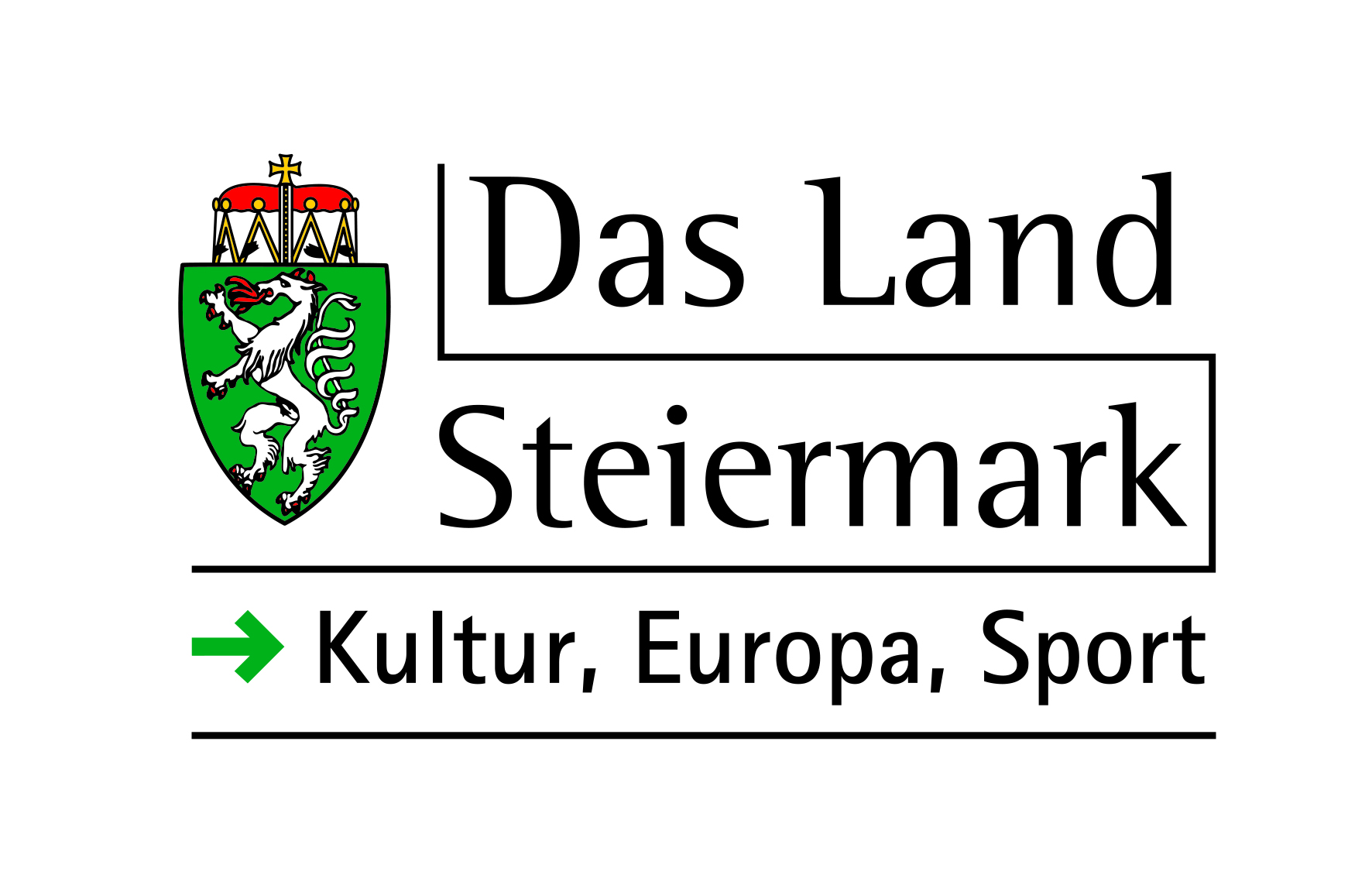







The Metaboliser
Audio-visual Work
David Pirrò
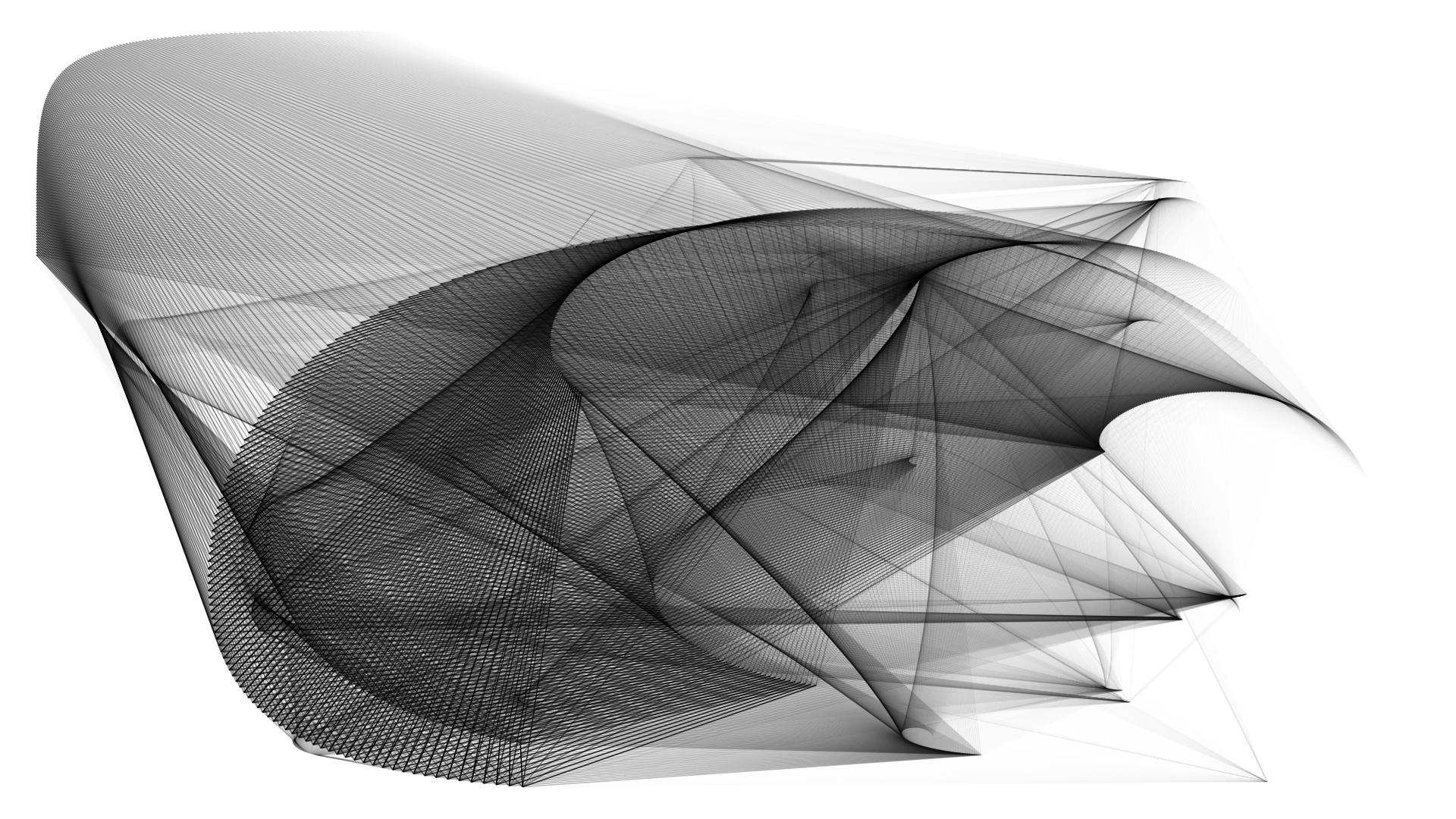
The Metaboliser on the Researchcatalogue
The Metaboliser is an artistic audio-visual work whose development was triggered by a reaction towards a certain way of conceiving of and operating computers common in many branches of digital arts. A conception which relegates these machines to the role of mere accomplishment of a predefined task, mostly that of generating a perceptible audio or visual form for some kind of data or of the ideas of the artists. That is, computers are considered as a means for finding a solution to a problem of representation of something external.
…
The Metaboliser is an artistic work that embodies the ideas of networks and entanglement in different ways. It is a computational artefact that does not have a given solution to achieve: once it is started, it is a potentially endless process. Its temporal evolution is its primary sensible dimension: that is, rather than resulting in some static object which could be experienced as a singular object, the metaboliser continuously produces changing visual and auditory forms that cannot be extracted from their temporal sequence: a “snapshot” of its evolution cannot be extracted from the interconnection of its past and its future. The experience of the unfolding and development of its behaviour, the particular way in which subsequent states relate to each other, this is the mode of perception the work addresses.
…
This work originated within the artistic research project Transpositions.
the K of X
Image
Appears in the Catalogue "the Book of X", 2022
The X stands for a place of interaction. Along its edges, a process of mutual interference, of irreversible entanglement takes place. Through the X differences meet and touch: they will never be the same. Through the X the one materializes weaving itself into the other.
Inside the X, the liminal space between, patterns emerge from noise. Paths branch off, rejoin, and spiral: they lose direc- tion in a labyrinth of choices with unforeseeable yet certain con- sequences.
Synchronization patterns of a two-dimensional lattice of coupled oscillators. Each oscillator interacts with the four near- est neighbours placed at the vertices of an X.
http://bookof.xcoax.org/thebookofx.pdf
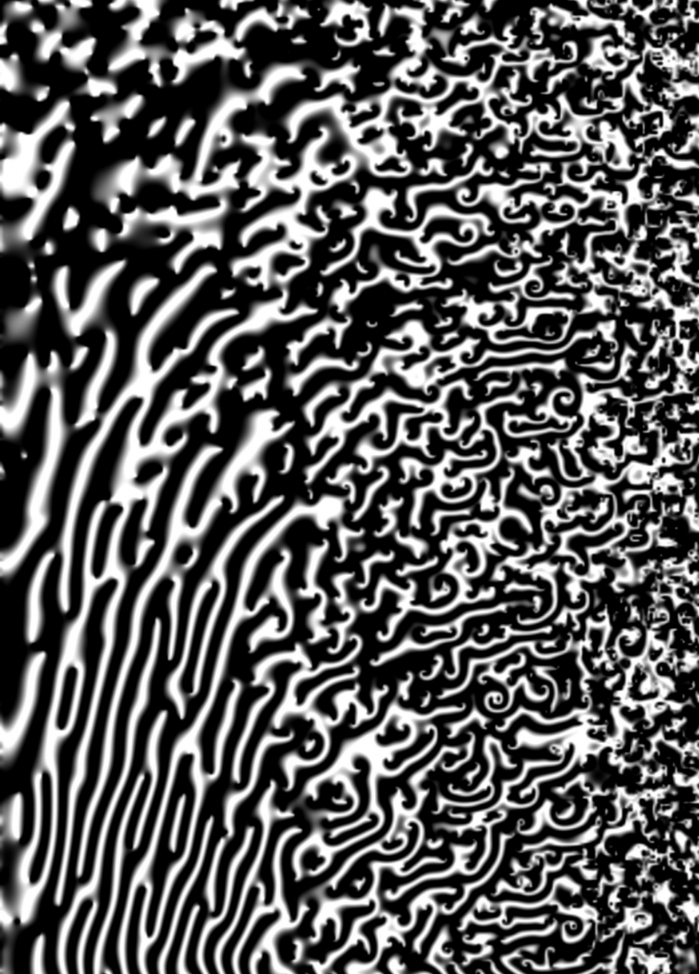
Space is Algorithm
Experimental Text
David Pirrò
Contribution to Spatial Experiments in MAST edited by Castillo-Rutz, Nayarí and Hederer, Franziska, appeared 2021

ARIGA - Artistic Research in Generative Arts
David Pirrò & Luc Döbereiner

The Special Interest Group on Artistic Research in Generative Art, founded 2021, (ARIGA) addresses artistic research that focuses on the computational, the algorithmic, and the generative. ARIGA offers a context for artistic practices that create processes whose performance results in the work of art: such performances may or may not be influenced by external factors or agents (the audience, human performers, data, light, the weather etc.). We refer to practices that set the conditions for a work of art to emerge based on the temporal and unforeseeable interaction of an ensemble of agents, objects or rules. ARIGA gathers artist researchers working in diverse media, including space, sound, image, video, sculpture, and language.
The group addresses practices that engage in an interaction with computational artifacts that suspend preconceived functioning — tools or instruments to achieve something — and rather embrace the mutual evolution of technology and artistic thought. It further advocates for a stance towards the computational as a non-atomic and actor integrated in a mesh of irreducible interrelations, as part of an ecology in which technological, historical, social, scientific aspects interact. ARIGA critically addresses fundamental questions common to diverse practices and approaches relating to notation, the textuality of source code, the role of procedures, computation and automation in creative processes, the materiality of algorithms, machine agency, and data as material. Moreover, we seek to provide a context for the critical and speculative artistic exploration of web technologies and their potential to connect and relate people, places, spaces, time scales, data and algorithms.
ARIGA seeks to establish a framework and network for existing communities of artistic researchers working with computational material. ARIGA aims to create a context for exchange, collaboration, publication, and discourse for artists and researchers in experimental generative art. We deem such a platform particularly relevant due to the increasing digitization of our lives, post-covid remote presence mediated by networks of computational agents, and the ubiquity of AI and machine learning in everyday life and the arts. ARIGA provides a space for critical and artistic reflection on these realities.
ARIGA has been proposed and conceived by David Pirrò and Luc Döbereiner. We aim to form a larger group of core organizing members representing a more diverse group of artistic disciplines and practices.
We propose to establish a regularly appearing peer-reviewed online publication medium (e.g. "Journal for Generative Art", working title) hosted on the Research Catalogue, either autonomously or as part of an already established journal. In doing so, we aim to actively feed into the further development of the Research Catalogue by gathering creative coding practices and expertise. In this way, ARIGA aims to foster the development of genuinely generative and computational presentation and publication formats. In addition, we propose to contribute to SAR conferences with panels, presentations, and workshops centered around artistic research in generative art.
The ARIGA Special Interest Group is supported by the University of Music and Performing Arts Graz.
ARIGA introduction on the Researchcatalogue
Link to the ARIGA Portal on the researchcatalogue
Link to the ARIGA channel on youtube hosting the recording of the ARIGA sessions. In each session group's members present their work in Generative Arts
The Special Interest Group on Artistic Research in Generative Art has been closed in 2023
Computational Studies of Entanglement
Piece
Computational Studies of Entanglement
The piece is part of a series exploring the temporal behaviour of systems composed of interacting elements. Of particular interest are the temporal and spatial structures appearing and vanishing in the synchronisation processes between mutually influencing, or entangled, entities.
Appears in the CD Segmod by DUMPF EDITION
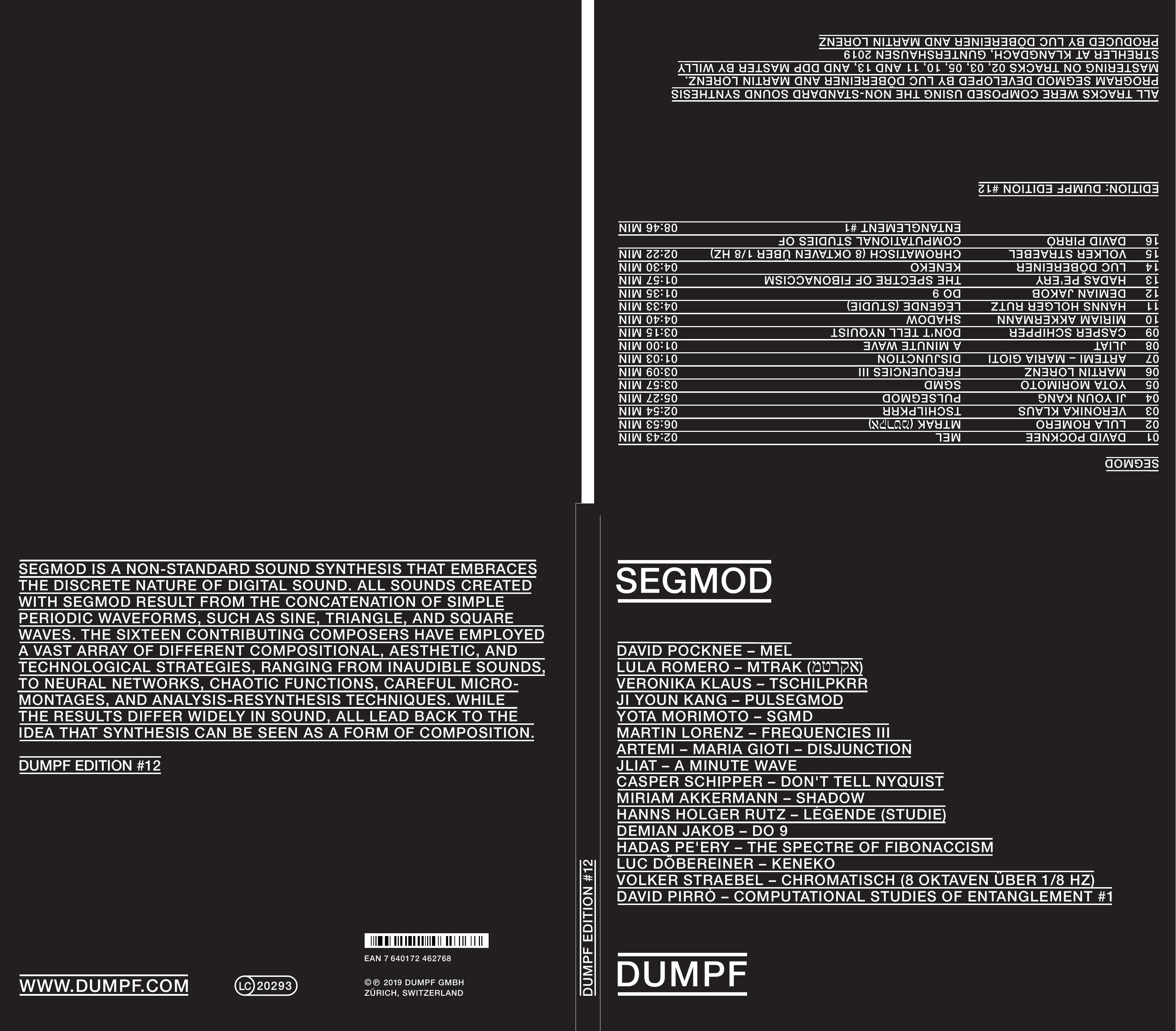
TODO Online installations
TODO Contingency & Synchronization
TODO ARIGA SAR presentation
TODO Metabolizer perfs
TODO Algorithmic segments + catalogue
TODO Presentation in Barcelona
TODO segmod
CD